Everything You Need to Know About Taking the Train in France
Enzojz/Getty Images
- Getting Around
- Types of Trains

International Train Services
- How to Buy Tickets
- Tips for Taking the Train
France is the largest country in western Europe, so train travel makes sense. Happily, France has a fast and efficient train system, and the French government has invested massively in high-speed trains (the TGV train or Train a Grande Vitesse ) and high-speed lines (LGV or Ligne a Grande Vitesse) .
There are over 1,056 miles of dedicated high-speed lines and thousands more main lines and smaller lines, so almost everywhere is accessible by train travel in France.
The French rail network links all the major towns and links up many small towns in rural France. With careful planning, you can get around just using train travel during your vacation. Generally, the trains are on time, comfortable and relatively cheap.
However, some trains run only at certain times on certain days, so you need meticulous planning if you are traveling in rural France by train.
Getting Around France From Paris
Like many capital cities, Paris suffers from having no central railway hub, but a number of mainline termini. Here are some of the main destinations served from the main stations .
- Gare du Nord: Northeast France, London (Eurostar) , Brussels, Amsterdam (Thalys), Lille, Valenciennes, Calais
- Gare de l'Est: Nancy, Metz, Reims , Strasbourg , Germany, Luxembourg
- Gare de Lyon: Lyon , Dijon, Besançon, Geneva, Mulhouse, Zurich, Clermont-Ferrand, Marseille , Nice , Nimes, Montpellier , Perpignan; Italy and the east of Spain
- Gare d'Austerlitz: Tours, Poitiers, Limoges, Bordeaux , Toulouse , Biarritz, western Spain
- Gare Montparnasse: All western TGVs, Brittany , Brest, Rennes, Nantes
- Gare St. Lazare: Caen , Cherbourg, Rouen , Le Havre
Types of Trains in France
All types of trains run in France, from the special TGV and other high-speed trains to smaller branch lines. While some lines are operating old carriages, most of the trains are now comfortable, modern, and have high-tech additions like WiFi. Many have massive picture windows along the sides; others have an upper deck that gives you a fantastic view of the French countryside you are powering through.
The main types of trains in France are:
- The TGV Train network ( Train a Grande Vitesse ) runs to major cities in France and Europe.
- Intercites trains cover many of the medium distance routes between cities like Amiens, Orleans, Bordeaux, Caen, Lyon, Reims, Troyes, Toulouse, and Paris. They link cities in French regions like Nantes, Bordeaux, and Lyons-Nantes-Tours.
- TER is the French regional service running from towns and villages over 21 regional networks in France.
- AutoTrain sleeper service runs from Paris Bercy Station down to the south of France, taking you and your car.
Other national rail carriers use TGV train technology in Europe:
- TGV Lyria trains run through France into Switzerland
- Eurostar runs between the UK, Lille, Paris, and Brussels
- Thalys trains run to Belgium, the Netherlands, and Germany
How and Where to Buy Tickets
Like most countries, ticket prices vary widely. If you can book early, you will get good bargains, but you may have to stick to a specific time. If you book that and miss the train, you may not get reimbursed.
Ticket prices are no higher on a TGV or express train than on a local line. And to compete with the low-cost airlines, TGV trains offer reasonable prices for early bookings and for the less popular times of trains. Internet booking is always a good idea.
All French train tickets can also be ordered online, and you can then print them out on your computer as an e-ticket, exactly as the airlines do.
Visitors from the USA can buy online with Rail Europe , and visitors from the U.K. can buy online with Voyages sncf (formerly Rail Europe UK).
Tips for Taking the Train in France
- Arrive early to find out which platform the train goes from. Paris train stations can be quite confusing.
- There might not be good refreshments on the train; check in advance and, if necessary, buy your own snacks/light lunches at the station.
- You will have to validate your ticket. Look for the yellow machines ( ‘compostage de billets’ ) usually just before reaching the platform. Insert your tickets into the slot and retrieve them. Ticket inspectors will check your ticket on the train, and if it is not validated will probably find you.
How to Travel From Zurich to Paris by Train, Bus, Car, and Plane
How to Travel from Paris to Aix-en-Provence by Train, Car, Bus, and Plane
How to Ride the High-Speed TGV Trains in France
How to Travel From Paris to Strasbourg by Train, Bus, Car, and Plane
One Week in France: The Ultimate Itinerary
Guide to Major Train Stations in Paris
How to Travel from Frankfurt to Paris by Train, Bus, Car, and Plane
How to Travel From Paris to Montpellier
Traveling to Arles by Train, Plane, and Car
Getting Around Paris: Guide to Public Transportation
France Railways Map and French Train Travel Information
How to Travel from Paris to Colmar by Train, Bus, Car, and Plane
How to Navigate Paris Train Stations and Transfers
How to Travel from Paris to Toulon by Train, Bus, Car, and Plane
How to Get to France From Barcelona and Other Spanish Cities
How to Travel from London to Marseille by Train, Bus, Car, and Plane
Travel Europe on a Budget
The Savvy Backpacker
City Guides .\33 a132798-3f3b-4585-954d-7e70cf863447{fill:#231f20}
France train guide — how to travel france by train.
How to travel France by train—tips for buying French train tickets and advice for navigating France by rail.
Transportation
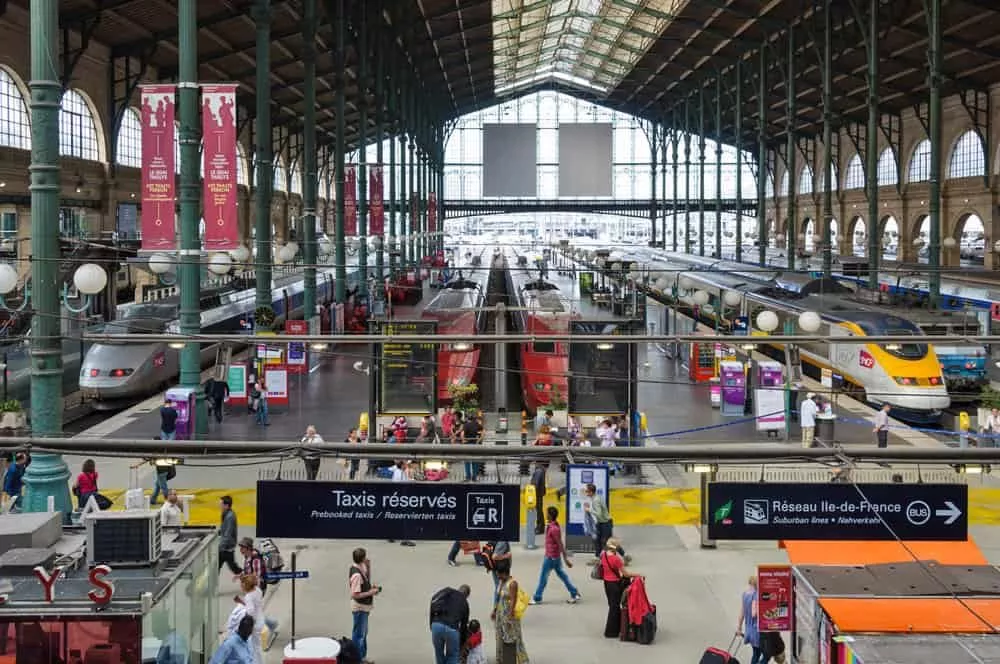
It doesn’t get much better than zooming through the French countryside at 200mph. In fact, when it comes to train travel, France is one of the best-connected countries in Europe and you can easily reach many of Europe’s great cities from Paris.
But, like all things French, their rail network can be a little confusing so we’re here to help. In this France Train Guide, we’ll tell you everything you need to know about traveling France by train—from navigating the system to buying train tickets for the cheapest price.
How To Buy Train Tickets in France
Buying French train tickets is generally easy but there are a few quirks that you’ll come across when booking—keep reading and we’ll walk you through the process.
Let’s first take a look at where and when to buy tickets for the best price…
Quick Note On Electronic Train Tickets And Reliable Mobile Data
Most train tickets in France (and Europe) are electronic so having reliable high-speed data for your phone is important—luckily, getting high-speed data in France is simple and affordable. Here are a few articles I’ve written to help you get set up:
- Guide To Mobile Data Plans and Smartphone Phones in Europe
- How To Buy A SIM Card and Mobile Data Plans in Europe
- Guide To Buying SIM Cards and Mobile Data Plans in France
Where To Buy France Train Tickets For France
So there are a handful of websites/methods for buying French train tickets and each has its own quirks. Let’s take a look at the various options:
Omio is a search engine that lets you compare and book trains anywhere in Europe. It lets you easily book tickets with your credit card at essentially the same prices as France’s Railways website.
Additionally, Omio searches routes for multiple rail services across Europe so it’s great for international trips (since it can easily combine rail journeys of multiple countries). Omio also gives you the option to print your own tickets or have eTickets sent to the Omio App.
TrainLine is another third-party booking site that connects directly to the French National Rail Network and other European networks. Trainline also accepts international credit card payments and lets you print your own tickets or have eTickets sent to the Tranline App.
SNCF (National French Railways)
The website for the official French Railways is en.oui.sncf . The main problem with this site is that it often tries to redirect you to RailEurope.com—which is SNCF’s official North American partner. Unfortunately, Rail Europe rarely finds the cheapest fares so you have to actively try to keep the site from redirecting you. And trying to book through the official SNCF website can be equally as difficult because it can be plagued with translation issues and sometimes they reject foreign credit cards.
Perosanlly, I’d stick with Omio .
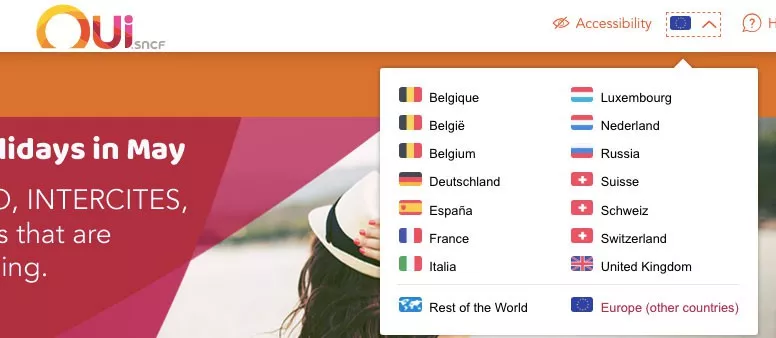
A few years ago the French National Railways created a new low-budget train line called Ouigo . It basically connects Paris with a handful of popular French destinations.
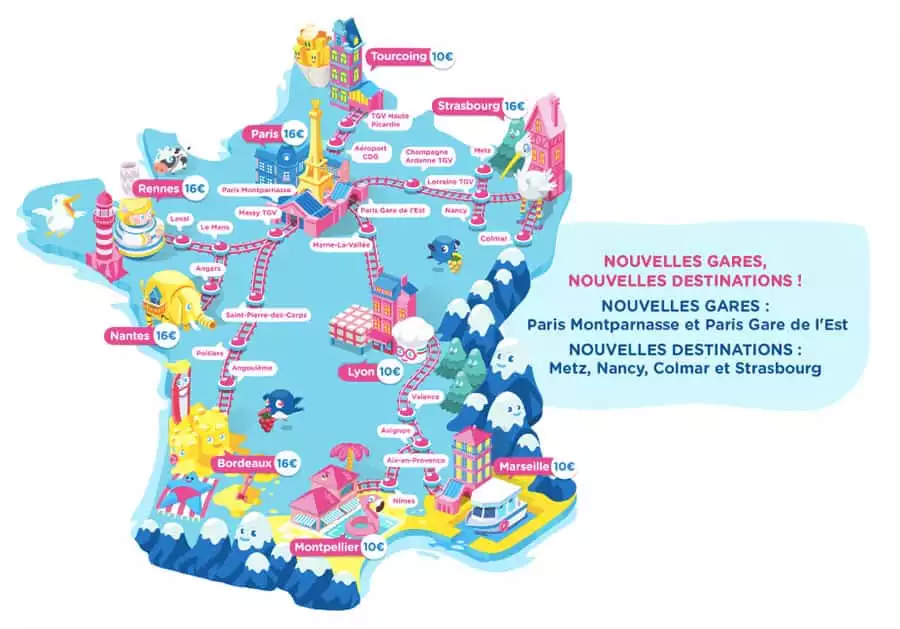
Some Ouigo trains leave from stations outside Paris so it takes a little under an hour by regional train to get there from central Paris. However, some trains do leave from central Paris. There are a few other restrictions (like limited luggage) but the fares can be crazy cheap. Booking websites like Omio will include Ouigo in their results so you don’t have to search Ouigo’s website to find/buy its tickets.
The Eurostar is the train that connects Paris and London. You can usually book this journey on other websites but we’ve found it best to book directly from the Eurostar site for the best prices.
At The Station
Of course, you can buy any French train ticket from any train station — either from a ticket window or an automated machine (you’ll need a Chip & PIN credit card to buy from the machines). You can buy tickets in advance from train stations as well.
HOW TO COLLECT YOUR FRENCH TRAIN TICKETS
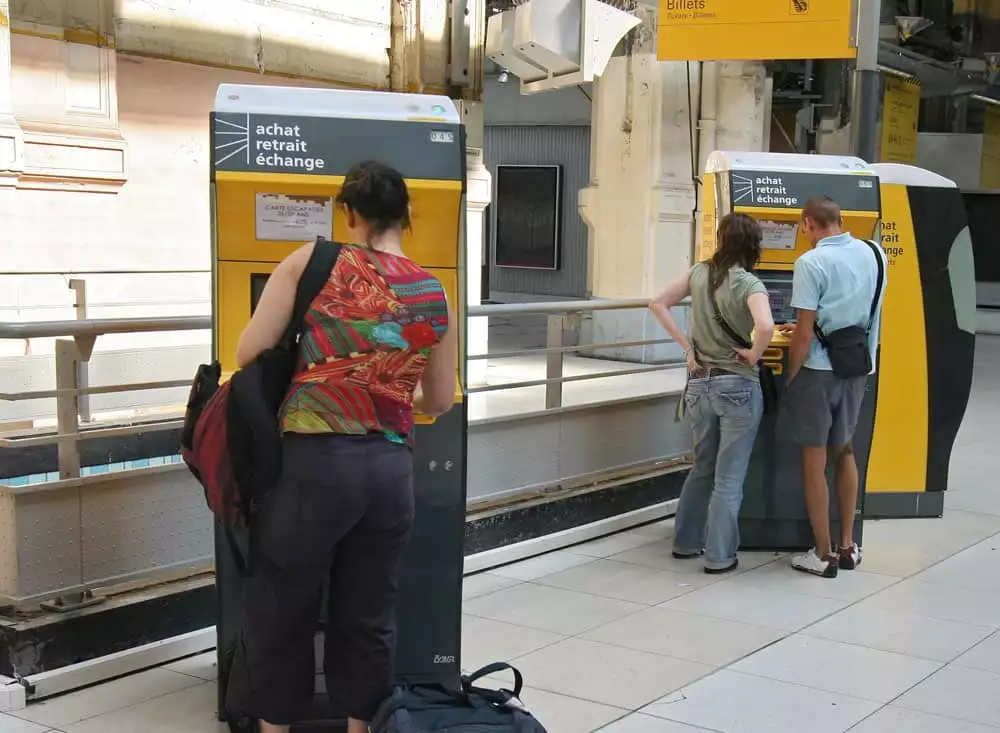
Tickets purchased online can be collected in a few different ways. Most times you’re given multiple methods of collecting your tickets:
- Electronic Tickets: You can usually have tickets sent to your phone/tablet. For example, tickets bought via Omio will be sent to your Omio app. You can also have tickets sent to your email. Then you simply show it to the conductor on the train when they check your tickets.
- Print-At-Home Tickets: You can print tickets at home and show them to the conductor on the train when he checks tickets.
- Also, you’ll need a Chip & PIN card to collect from the automated machines but you can use a swipe card at the ticket window. However, at other times you only need the booking reference number.
- Mailed Tickets: Some services will mail you physical tickets but this is often a slow process. We suggest avoiding this and sticking to the other options.
Do You Need To Buy French Train Tickets In Advance?
France has a number of different train services so it can be a little confusing to know what tickets should be purchased early and which can be bought whenever. We’ll break it down below.
High-Speed TGV Trains — Buy Early As Possible

Yes – book early. Tickets for France’s TGV high-speed trains are available to purchase around 90 days in advance. Booking these early will get you the cheapest tickets and prices will generally continue to rise as the departure date approaches. For example, a day-of ticket can cost well over €100 but that same one bought weeks early might only cost €30.
International Trains — Buy Early As Possible

There are a few separate train services that connect France to other countries. These are high-speed trains so the same rules about booking early apply to these tickets as well.
- TGV Lyria: High-speed trains that connect France and Switzerland.
- THALYS: High-speed trains that connect Paris with Belgium, Germany and the Netherlands.
- Inter-City Express (ICE): High-speed trains that connect France and Germany.
- Eurostar: High-speed trains that connect Paris and London.
Intercité Trains (IC) — Buy A Little Early

Intercité trains are fast trains but not as quick as the TGV trains. They usually also connect shorter distances and the trains aren’t quite as nice as the TGV. These tickets can also be purchased in advance for a discount.
Regional/Local Trains — Buy Whenever

France has a number of slow trains that connect suburban and regional areas. TER (regional trains that connect smaller towns with regional hubs), Transilien (connects suburban Paris), and RER (also connects suburban Paris). These tickets are priced by distance traveled so you don’t need to buy them in advance — simply purchase them at the station right before departure.
Don’t forget to validate your ticket before you get on the train or you’ll be fined.
How To Use Your French Train Tickets
On high-speed trains , your ticket is only good for the specific time stated on your ticket. You’ll also be given an assigned seat. You don’t need a validate your ticket because your seat is reserved (but they might check your ID on the train). NOTE: Your ticket will show the car and seat number so make sure you’re in the right car (the trains are clearly marked).
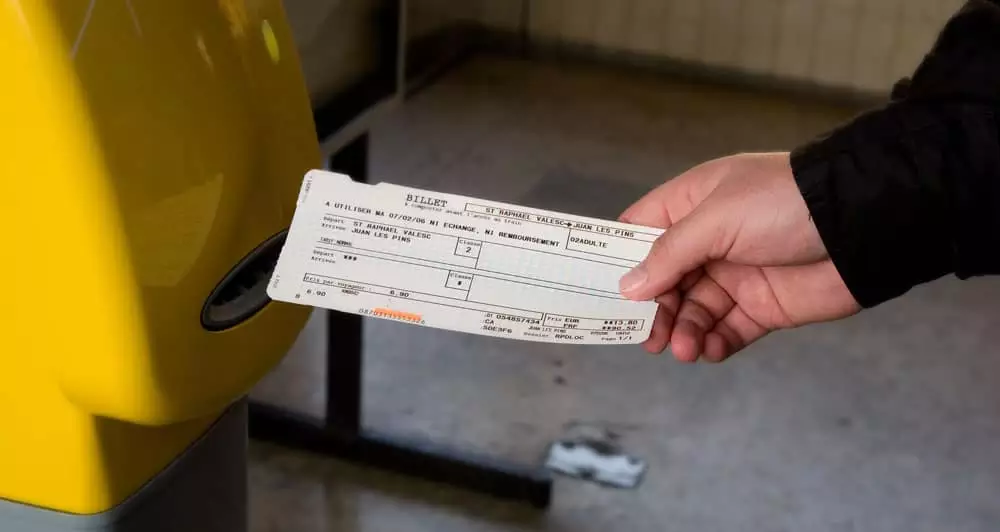
On regional/local trains , you might have a physical ticket. Make sure to validate (i.e. stamp) your ticket in the validation boxes on the platform before you get on the train. They’re sometimes hard to find so watch what the locals are doing. If you forget to validate, seek out the conductor right away and have him stamp it — if you wait until he comes around you might be given a fine.
Regional trains won’t have seat reservations so just sit anywhere.
Once you’re on the train the conductor will eventually walk through the aisles to check tickets.
HOW TO MAKE RAIL PASS RESERVATIONS
High-speed trains require you to make a reservation when using a Eurail pass — the reservation costs €10-€30/seat for domestic travel and international trains can charge anywhere from €35-€89/seat (depending on destination). As you can see, those international train reservations can be wildly expensive — in fact, the reservation fee is often more expensive than buying a separate ticket.
You must make the reservation before you get on the train. There are a few ways to make reservations:

- Make Reservations Online: Omio lets you book your reservation online through their platform. Simply look for a button that says “I Have A Railpass” and follow the prompts.
- Make Reservations At The Train Station: You can simply go to the train station and book your reservation from the customer service desk or self-service kiosks. You can book it weeks in advance or you can do it the day you depart. We suggest using the kiosks because the ticket window can take forever.
More Tips For Riding Trains In France
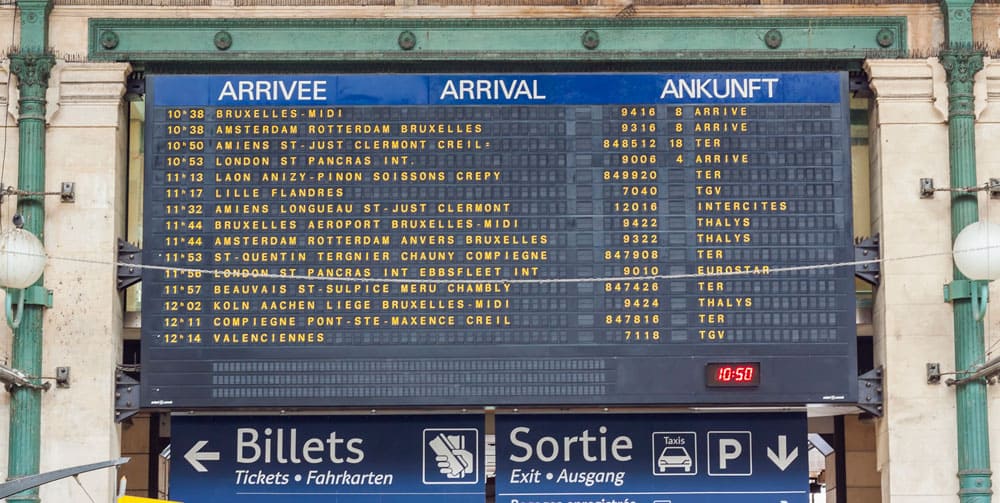
Here are a few general tips about train travel in France.
Study The Departures Board
You’ll find your train platform via the departure board at the train station. Don’t worry if you don’t see your train right away because they often only display trains departing within the next 10-20 minutes.
However, do pay attention as sometimes the platform can change last minute.
Know Train Station Names
Most large cities have multiple train stations (Paris has seven) so this often creates confusion. Double-check to make sure you have the right station—especially when booking your ticket.
Self-Service Machines Are In English
Don’t worry if you don’t speak French because the ticket machines (and train station signs) are all in English. Most customer service workers also speak some English.
Cheap Tickets Are Non-Refundable
One downside to cheap tickets is that they’re non-refundable and can’t be changed.
Pack A Picnic
You’re allowed to bring your own food and alcohol on trains. It’s great for those long train rides.
No Luggage Restrictions
There aren’t any weight limits on luggage and you can bring as much as you want (well, as much as you can carry). Simply bring it on and store it above your head, behind your seat, or in the luggage racks in each car.
Making Connections
Your rail journey might require you to change trains along the route. Don’t worry if there are only a few minutes between trains because switching trains is usually fairly quick and easy—it’s not like flying where you need an hour-long layover.
Get To The Train Station Early
Train stations are usually fairly easy to navigate but they can be a little confusing. There isn’t any security that you have to go through (except for Eurostar and THALYS trains) but it doesn’t hurt to arrive about 20 minutes early.
First Class vs Second Class Tickets
First Class tickets normally cost 1.5x the Second Class rate. Second Class is perfectly comfortable but First Class seats are a bit bigger and it’s quieter. Other than that, there isn’t much more of a difference.
Use A Credit Card With A Chip
Automated ticket kiosks require a card with a Chip & PIN so make sure you know your PIN code.
Rail Strikes
France is well-known for train strikes. They always give ample warning before going on strike and they still run some trains, but it’s something to pay attention to.
Read More Of My Articles On Budget Travel in France

- Paris Travel Guide: Tips For Visiting Paris
- How To Choose The Best Travel Insurance : Travel insurance will help cover those non-refundable train tickets if something goes wrong during your trip.
- Packing List For Europe Travel : Tips on packing light (which makes train travel much easier).
- The Best eSIM Data Plans For France: My guide to the cheapest prepaid eSIM data plans for your trip to France.
- Recent Posts
- The Best Travel Backpacks | In-Depth Buyer’s Guide & Backpack Reviews - April 28, 2024
- Best Prepaid UK eSIM | Data Plan Buyer’s Guide - April 21, 2024
- How to Avoid Pickpockets in Europe — Tips for Outsmarting the Thieves - April 19, 2024

No Funny Business
The Savvy Backpacker is reader-supported. That means when you buy products/services through links on the site, I may earn an affiliate commission—it doesn’t cost you anything extra and it helps support the site.
Thanks For Reading! — James
Questions? Learn more about our Strict Advertising Policy and How To Support Us .
Related Reads
How to purchase train tickets for europe | strategies for buying european train tickets.
Tips on the easiest and cheapest ways to buy train tickets in Europe.
Complete Guide To Train Travel In Europe | How To Travel Europe By Train
Our step-by-step guide to traveling Europe by train.
Italy Train Guide — How To Travel Italy By Train
How to travel Italy by train — tips for buying Italian train tickets and advice for navigating Italy by rail.
How To Buy Train Tickets in France | Guide To Buying French Train Tickets
What you need to know about booking train tickets in France and tips for getting the cheapest prices.
City Guides
Choosing travel insurance, travel packing lists, budget travel newsletter.
The best budget travel tips sent straight to your inbox.
Join My Journey
Europe travel tips, advertising & privacy policies.
TheSavvyBackpacker.com is a participant in the Amazon Services LLC Associates Program, an affiliate advertising program designed to provide a means for sites to earn advertising fees by advertising and linking to amazon.com.
© 2010 - 2024 The Savvy Backpacker
Website Design by FHOKE
Get my newsletter plus a FREE guide of DOs & DON'Ts for tourists!
Oui In France
Ultimate guide to train travel in France (plus where to buy tickets so you don’t get scammed!)
France · travel
As an American, when I think about taking a trip somewhere, I first think of flying or driving to my destination. But in France, train travel is actually one of the most popular ways to get from point A to B.
Whether you’re a commuter or looking to go on vacation, France’s railway system is a well-connected and efficient way to travel around France and to other destinations in Europe. Before considering train travel in France, keep reading to learn what you need to know before you go (and where to buy France train tickets)!
Quick guide to train travel in France
Other than commuting to work back in the US, I didn’t have much experience traveling by train. That all changed when I moved to France. From short regional trips to much longer journeys, traveling by train has a lot going for it.
Let’s get into what you need to know before you buy a train ticket in France.
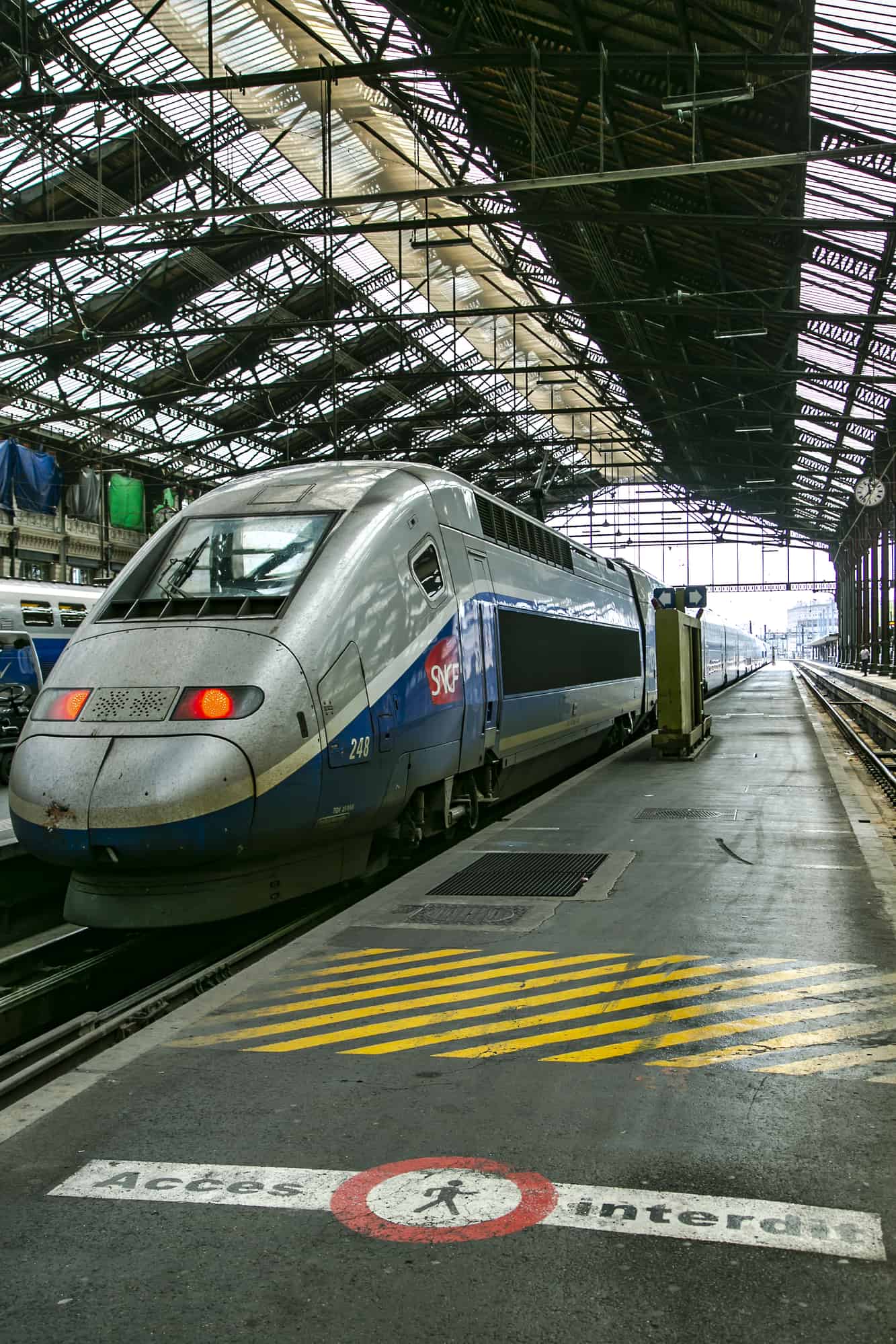
Photo credit: www.depositphotos.com/ursula1964
Table of Contents
Train travel destinations from France
France’s national state-owned railway company is called the SNCF, which stands for Société Nationale des Chemins de Fer Français. The SNCF was founded in 1938, and runs all rail traffic nationwide as well as in Monaco. This also includes TGV (Train à Grande Vitesse) service, the high-speed rail network. France has 27,483 kilometers of railway lines (only second to Germany) making train travel in France a popular option. (via Statista as of 2019).
All of France’s big cities are accessible via train, with Paris being a major hub. In Paris alone, there are six train stations that will get you to other areas of France and Europe: Gare du Nord, Gare de l’Est, Gare de Lyon, Gare d’Austerlitz, Gare Montparnasse, and Gare Saint-Lazare.
In addition to big cities, you can take the train to smaller towns and even more rural areas. Train travel is great for weekend trips from Paris as well. If you’re looking to travel to other areas of Europe via train, you’ve got options. Travel to London, Brussels, Amsterdam and more via SNCF service!
Must-know tips for your first trip to France >>
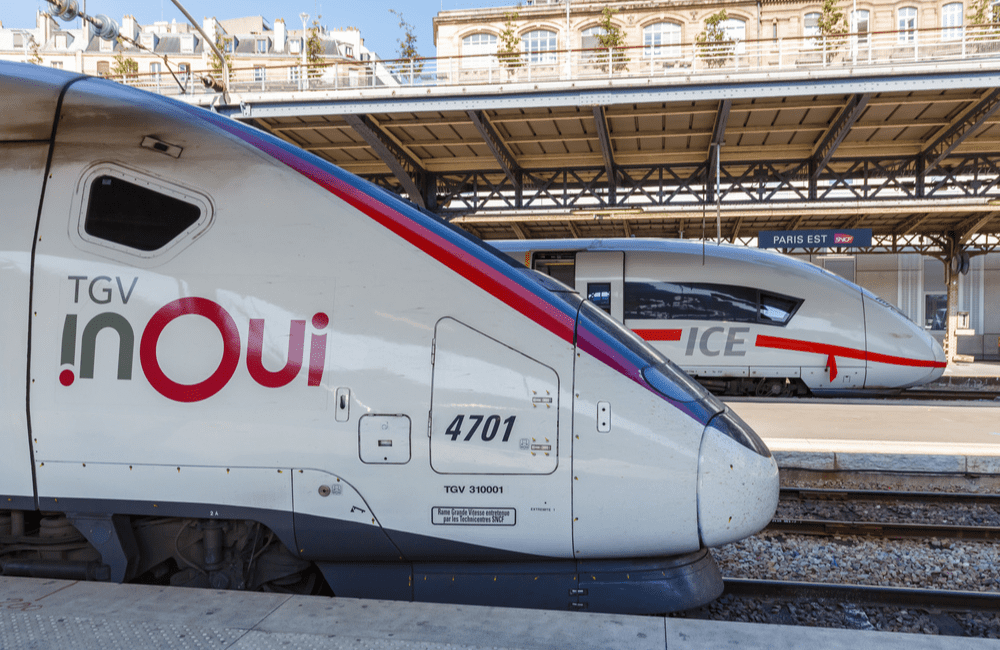
Photo credit: www.depositphotos.com/Boarding2Now
Types of trains and service in France
Train service in France runs like a well-oiled machine with a wide variety of routes nationwide that include big cities, small towns, and even rural areas. As of 2019, the entire SNCF network has over 27,000 kilometers of railway lines, 58% of which were electrified. Over 15,000 commercial trains run daily, transporting more than 5 million passengers and more than 250,000 tons of goods, reported the SNCF.
Let’s talk about the different types of passenger trains available:
TGV INOUI : The TGV is France’s most well-known train, which stands for Train à Grand Vitesse which translates to high-speed train. They can hit speeds of up to 300 km/h (186 mph). The TGV services 200 destinations and has been operating since 1981. TGV Europe also services destinations in Germany, Italy, Spain, Luxembourg, and Belgium. The TGV is the train you take when you want to get from point A to B as quickly as possible.
TGV Lyria : High-speed service that connects France to destinations in Switzerland.
OUIGO: OUIGO is all about low-cost train fares on the TGV. Be sure to book early to score these offers! Small pets travel for free, a piece of luggage is included in the fare, and they’re a steal if your destination is one of the 41 they service. Kids 0-11 years old travel for 5€ one way.
One drawback of OUIGO service is that you have to arrive 30 minutes in advance so staff can check tickets. In addition, extra luggage and seats with a power outlet cost extra and there’s no dining car. Seats tend to be a bit smaller and less comfortable, so take all of that into consideration. None of these were dealbreakers for me when I’ve taken OUIGO trains, though they may be for some people.
As of April 2022, the SNCF launched the OUIGO Train Classique. It is a slower service debuting between Paris and Lyon and Paris and Nantes. The fares are between 10 and 30 euros each way (5€ for kids) and are a great budget-friendly option for those of us who don’t mind a longer trip. The fares are fixed – even for last-minute travel. Note that these fares are only sold online.
INTERCITÉS : Services 150 French destinations, some of which don’t require reservations in advance. They also offer overnight trains on some routes.
TER: France’s regional trains that operate in 11 regions and also connect to the main lines. These are not high-speed trains.
Thalys: High-speed service to Cologne, Amsterdam, and Brussels.
Eurostar : High-speed service to London from Paris, Lille, or Brussels.
Transilien and public transport in the Paris region: This includes the Paris metro and RER trains, bus lines, and more (operated by the RATP). Transilien refers to commuter service in the Paris area.
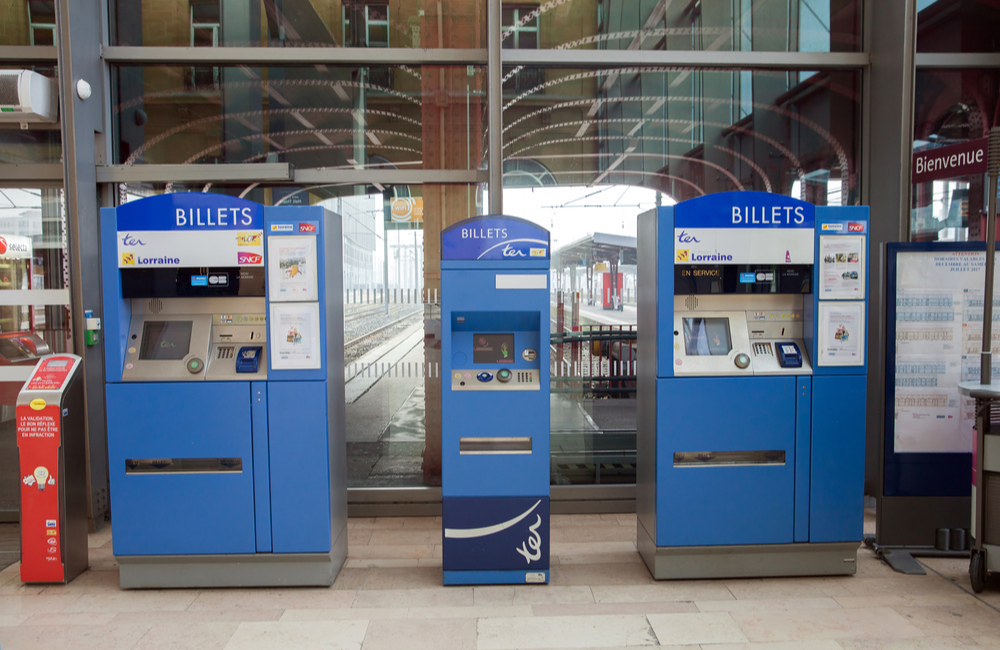
Photo credit: www.depositphotos.com/anrymoscow
Where to buy train tickets in France
You have a couple of options for how to book train tickets in France. You can buy them in person at any train station either at the automated machine terminals or face to face at the ticket window. If you go the ticket window route, take note that they are generally open during French business hours and not 24/7.
Also be aware that there are different types of ticket machines. Some are only for TER train tickets in France, as shown above, and others are for TGV tickets, etc.
Your other option for where to buy train tickets in France is to do so online. This is the only option for many of us if we’re not currently in France. It’s so important to buy from the French SNCF directly to avoid fees and extra hassle. If you do a quick web search for, “How to book train tickets in France,” the official site is often not the first one that comes up and I’ve heard from many of my readers how they’ve been ripped off.
As I mentioned, France’s railway network is called SNCF and the official website/app to buy train tickets is now called SNCF Connect (formerly known as OUI.sncf). The new site has easier route mapping, integrated commuter support and so much more that makes planning a trip a breeze. It’s also available in English.
You can buy tickets for all the types of transport listed above from your computer or phone via their website or the app. You then have the option of printing out a paper ticket or saving the digital version to your phone. The direct website for French train tickets:

There are also other sites called Rail Europe and others geared toward English-speaking foreigners where you can buy France train tickets. They are third-party resellers that are not official sites. Prices are often elevated, so I don’t recommend ever using them. Always go the official route. It’s the best way to buy train tickets in France.
On SNCF Connect , in addition to actually buying/exchanging your France train tickets, you can also plan your trip, find the best door-to-door route, get traffic updates and alerts in real time and buy and renew regional cards and passes. You can also access bus lines and ride sharing offers.
If you travel frequently, are a student, or a senior citizen, it may be cost effective to look into special train passes, so see if you qualify to save a few bucks.
Just like with flights, train ticket prices in France fluctuate as well. You can usually get a much better deal well in advance, while last-minute tickets are usually the most expensive.
BIGGEST MISTAKES tourists make in Paris >>
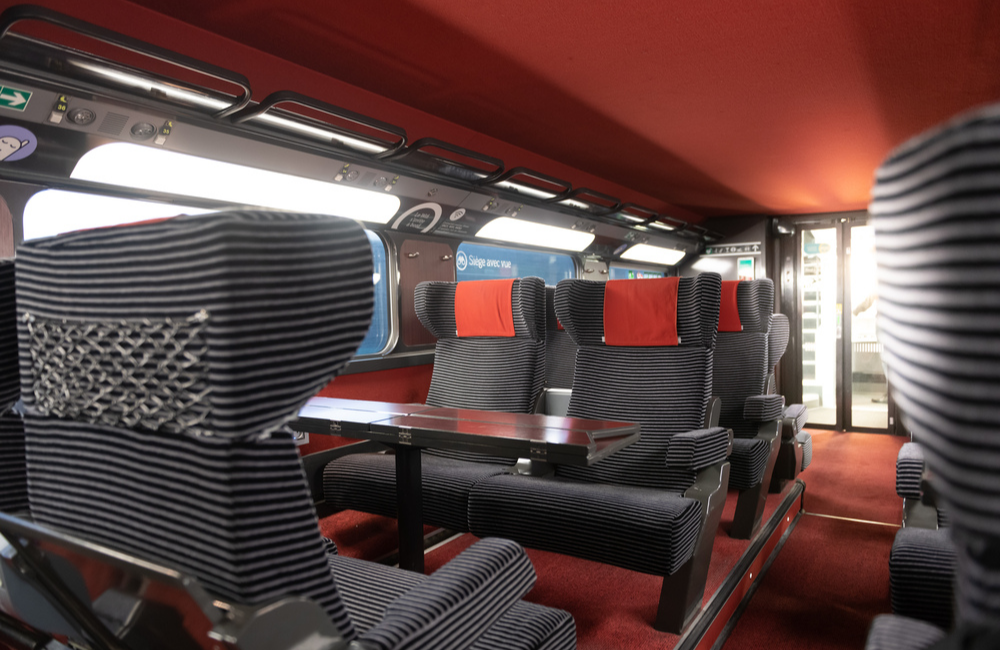
Empty first class TGV seats. Photo credit: www.depositphotos.com/Pixavril
Expert tips for train travel in France
1. Buy tickets early for the best price and availability. If you’re looking to travel by train and know your plans well in advance, it pays to buy the tickets well in advance. You’ll get the best price. Another reason why you’ll want to book early whenever possible is because trains in France sell out since all seating is reserved.
This can be especially true during the peak summer months, during school vacation periods, and on popular routes. As I recommended above, be sure to only use the official site SNCF Connect for the most accurate information and cost-effective tickets.
2. Book a seat that makes sense for you. All TGV seating is reserved. TGVs and longer trips require you to book a specific seat and there are different configurations. Most are two by two and you have the choice of an aisle or window seat. There are also “family” seats called carré (square) which are 4 seats in a two-by-two configuration but facing each other with a table in between (imagine sitting at a 4-person dinner table).
That means two are riding backwards. It can be a little awkward facing a stranger the whole ride. Also, riding backwards isn’t always comfortable for people prone to motion sickness, so pay close attention to what seat you’re choosing.
In addition, some trains are double deckers and have an upstairs level accessible by a staircase. If you have several pieces of luggage or aren’t able to easily climb stairs, upstairs may not be the best option. The booking system will assign you a seat that is easily changed before finalizing your reservation, so again just be sure you’re comfortable with the seat you’re selecting.
3. Consider first class. Along with the above, it might make sense to book a ticket in first class. Sometimes they’re only slightly more expensive than regular second class fares, especially when booked in advance. For more comfortable seats with a little more leg room, more luggage storage, a plug for electronics, and more, first class might be a good choice for business travel or long trips where comfort is important.
Overall, I’ve found that first class seats on the TGV aren’t that different from second class so they aren’t worth a splurge if the difference in fare classes is steep.
4. Show up early. If you’re not used to taking the train in France, be sure to give yourself enough time to navigate the station and get to the right platform and track (called voie in French. You’ll see tracks noted as Voie A, for example).
Paris stations are big and it can be confusing if you’re not used to how things are organized. Spare yourself the added stress that comes along with rushing or having to rebook a missed train and get there on the early side.
5. Note the number of your train car and line up on the platform accordingly. This is a VERY IMPORTANT tip . For trips with reserved seating, it’s imperative that you look closely at your ticket and mentally note the specific train carriage number in which you’ll be seated.
Then find the black display sign on the platform titled “Composition des Trains” that tells you where to stand for your specific car number. It looks like a lit up outline of a train and will usually have a “You are here” dot so you can gauge how far left or right you need to walk to get into position.
TGVs and other international trains can be quite long with 20 or more cars or even two trains that are attached. Because stops are often only a couple of minutes long, you need to be in the vicinity of your assigned seat because you won’t have time to run the length of the platform if you’re near car 4 and yours is actually car 18. This happened to my aunt and uncle in Marseille. They couldn’t get to their train car in time with all their luggage and missed the train.
You can’t just get on and walk between the cars because they aren’t always connected and with the crowds and luggage, it’s not feasible. In some cases, as I mentioned, two separate trains might be connected as they depart Paris but at some point they split and go to different final destinations.
It’s really important you check that you’re in the right seat and in the right car! Definitely take extra care when it comes to lining up ahead of time and then finding your seat once on board.
A final note on the Composition des Trains display sign: There won’t be an employee directing you and it’s not required to line up in any specific place. It’s just that the Composition des Trains display is there for a reason, so be sure to take a look so you aren’t on the opposite side of the platform when the train comes. That way you’ll be in the general vicinity of your assigned seat and won’t have to run.
6. Note the train number. Each train has a specific number so when you look up at the big board or screen in the station that lists out all the departures, you’ll see a train number that corresponds to the destination and time.
Several trains may be going to or coming from the same place so it’s important to know you’re on the train you actually bought a ticket for.
Must-know travel phrases for your France trip (with audio) >>
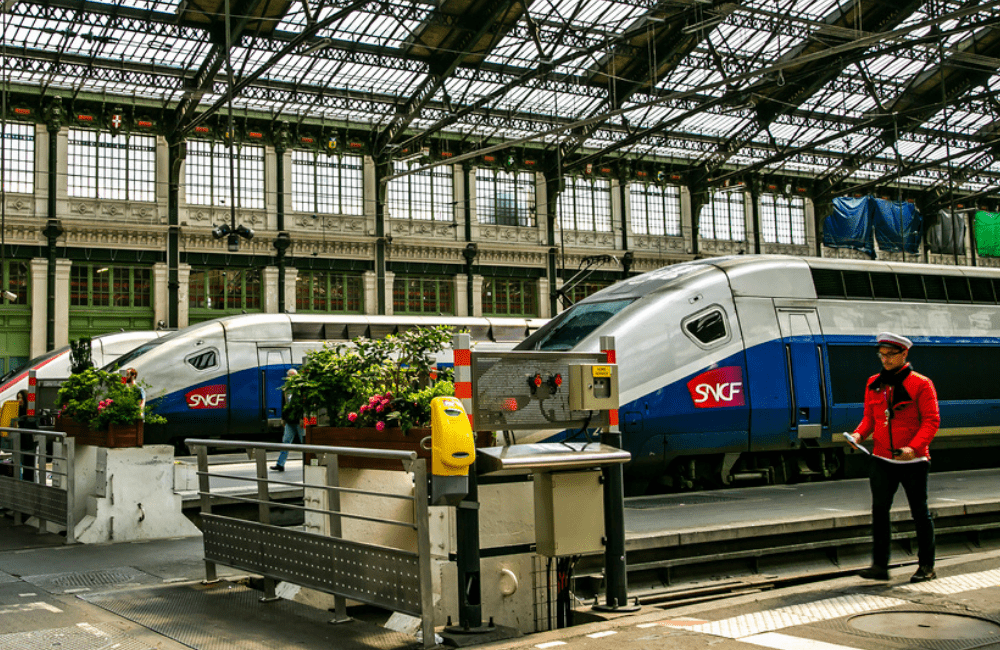
The yellow machine is where you validate your paper ticket prior to boarding. Photo credit: www.depositphotos.com/ursula1964
7. Don’t forget to validate your ticket. All paper tickets for Europe train travel need to be validated before you get on the train in France. To do this, look for the yellow machines with a ticket slot in the train station. There are several usually at the entrance, on the platform, and around the ticket machines and are marked “Compostez votre billet” (validate your ticket).
You insert your ticket into the machine and two seconds later it spits it out with a stamped line of text validating that the ticket is now used. You’ll need to show it to the train employee (contrôleur in French) when he or she checks your ticket after boarding (or in some cases before you board).
Along with that, be sure to have a photo ID with you even for regional trips. In the case of buying your France train ticket online, it’ll be in your name and sometimes they check ID as well. Keep in mind there is no validation process required for e-tickets because they have a special QR code that is scanned directly from your phone. Just the paper ones require the stamp from the yellow machine.
As you’d expect, ID is always checked for TGV and other international trips. Another note on tickets is to always play it safe and buy a train ticket. While the conductor doesn’t always check all tickets, fines are heavy if you try to get a free ride.
Another important tip I should mention is make sure your phone is charged if you have an e-ticket since you’ll need it on and functional to show your ticket.
8. Keep your voice down. Train cars tend to be on the quieter side in France and Europe. People tend to keep their voices low when having private conversations and phone calls are not allowed in some cars. It goes toward respecting the public space and not disturbing those around you. The general attitude for train travel in Europe is to keep your voice down.
American social norms that don’t translate to French cultur e >>
Pros of train travel in France
Easy and efficient way to travel. While France train travel isn’t perfect, it’s a pretty stress-free way to travel. You can easily book your ticket online, arrive at the station, and go. Voilà!
The country is extremely well connected and whether you’re traveling within France or to neighboring European countries, SNCF Connect has you covered. Also, train travel in France doesn’t require you to arrive hours early like air travel does.
Comfortable seats. Compared to regular economy class on most airlines, trains in France are quite comfortable. You have more legroom, big picture windows to take in the view, decent sized bathrooms, and more.
You can head to the bar/food car on some trains where you can buy something to eat or drink. You’re always welcome to bring your own food as well. Many newer trains also have free Wi-Fi.
Lots of options in terms of timing. Most routes have several trains per day (even hourly!) so you have your pick as to whether you leave in the morning or evening or somewhere in between. Train travel is extremely convenient and that’s a top pro.
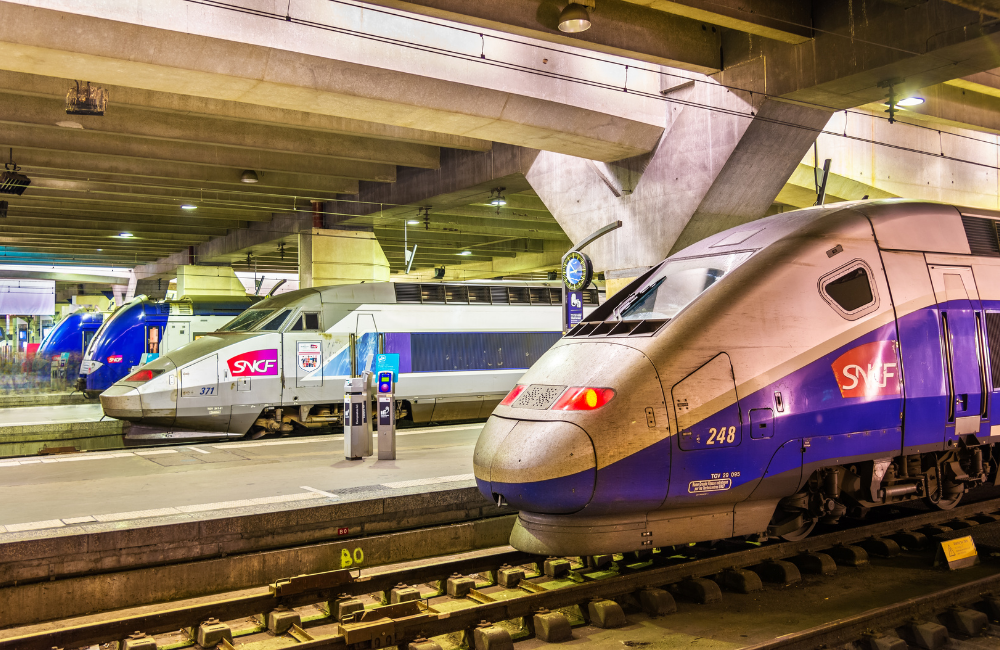
Cons of train travel in France
Possibility of strikes and delays. Like air travel, train travel in France isn’t without its drawbacks. Strikes and delays are not uncommon occurrences. The bright side is strikes are usually announced in advance so you can plan ahead but delays come down to luck.
Weather, technical issues, and more play into whether your trip will be delayed so it just comes with the territory. I take the train regularly and I’m happy to say I’ve only been inconvenienced by strikes and big delays a handful of times in 10 years.
Trips can be long and routing isn’t always direct. If you’re in a rush, train travel may not be for you. TGV and other international high-speed options aside, if you’re trying to get from Angers to Perpignan like I had to when my flight was canceled a couple of years back, be ready for a long day. Routes aren’t always direct and many go through Paris.
In my case I had to change train stations (not just the train!) in Paris which required a taxi. Then my second train was a very slow one that made all the stops. I think the trip was over 8 hours total (flight would have been an hour and 20 minutes).
If you’re in a rush or hate long trips, train travel may not make sense for your specific situation depending on your route.
Not great if you have a lot of luggage. Unlike air travel where you can check large pieces of luggage, when you go by train, you’re responsible for hauling your suitcase(s) onto the train and stowing it in the luggage area. Depending on where you’re seated, this can mean lugging it up or down stairs.
This can be even a bit more challenging on crowded trains when luggage areas are already full. While there aren’t firm luggage limits on regular fare trains, it can get really cumbersome when you have two or three suitcases.
If you are traveling solo and have two or more pieces of luggage, keep in mind that trains only stop for a few minutes so take steps to make the whole on/off process run as smoothly as possible. This includes booking a ticket on the lower level so you can avoid stairs and making sure that you line up on the platform in the area that corresponds to your reserved seat, as we talked about above.
Also, when it’s time to get off, start getting your suitcase out of the luggage area a few minutes before the train arrives in the station. People who got on after you might have boxed your suitcase in so leave yourself time to get organized.
Have you taken a French train? How was the experience? I hope my guide to train travel in France was helpful! Buy your French train tickets and bon voyage!
Traveling to France soon and want to be prepared? Check out my eGuide titled “ 75 Beginner France travel tips for a standout trip! ”
Need some tips on how to dress like a French woman? This is my no BS guide on how to dress in France .
Disclosure: This is a sponsored collaboration between SNCF Connect and Oui In France. All opinions are my own.
PIN my France train tickets and French train travel post:
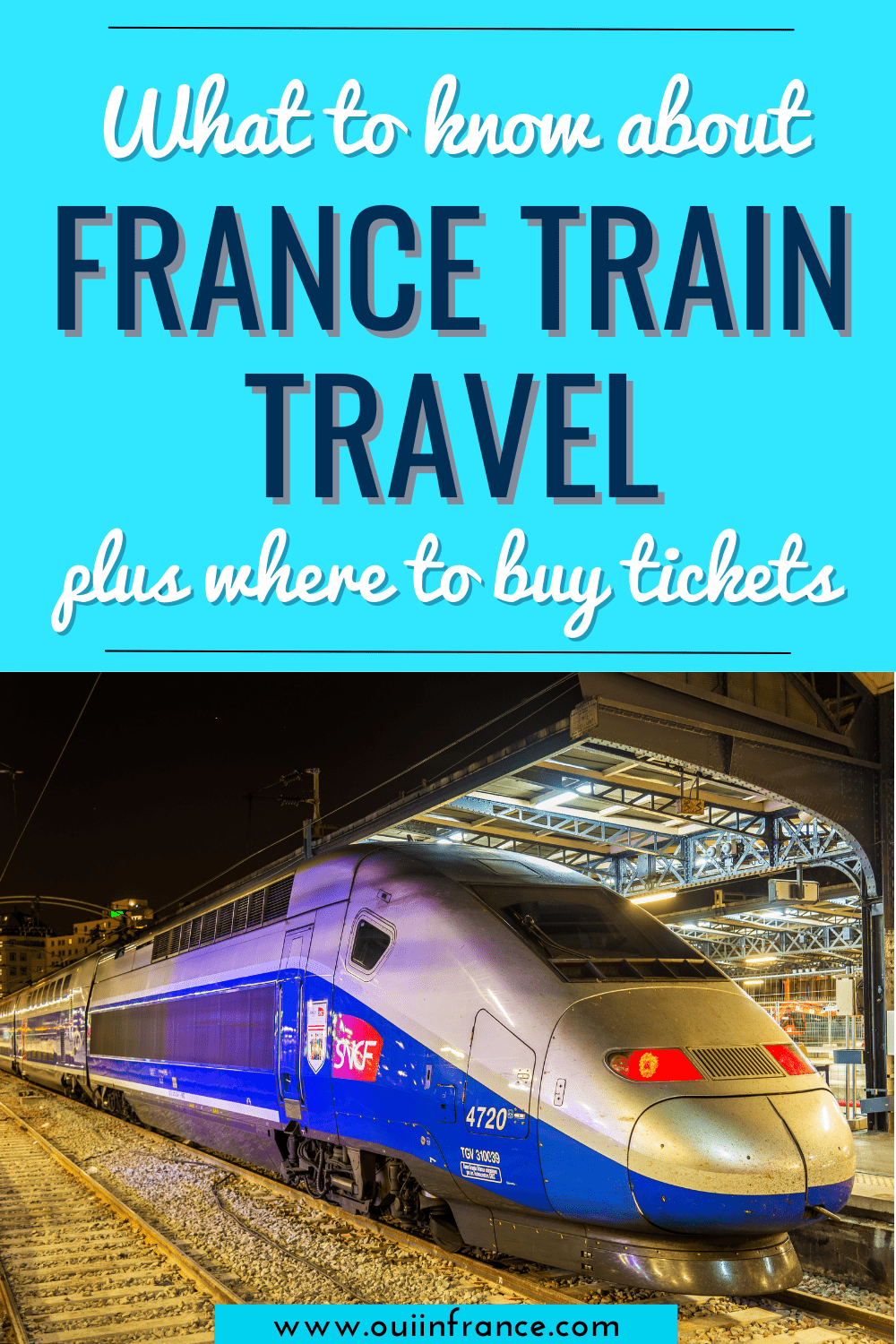
You might like
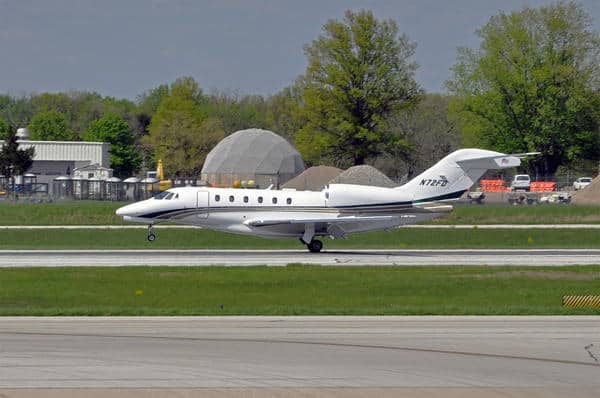
Sign up for the Oui In France Newsletter!
Stay up to date with everything Oui In France! Plus get my FREE GUIDE with 24 DOs & DON'Ts to keep in mind when visiting France!
April 22, 2022 at 5:34 pm
Hey Diane, Great article! Good timing as I’m on a Thalys heading Paris-Amsterdam. I have a question about seats. I did switch seats online when I bought them but I’m stumped as how to make sure I’m not sitting backwards. There’s nothing on the seat map that shows if you’re going the correct direction of train or backwards. Am I missing something? Thanks and be well!
April 23, 2022 at 11:32 am
I’ve been traveling a lot by train in France for the last 2 weeks mostly using the SNCF connect app. The TER tickets I’ve bought with the app are only available on your phone. You can’t print them. The OUIGO and inOui tickets are on the app and sent as PDFs by email so they can be printed if you have access to a printer. The OUIGO tickets can’t be printed at the station if you bought them using the app. The only downside I’ve found is that scanning the tickets is sometimes necessary to get to the platform and it doesn’t always work from the phone. I and a lot of other people had to get assistance from an SNCF employee. That employee was very helpful but only spoke French. Overall I think the app works very well.
If you’re over 60 and book the tickets more than a day in advance you get a 10% discount even without buying a loyalty card.
April 23, 2022 at 2:54 pm
When traveling via TGV, is there a way to tell which end of your car has the luggage racks? We were a group of 7 in December and sometimes boarded on the end opposite the racks. That made life a little challenging! Also, when booking three sets of TGV tickets for 7, I couldn’t get SNCF to register me. It said I had created an account and would receive an email but nothing ever arrived! Therefore, I couldn’t look up my account to see my tickets. Luckily I had the confirmation numbers and could find them that way. A little frustrating. But the train travel itself was wonderful! We did Paris-Reims-Strasbourg-CDG.
April 24, 2022 at 1:48 pm
Hi ! Racks for luggage can be at several places. It depends if your train is TGV, a TER ou another type of train. In TGV (INOUi and OUIGO), racks are most of the time at both end of the seated areas and in the middle of them. You can also slide under your seat your luggage if it’s not too big.
April 23, 2022 at 6:25 pm
Nice article. I always use trains in Europe, as they are faster than using an airplane. I tried to take your advice and tried to sign up for sncfconnect. After entering my credentials, I received an email that says click on Activate my account. Upon doing so, I received
Unauthorized url: https://www.sncf-connect.com/app/en-ww/account/activation , for application: ccl
Upon replying to the email asking for assistance, it was returned as Undeliverable.
Using the Chat feature on the website got me a See our FAQ.
I’ve always used Rail Europe for tickets. While they may be a touch more expensive, at least you can reach a real person if there’s a problem or issue.
April 24, 2022 at 8:40 pm
Now this was really interesting , I love train travel just don’t have a reason to take a train anywhere.
April 29, 2022 at 11:42 pm
Great article. I wished there were more photos of things you talked about. I found it hard to find the right car (several years ago so maybe the signage has changed) and when I asked an employee, he was less than helpful, a bit irritated (it wasn’t because of my French; I’m bilingual). I had a hard time finding the right car. Also is the lining up new? I don’t remember having to line up for my car by a sign. I would love to see that photo. Anyway, great practical advice. And safe travels to you and your family. Looking forward to reading about it when you return
April 30, 2022 at 5:55 am
Hi Jacqueline, thanks so much! Glad you enjoyed it! Sorry for any confusion about the composition du train display. It’s not required that you line up anywhere and there isn’t an employee who will direct people to the right spot on the track. It’s just there to help people get to the right spot more or less so they aren’t on the opposite side of the platform when the train comes (thus increasing the chance of missing their train). It was just my tip to take a peek at the display to get close to the spot where your particular car will come to a stop? Does that make sense? I will update the post with a line clarifying that (and add a pic of the display after I next take the TGV). Thx again & bon week-end !
June 8, 2022 at 6:49 pm
This was an awesome guide to the French trains and systems. I will save it for when we get to go for a few months, maybe next spring. Thanks so much for this and other blogs and videos that you do. They are helpful for us who plan on visiting in the future as well as those there. One question I have is about pets…I think I have read that you can take dogs on the trains except for the TGV high speed. We will have our little 14lb papiillon with us when we travel, so will need to plan accordingly.
July 23, 2022 at 9:54 pm
Thank you for this article, I found it quite useful. Do you happen to know, if I pre-purchase TER tickets on the SNCF Connect app, am I able to retrieve them while offline? Or would a screenshot do the trick? I will not have cellular access while travelling in Europe (just wi-fi at my destination), and I want to be sure that I can show the conductor my ticket when he/she comes around 🙂
Leave a Reply Cancel reply
Your email address will not be published. Required fields are marked *
Notify me of new posts by email.

As an Amazon Associate I earn from qualifying purchases.
The 8 most spectacular train journeys in France

Dec 25, 2023 • 11 min read

Traveling across France by train might be the ideal way to take in its glorious scenery © iandresr / Getty Images
Chugging past rolling hills full of heritage vineyards, cutting through spectacular mountainous backcountry, or zipping along the coastline of the Mediterranean: there’s no better way to experience the beauty and bounty of France than from the window seat of a train.
The superb rail network in la République makes it easy to explore the far corners of this rich, varied country. We’ve chosen the following journeys because they offer scenic beauty, keep up a vintage heritage or are just plain fabulous. All aboard for the best train rides in France!
1. Le Cévenol is the most remote and wild train ride
Clermont-Ferrand to Nîmes; 303km (188 miles)
The savage beauty of the isolated Massif Central opens up on one of France’s oldest train routes – and one of the most challenging to build, given the topography of the Gorges de l’Allier. In the mid-1800s, the technology to blast through granite and basalt mountains didn't yet exist, so in a triumphant feat of engineering, workers used rudimentary techniques to blast out the line’s tunnels. Le Cévenol (also known as La Ligne des Cévennes) opened in 1870 for both passengers and freight, including coal headed to the Rhône region and wine to Paris.
The Cévenol forms part of a longer, cross-country route linking Marseille to Paris , but most riders jump aboard at Clermont-Ferrand , in the heart of volcano country. You’ll start off admiring volcanic plugs dotting the landscape before heading through the pièce de résistance: the Gorges de l’Allier. High above the Allier River, magnificent views open up, stretching far across the gorge.
Along the way, you’ll cross three historic viaducts, wind through several impressive valleys and traverse 106 tunnels. The highest point is La Bastide-Puylaurent at 1024m (3360ft), while the Chamborigaud viaduct promises a heart-in-mouth experience as you teeter high above the landscape for 409 endless meters (1341ft).
Planning tip: Maintenance work is often carried out in the spring, and SNCF buses replace trains. Be sure to check ahead before booking.
2. Le Train du Montenvers will get you up close to a glacier
Chamonix-Mont-Blanc to Montenvers; 5km (3 miles)
Mont Blanc towers over the Alps, its eternally snow-capped peak providing a majestic vista from afar. To get up close to this age-old mountain, hop aboard the famous cherry-red Train du Montenvers , as sightseers have done since 1908.
Departing from the main train station in Chamonix , the rack-and-pinion train trundles up the mountainside at an angle greater than 9%, climbing through dark forests and tunnels pierced through the rock. Sit on the left side of the train to take in glimpses of Mont Blanc between the fir trees.
It takes about 20 minutes to ascend 1000m (3280ft) up the mountain and – just when you think the high mountain scenery can’t get any more stunning – you arrive at the foot of Mer de Glace , a valley glacier (literally, “sea of ice”) at an altitude of 1913m (6276ft). From here, you can take in the north face of the Grandes Jorasses, an immense face of rock and ice.
Yet the most amazing sights are the dense, blue-colored ice caves of the glacier, through which you can walk to admire ice sculptures (the excursion is included in the price of the train ticket). The interactive Glaciorium , which recounts the glacier’s history, is another must-see. Grab a hot chocolate at Le Panoramique cafe before heading back down, or spend the night at the historic Refuge du Montenvers , with its stunning patio overlooking the Mer de Glace.

3. Marseille to Ventimiglia is the best train ride for dazzling sea views
Marseille to Ventimiglia; 187km (116 miles)
Traveling from Marseille to Ventimiglia in southern France along the SNCF tracks might be a standard journey. The views, however, are anything but. You will be challenged to remain seated for much of the way, as stunning scenes of the azure-blue Mediterranean Sea slide by the train’s window, illustrating the allure of the South of France . Interspersed are glimpses of maquis-covered cliffs (maquis is the tantalizing blend of herbs that grow wild here), terracotta-colored villages, and palm-tree-bedecked hills.
The stops along the way are fabled destinations unto themselves: legendary St-Tropez , made famous by then-unknown Brigitte Bardot; Cannes , with its star-studded legacy; Monaco , home of the Grimaldi royals; and Nice, with its intoxicating mix of world-class museums and legendary beaches. But there are lesser-traveled places as well, including gorgeous Èze Plage , with its medieval village perched impossibly high on a nearby peak, and down-to-earth Menton . Get out, explore, take in some sun – and catch the next train onward later.
The 50-minute stretch between Nice and Ventimiglia is perhaps the most stunning, as you glide past art deco villas, sparkling bays and pastel-colored towns marching up palm-tree-dotted hillsides. You end just at the Italian border, where you have the option of turning around and seeing it all over again.
4. Le Train des Pignes is a fabulous vintage train ride
Nice to Digne; 150km (93 miles)
Behind the Mediterranean-lapped shores of Nice, the jagged gray peaks of the Mediterranean Alps beckon from afar. A ride aboard the “ Train of Pinecones ” chuffs from the glittery seaside up into those snowy mountains in just over three hours, providing stunning, ever-changing views along the way. From Provençal fields and olive groves, you’ll enter a land of deep river gorges and medieval fortresses.
Just 90 minutes from Nice, Entrevaux is a good stop to wander enchanting medieval streets and explore an ancient citadel. Digne-les-Bains , at the end of the line, is cute as can be, with cobblestone streets, bougainvillea-draped stone villas and shops purveying honey, lavender and other local products.
With its diesel railcars and gleaming varnished wood benches, this line is the only remnant of the meter-gauge Chemins de Fer de Provence that once crisscrossed southern France.
The pigne in its name means “pinecone”: perhaps because the train used to run so slowly that passengers could jump off to gather cones or because when the train ran short on fuel, the engineers resorted to burning them. Whatever the case, majestic pine forests surrounding the route add to its scenic allure.
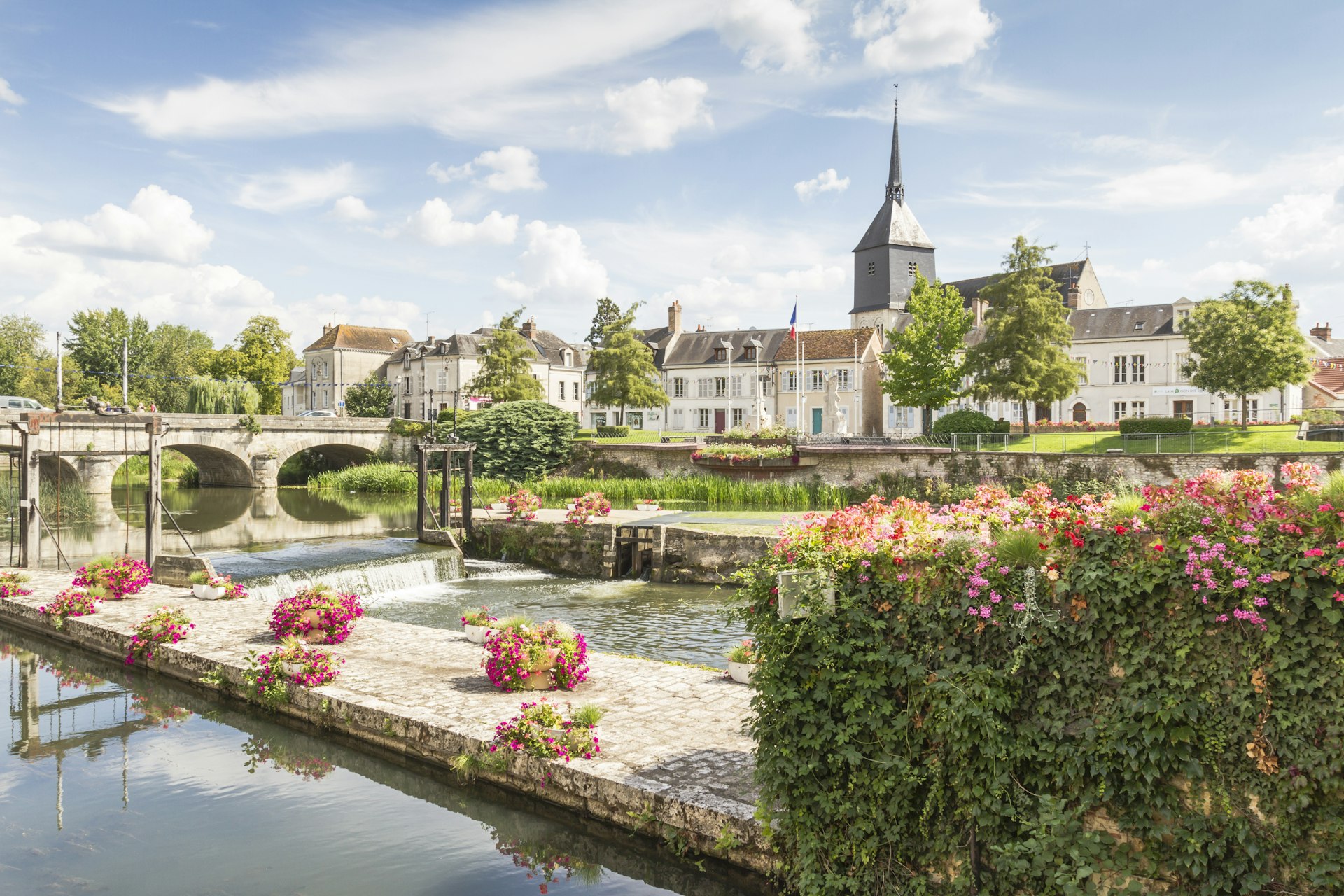
5. Orléans to Le Croisic on Interloire is the best train ride for cyclists
Orléans to Le Croisic; 338km (210 miles)
The Loire Valley unfolds like a fairy tale, with a stunning array of Renaissance castles, green-emerald rivers and charming medieval villages. ( Azay-le-Rideau castle was, after all, the inspiration for Sleeping Beauty .) The Interloire railroad (run by the TER Centre-Val de Loire and TER Pays de la Loire ) traverses this legendary valley from Orléans , the hometown of Jeanne d’Arc, to the fishing harbor town of Le Croisic on the Atlantic.
Must-visit stops include Blois , crowned by the château once occupied by Louis XII; Amboise , Leonardo da Vinci’s final home; and Nantes , a historic Breton town with an evocative 15th-century château.
Planning tip: You can hop on and off the train with your bike to peddle parts of the 900km (559-mile) Loire à Vélo, a relatively flat bike path through this quintessentially French landscape. The train even has a car dedicated to bicycles in the summer.
6. Eurostar through the Chunnel offers a quick escape to London
Paris to London; 451km (280 miles)
If you fancy a quick getaway from Paris to London , perhaps to say hi to Big Ben or to wander through the V&A Museum , count on the Channel Tunnel. Completed in 1994, this extraordinary engineering feat – nicknamed the Chunnel – burrows deep beneath the expanse of water between France and England, allowing passengers in sleek, high-speed Eurostar trains to travel the channel portion of the trip – 51km (31.5 miles) – in just 30 minutes, with a full 38km (23.5 miles) of that underwater.
From Gare du Nord in the heart of Paris to St Pancras International in the heart of London, the entire trip takes just 2½ hours from door to door. Along the way, you’ll enjoy pretty French and English countryside – inside the tunnel itself, you shouldn’t count on seeing any sea life, only blackness until you emerge into the light of day.
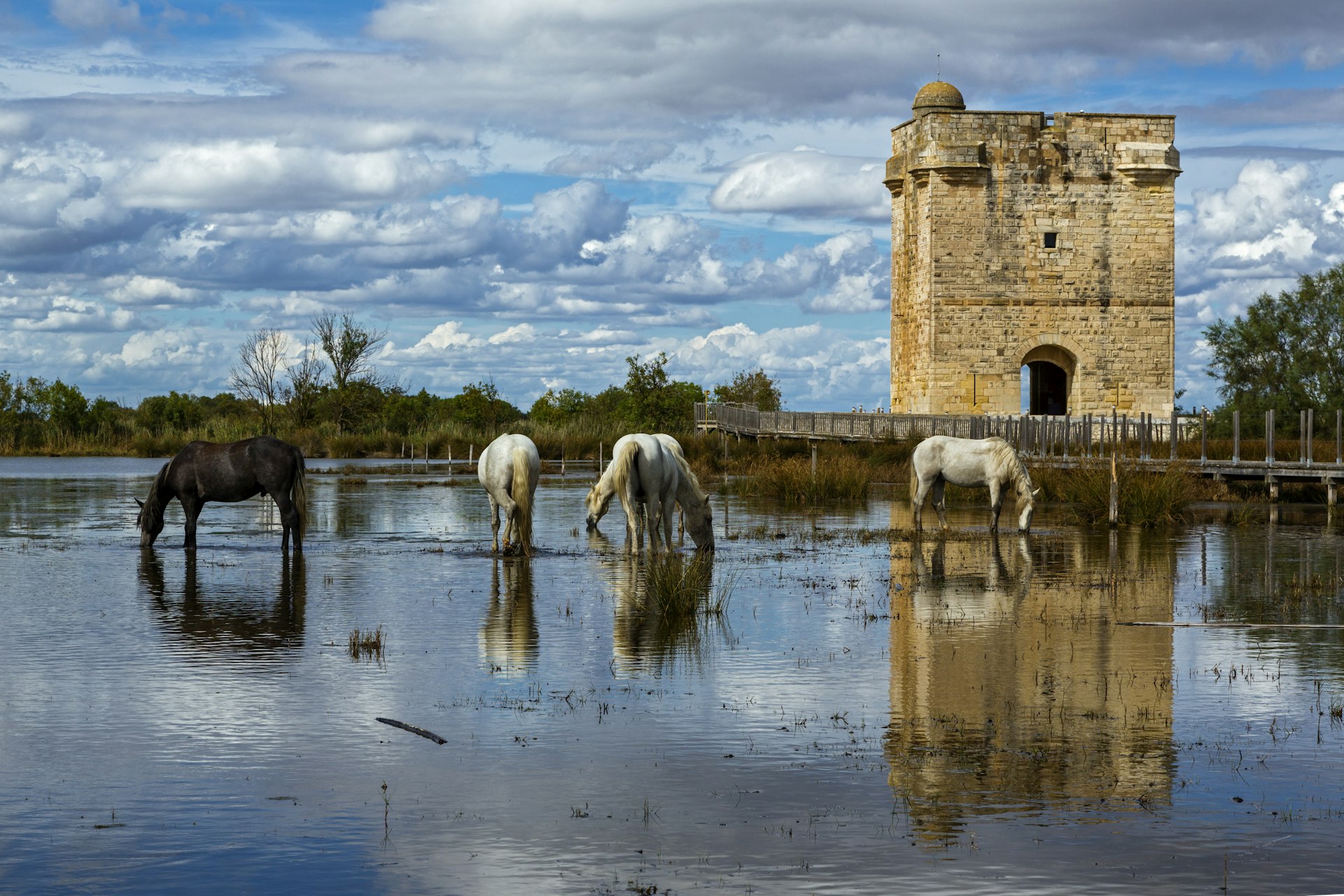
7. The Nîmes to Le Grau-du-Roi Line is the best Wild West train ride
Nîmes to Le Grau-du-Roi; 37km (23 miles)
Wild bulls in Provence? And cowboys? Mais oui . Tucked away in the southwestern corner of Provence, the marshy Camargue – a river delta south of Arles where the Grand and Petit Rhône meet the Mediterranean – reigns as France’s version of the Wild West. Gardians – Camarguais cowboys – live on manades (ranches), riding indigenous white horses with flowing manes as they round up wild black bulls.
Bullfighting is a big part of the culture here (unlike Spanish bullfights, the bulls here are not killed or injured). As are paella (though Camargue rice differs from its Spanish cousin), jazzy manouche music and an independent spirit developed from working a challenging landscape for centuries. You can get to the heart of it all aboard the Nîmes to Le Grau-du-Roi train route.
Departing from Nîmes , the single-track train rumbles through the vineyards of Costières de Nîmes before passing by Aigues-Mortes . Kings departed on their Crusades from this medieval walled city, where you can still stroll ancient streets. From there, you head across the salt marshes and lagoons; keep your eyes out for horses and bulls, as well as pink flamingoes flying overhead. The route ends in Le Grau-du-Roi , just steps from the Mediterranean Sea.
8. Le Petit Train Jaune is the most famous vintage train ride
Villefranche-de-Conflent to Latour de Carol; 64km (40 miles)
This historic little train – or, literally, the “ little yellow train ” – may be the most famous of them all in France. It’s certainly one of its most stunning when it comes to scenery. Chugging through the mountainous Pyrénées-Orientales from medieval Villefranche-de-Conflent to Latour de Carol on the Andorra border, it winds through gorges and shadowy forests, across viaducts, past two historic fortresses and by one perilously perched ancient monastery. The highest point is the Bolquère Eyne depot, a gasp-inducing 1593m (5225ft) high – making it France’s highest station.
Note that two different types of trains operate this route: a modern enclosed train as well as the vintage train that sometimes runs with open carriages. No need to worry about which one to choose, though – both are painted yellow.
Tips for train travel in France
Train options in France
Several different types of trains travel across France, including local and regional trains, overnight trains with sleeping accommodations and the TGV , the high-speed Trains à Grande Vitesse. To travel between most big cities, the TGV is your best bet: these pioneering high-speed trains travel between 255km/h and 320km/h (160mph and 200mph) and will get you there within hours.
Paris to Bordeaux, for example, is 2½ hours, with Paris to Marseille a mere 3 hours 40 minutes. That said, the slower local and regional trains open up lesser-traveled regions of the country. TGV inOui is a new premium TGV train service operated by SNCF on certain high-speed rail services.
Two classes of tickets are usually available to purchase: first ( première ), with plush, reclining seats and ample space; and second ( deuxième ), which is still comfortable but often more crowded. Maps of the French rail network are available on the SNCF website.
How to book a train in France
While you can buy a ticket at the station, either from a ticket window or a vending machine, it’s often cheaper to book your ticket online in advance. Contact Société Nationale des Chemins de Fer (SNCF ) or, from the United States, Rail Europe .
Cheap train tickets in France
France offers various rail passes, including the France Pass, with unlimited travel on the national rail network; and the Eurail Global Pass, which includes train travel to neighboring countries. Deals for hotels, museums and other attractions are often included, too. You’ll find more information on the Rail Europe website .
The TGV offers Prem’s tickets (their term for affordable tickets) three months in advance (the booking horizon may be extended in summer).
The Eurostar high-speed train service connecting the United Kingdom with France (and Belgium and the Netherlands) offers a limited batch of discount fares six months in advance. The sooner you book, the better chance you have of getting a good price.
Set up a booking alert to be notified when discount tickets are released.
How to get from Italy to France by train
You can get from Italy to France via Italiarail. It takes about 11½ hours to travel from Rome to Paris. SNCF also serves the route.
How to get from Spain to France by train
Spain’s train company is Renfe . It takes about 10½ hours to get from Madrid to Paris, a route also served by SNCF.
How to get from Switzerland to France by train
The TGV runs from Geneva to Paris in a little over four hours.
How to get from Germany to France by train
The Deutsche Bahn ’s InterCity Express (ICE) is Germany’s high-speed train service, allowing travel from Frankfurt to Paris in as little as four hours (as long as you don’t have to connect in Cologne). SNCF also serves the route.
How to get from Poland to France by train
It takes between 14 hours and 19½ hours to cross much of Europe from France to Poland, and you typically need to make two changes along the way. Train companies serving this route include Deutsche Bahn, SNCF and Eurostar (the French–Belgian high-speed train operator, which will take you as far as Cologne).
This article was first published Aug 5, 2022 and updated Dec 25, 2023.
Explore related stories
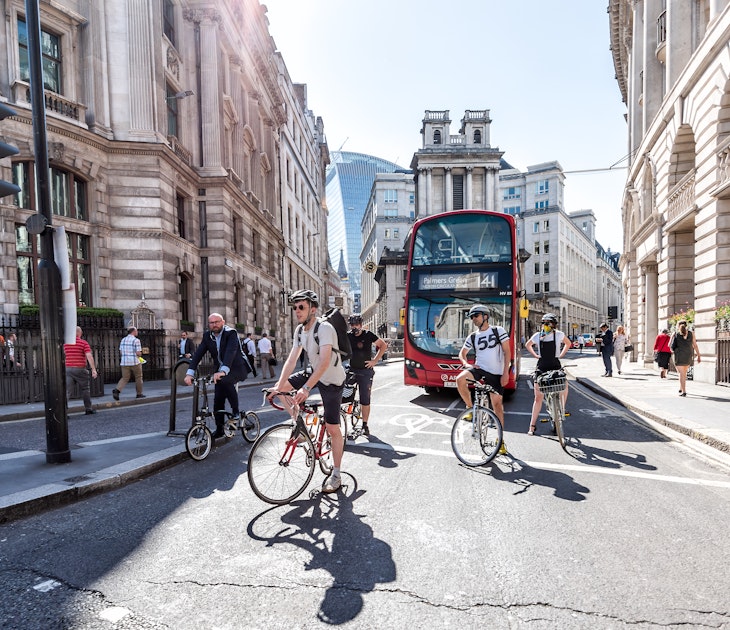
Public Transport
Mar 17, 2024 • 10 min read
London has a huge public transportation system, but is not the most intuitive city to navigate. Here's what you need to know about getting around London.

Feb 8, 2024 • 7 min read

Dec 19, 2023 • 6 min read
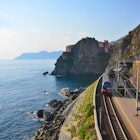
Dec 27, 2022 • 8 min read
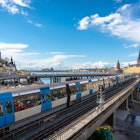
Dec 9, 2022 • 9 min read

Sep 20, 2021 • 5 min read

Apr 19, 2024 • 8 min read

Apr 17, 2024 • 8 min read

Apr 12, 2024 • 9 min read

Apr 3, 2024 • 15 min read

The Complete Guide To Travel In France By Train
France has long been a favorite and one of the most popular tourist destinations in Europe . Given that it is the largest country in western Europe, it makes sense to travel by train. The French government has invested in high-speed lines (Ligne a Grande Vitesse or LGV) and high-speed trains (Train a Grande Vitesse or TGV train). There are more than 1056 miles (1700 km) of dedicated high-speed lines as well as thousands of miles of main and smaller lines. Almost the whole country is accessible via French railways. France’s trains are efficient, fast, and will get you where you want to go within the country as well as to or from any neighboring country. If you are a first-time traveler in France, the best way to get around using train travel is through careful trip planning. However, the rail network can be a little confusing, especially when you don’t speak or read French. To help you understand the train system in France, we have created a complete guide to travel throughout France by train.
In this guide, you will find out everything you need to know to create your personal travel plan. We will also provide information on different train companies that operate in France and the types of trains. We will give you valuable tips on buying tickets for the lowest price, navigating the railway system, the benefits of rail passes, and getting around France from Paris. Keep reading The Complete Guide To Travel In France By Train to discover how to travel to France by train.
- Rail Transport Is The Eco-Friendly Way To Travel. Th is article is written to educate about Train Travel by Save A Train, The Cheapest Train Tickets Website In The World .
How To Buy Train Tickets In France
Where can i buy train tickets for my trip to france.
There are several easy and convenient methods or websites for buying French train tickets. They are fairly easy to use, but many of them come with their own quirks and oddities that we need to point out.
Save a Train is a company that digitized and revolutionized rail ticketing . Visit their website, compare train fares, choose the train line, and type of seat you want. You can pay with your credit card or even bitcoin. In case your train ticket’s price drops, the platform will let you know and help you exchange it for a lower price.
W hen accessing the official website of French Railways , you will most probably get redirected to RailEurope.com, which is the official North American partner of French Railways. However, you won’t always find the cheapest fares on Rail Europe. Therefore, you should always pay attention that the cheapest train route fares are on Save A Train.
Amsterdam to Paris Trains
Nice to Marseilles Trains
Rotterdam to Paris Trains
Brussels to Paris Trains
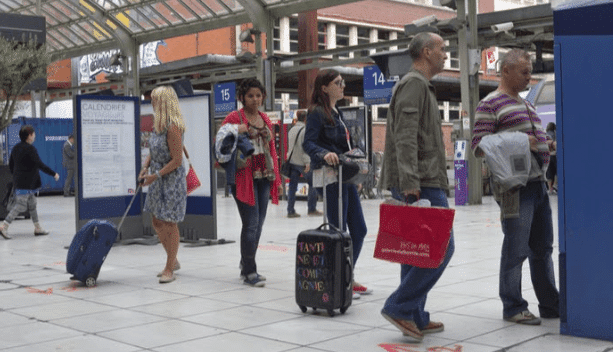
At The Train Station
There are two ways to buy French train tickets at the station – from a ticket window and at the vending machine. English-speakers can purchase them either way, but if your English is not that good and cannot communicate with the person at the ticket window well, the vending machine is your best bet. It is easy to navigate, and you can even change its language settings. Buying tickets from the vending machine requires a Chip & PIN credit card.
How should I collect my online ticket?
There are several methods of collecting your tickets:
- Pick up at the station. To collect your tickets at the station, you can use a booking information number or credit card (the same one you used to buy the tickets).
- Print-at-home tickets. After you receive the electronic tickets, you can print them and show them to the train conductor who checks tickets.
- Electronic tickets. If you don’t want to print your tickets, you can download them to your phone or tablet. You can just show the conductor your ticket via your phone or tablet screen.
- Mailed tickets. Some services offer the option of sending you the tickets via regular mail. However, that is a very slow process, and therefore, not a recommended option.
Should I buy train tickets in advance?
It can be confusing to know which train tickets can be purchased whenever and which should be bought in advance because there are several types of trains and different train services.
Regional/local trains. Regional and local trains connect suburban and regional areas. RER and Transilien connect suburban Paris, while TER trains (Train Expres Regionaux) are regional trains that connect regional hubs with smaller towns. You don’t have to buy regional and local train tickets in advance, just buy them right before departure.
- Intercite trains (IC). An Intercites train is an express train that doesn’t travel on the high-speed lines and connects cities as well as shorter distances. You can purchase IC tickets in advance to get a discount.
- High-speed trains (TGV). TGV trains are the fastest trains in France, and tickets for them are available to purchase 90 days in advance. The prices for them continue to rise as the departure date approaches, so book them early for the lowest price. A ticket purchased 90 days in advance could cost €30. But if you were to buy them a few days before the departure, the ticket price could be as high as €100.
- International trains. The same rules on early booking apply to international trains because these are also high-speed trains.
What are the benefits of rail pass tickets?
There’s a wide range of rail pass tickets you can use to travel throughout France by train. Some of them allow you to travel within France and other European countries, and then there are rail passes that are solely for travel within France. Unlike regular train tickets, rail pass tickets come with some benefits:
- Flexibility. With a rail pass ticket, you get unlimited train travel. Just go to the station whenever you like, stamp the rail pass in the train station office and get on the next available train.
- Discounts. Rail passes typically come with inclusions of discounts for attractions, making them an excellent option for budget travelers . They can be a huge money-saver, which is the main reason people purchase rail passes. Last-minute train tickets can be costly if you don’t book them in advance.
- Convenience. You don’t need to worry about buying a ticket every time you want to take a train, but you must have flexibility since you won’t have a place on every train that you wish.
Which rail pass ticket should I purchase?
When purchasing a rail pass ticket, you can choose between the France Country Pass and Multi-Country Pass (Eurail Global Pass) .
The France Country Pass is your best bet if you are just traveling in France because it provides unlimited travel on the national rail network (including intercity, TER, TGC, etc.). You can choose either 1 to 8 days of travel within a month as well as choose between first and second class. A seat reservation is required in addition to a rail pass for travel on high-speed trains. With this pass, you also receive discounts on various buses, ferries, cruises, hotels, museums, and other attractions.
The Eurail Global Pass is a better option if you also plan to travel to neighboring countries. This multi-country pass provides unlimited travel to 31 different countries in Europe (including France). With Eurail passes, there is no limit to the number of times you can catch a train. Choose either 3, 5, or 7 days of travel within one month or 10-15 days of travel within two months. Remember to make reservations before departure.
Most rail passes are paper-based, and you will need to write the date of your departure before the first trip of each day. Seat reservations for high-speed trains will cost you between €10 and €20 per seat, while international travel reservations range from €35 to €89 per seat (depending on the destination).
AN IMPORTANT NOTE : Rail Pass is only good value for money if you train travel to more than 14 days if you travel for less than point to point train tickets such as what Save A Train is offerings offer better value for your money.
Marseilles to Lyon Train times
Paris to Lyon Train times
Lyon to Paris Trains
Lyon to Avignon Trains
How To Use Train Tickets In France?
On regional and local trains, you might need to travel with a physical ticket. Go to a validation box before your departure to validate or “stamp” your ticket. If you didn’t validate it before departure, wait for the conductor to stamp it while on the train. There are no seat reservations for regional and local trains, so just sit anywhere.
On high-speed trains, there is a specific time printed on your ticket, and the ticket is only valid for that specified time. There is no need to validate your tickets because you have a seat reservation. Make sure that you find the right car and seat (the numbers are written or printed on your ticket).
Paris to Rouen Trains
Rouen to Paris Trains
Paris to Calais Trains
Rouen to Calais Trains
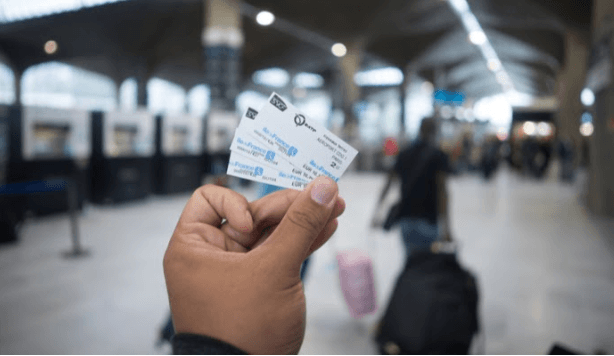
Getting Around France From Paris
When tourists come to France, the majority of them make Paris their starting point for train journeys within the country. When starting in Paris, you can reach almost any destination within the country. These are some of the main destinations served from Parisian train stations.
- Gare d’Austerlitz or Austerlitz Train Station – Bordeaux, Limoges, Poitiers, Toulouse, Biarritz, Tours, and western Spain.
- Montparnase Train Station or Gare Montparnasse – All TGVs to western France (Rennes, Nantes, Brest, Brittany)
- Gare du Nord – Northeast France, Valenciennes, Lille, Calais; Brussels, Cologne, and Amsterdam (Thalys); London (Eurostar).
- Gare de Lyon – South of France. Montpellier, Dijon, Lyon, Clermont-Ferrand, Besançon, Marseille, Nice. Mulhouse in the East of France. Catalunya (Girona, Barcelona), Italy, and Switzerland (Geneva, Zurich).
- Saint Lazare Railway Station or Gare St. Lazare – Le Havre, Rouen , Caen, Cherbourg.
- Gare de l’Est – Nancy. Reims, Metz, Strasbourg, Luxembourg, and Germany.
La Rochelle to Nantes Trains
Toulouse to La Rochelle Trains
Bordeaux to La Rochelle Trains
Paris to La Rochelle Trains
Best Tips For Travel In France By Train
We provide you with a list of great tips that will make your train travel in France more convenient and enjoyable.
- Arrive early at the train station. Be sure to be at the train station at least 20 minutes before departure, or even earlier if you are traveling from huge train stations, such as the Gare du Nord in Paris. For a tourist who doesn’t speak French, there is nothing worse than arriving only a few minutes before departure without having the slightest idea of where to go. Arriving early enough will give you time to check the Departure Board for station information, identify which platform your train is leaving, and find the right platform.
- Never leave your luggage unattended. You might want to walk to a nearby shop for some snacks or water. If you decide to walk around, don’t leave your bag unattended even for a second. Otherwise, you risk having your luggage stolen by experienced thieves. Major train stations in France (including Paris Gare du Nord, Paris Gare de Lyon, and Paris Gare d’Austerlitz Est) have left-luggage lockers in various sizes. Before you enter the locker area , expect to have your bags X-rayed. Once onboard, place your luggage within your eyesight instead of on the dedicated luggage spaces.
- Pack some food. Passengers are allowed to bring their own food and beverage on trains, which is great for long-distance train rides. Some trains have a cafe on board, and most of them have a trolley cart that comes around. Unfortunately, the trolley doesn’t always come, and the cafe may be closed. The food and drinks on board are also more expensive. To save money , pack yourself a picnic with your favorite food before every trip. There are various convenience stores in most train stations where you can buy food and drinks.
- Download a rail planner app to your phone. There is a range of rail planner apps you can install and use to make your train travels more convenient. Our article contains all the info and train schedules for European trains, and some apps don’t require an internet connection. With a rail planner app, you will always know whether your train is going to be late (and by how long) or on time, as well as which platform it will arrive/depart. In major cities like Paris, there isn’t one “main” station, and it is easy to confuse one station for another. With the right app, you will be sure that you get off at the correct station.
- Luggage. When it comes to luggage, you can bring as much as you can carry since there are no weight limits. You can store your bags overhead, behind your seat, or in a luggage rack in your car.
- First-class and second-class tickets . There is not much difference between first-class and second-class cars. However, it is quieter in the first-class, and the seats are a bit bigger. Second-class cars are also perfectly comfortable. It’s worth mentioning that first-class tickets cost about 1.5x more than the second-class fare.
- You cannot refund cheap tickets. Perhaps the only downside to cheap tickets is that they cannot be changed or refunded.
- Self-service machines. When using a self-serving ticket machine, you can choose the English language option, so there’s no need to worry if you don’t speak French.
- Carrying a bicycle. On local and regional trains, you can take a bicycle with you free of charge. TGVs and Intercites de Nuit (overnight trains) on a few routes allow you to take a bike for a small fee (usually about €10). On other TGV trains, you will have to put your bicycle in a zip-up bike bag.
- Making connections. Along the journey, your trip might require you to change trains. Switching trains are typically quick and easy, so there’s no need to worry if you don’t have enough time between trains. A train connection might involve walking to the other side of the platform or the other part of the train station.
- Know the train station names. Large cities have multiple train stations, which can create confusion. If you can’t memorize their names, write them down on a piece of paper, save them on your phone, or use a rail planner app.
- Mind the train strikes. France is known for train strikes, and they always warn the public before going on one. While some trains will still run, strikes are something to pay attention to if you want to avoid major inconveniences.
- Use Chip & PIN credit card. To purchase a ticket on an automated ticket kiosk, you will need a Chip & PIN credit card, so make sure you know your PIN code, although we do not recommend it, since it’s very expensive.
Paris to Marseilles Trains
Marseilles to Paris Trains
London to Paris Trains
Marseilles to Clermont Ferrand Trains

All major cities in France are connected by TGV – the high-speed train network with trains that travel at speeds of nearly 200 mph. At these speeds, all areas of France are within your reach.
We designed this guide “Complete Guide To Travel In France By Train” to give you a strong understanding of how the French rail system works and help you if you are thinking about taking a train but not sure what to do or where to start. Whether you are on a backpacking adventure, a business trip, or on a family holiday, we have got you covered, Save A Train is the place to buy train tickets .
Do you want to embed our blog post “The Complete Guide To Travel In France By Train” onto your site? You can either take our photos and text and give us credit with a link to this blog post. Or click here: https://iframely.com/embed/https%3A%2F%2Fwww.saveatrain.com%2Fblog%2Fguide-travel-france-train%2F%3Flang%3Den - (Scroll down a little to see the Embed Code)
- If you want to be kind to your users, you can guide them directly into our search pages. In this link, you will find our most popular train routes – https://www.saveatrain.com/routes_sitemap.xml . Inside you have our links for English landing pages, but we also have https://www.saveatrain.com/fr_routes_sitemap.xml , and you can change the /fr to /it or /es and more languages.

Liam Mallari
Related posts.

10 Top Destinations With Tennis Fields

Top 3 European Railways Serving Good Food

The Must Do Europe Experiences By Train
Translation flags, search blog, search hotels and more..., destination, check-in date, check-out date.

Recent Posts
- Digital Visa for Freelancers: Top 5 Countries for Relocation
- 5 Platforms To Explore Volunteer Programs Worldwide
- New EU Rail Regulations: Better Protection for Passengers
- 7 Amazing Spring Break Destinations In Europe
- Traveling To Europe During Bank Holidays
Trains in France – How to Travel around France by Train
Article written by Elisa - Travel Writer & Local in France This article may contain compensated links. Please read disclaimer for more info.
Train Travel in France
If you’re planning a trip to France , getting around the country couldn’t be easier than by train. Trains in France are one of the best modes of transportation and will get you anywhere you want to go in the country with ease and to or from any neighboring country.
If you’re a first-time visitor and need some assistance with understanding train travel in France, then you’ll want to read this quick guide to France by Train . This guide provides everything you need to ensure traveling by train in France goes smoothly, including information on the different types of trains in France, the best France rail pass for tourists, where to buy your tickets, and just some general tips.
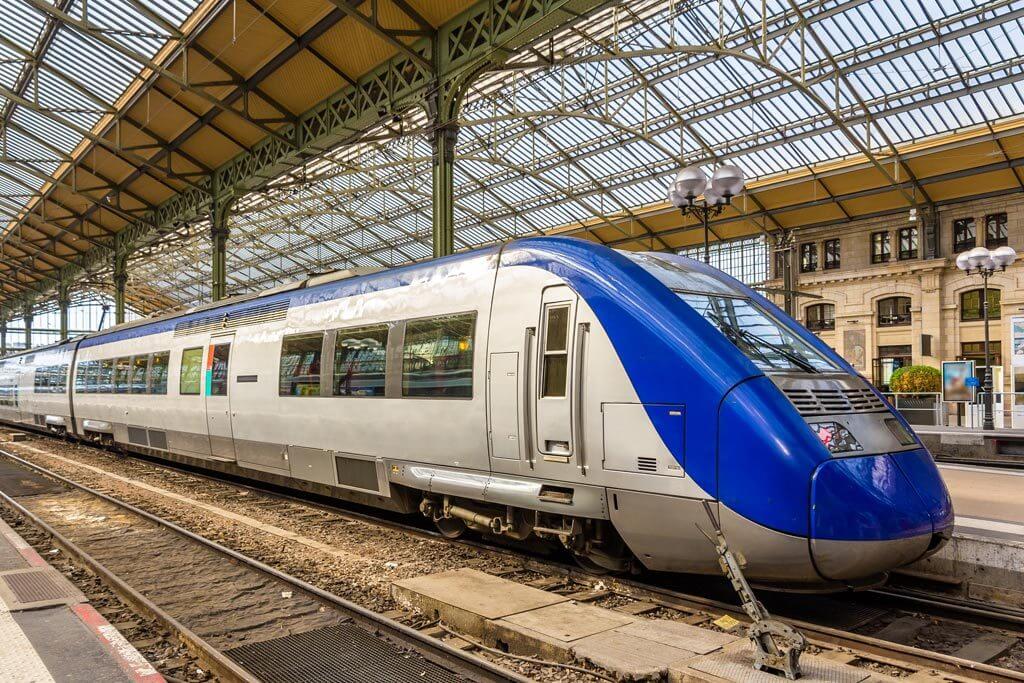
Table of Contents:
France Train Map
Types of trains in france, how to buy tickets for trains in france, sncf’s new luggage policy (as of 2024), travel france by train – destinations.
- France Rail Pass for Tourists
Getting Around France by Train – Best Tips
The French rail network links all the major French cities and the smaller rural towns and cities of neighboring countries. In the France train map below, the high-speed rail lines are in red, and the other major lines are in brown.
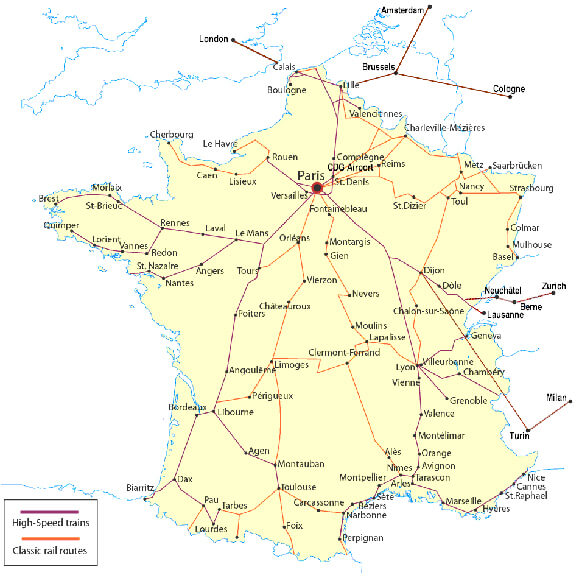
There are various types of trains in France, from local trains to long-distance trains. There are even trains that cross into neighboring countries.
Below, I have provided a brief overview of the various trains in France, so you can understand which trains will get you to your destination,
France Train Travel: First Class or Second Class?
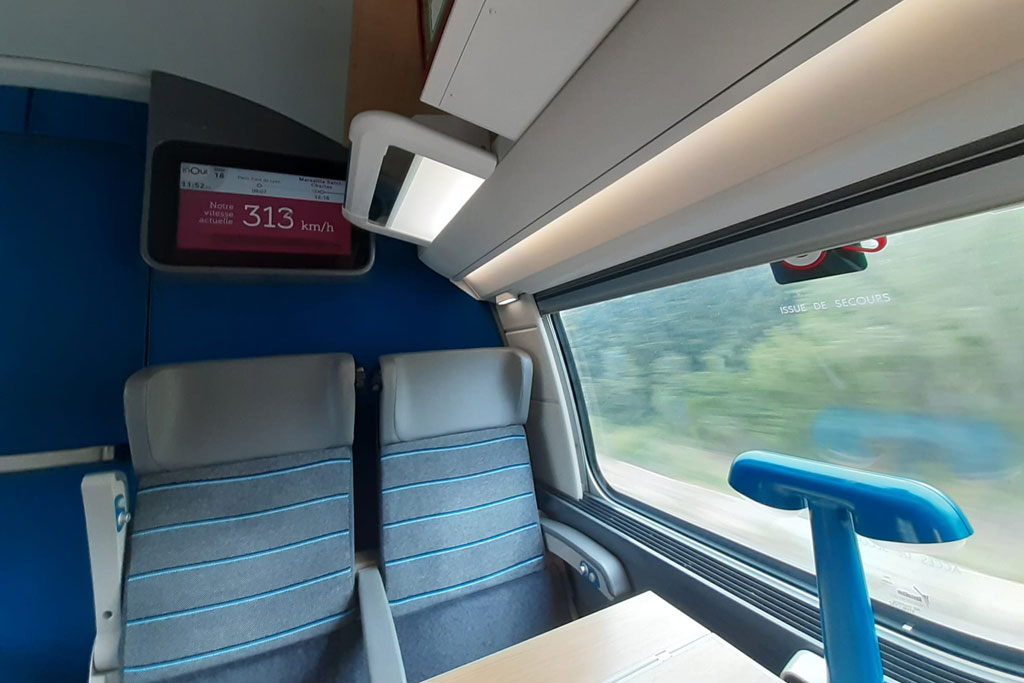
When you travel France by train, you have the option of purchasing a first-class or second-class ticket. Either class is very comfortable with most seats, including drop-down tables and power.
First-class seats are wider and more comfortable than 2nd-class seats, as there are fewer seats per car. There’s also more space for your luggage.
Personally, I find the first class to be less noisy and a place where it’s easier to relax or work (no kids running along the corridors, people talking on the phone, or listening to music with the loudspeaker).
Sometimes, the difference in price between first and second class is minimal, so the extra comfort is well worth it.
Generally, all trains have free Wi-Fi and a café on board, but you are also welcome to bring your own food.
1. TGV Trains (Train à Grande Vitesse)
The TGV train is France’s high-speed rail service, connecting over 230 cities across France and some European cities. At up to 320km/h, these trains will get you where you need to go fast!
Unfortunately, I don’t have a specific TGV map but if you look at the France train map above, the TGV network would correspond to most of the dark red lines.
With TGV Trains, you have the option of traveling first-class, second-class , and (in some TGV lines) business class . Generally, all TGV trains have free Wi-Fi and a café on board, but you are also welcome to bring your own food.
To ride the TGV, you must book a seat reservation (see below on how to purchase train tickets). For the cheapest tickets, book well in advance rather than on the day of travel. Tickets are usually available for purchase around 90 days before the day of travel.
2. Intercités
Intercités trains in France are express trains that connect the main cities within France. They cover longer distances than local trains, but not quite as long as the TGV trains. These trains service over 300 destinations in all the French regions , reaching cities such as Amiens, Orléans, Bordeaux, Caen, Lyon, Reims, Troyes, Toulouse, and Paris.
With Intercités Trains, you have the option of traveling first-class or second-class . Generally, all trains have free Wi-Fi and a café on board, but you are also welcome to bring your own food.
Like the TGV trains, the Intercités trains require advance booking. For the cheapest tickets, book well in advance rather than on the day of travel. Tickets are usually available for purchase around 90 days before the day of travel.
3. OUIGO Trains
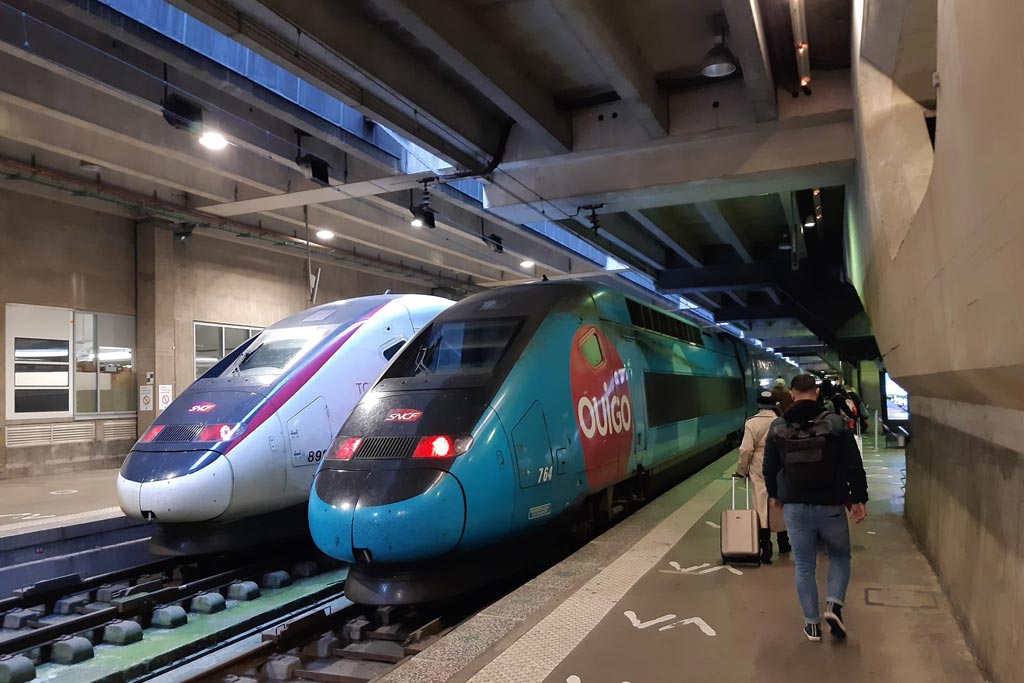
OUIGO is a low-cost rail service company established in 2013 as part of the SNCF group. OUIGO trains only have one class, equivalent to second-class travel. This is why OUIGO tickets are so cheap – from €10 for adults (depending on the destination) and €5 for children.
In OUIGO trains, Wi-Fi and a plug for charging your devices are considered extras (to pay in addition to the train ticket).
4. TER (Transport Express Regional)
TER trains are regional trains in France, usually referred to as local trains. They are ideal for getting between regional French towns and villages.
Like long-distance trains, with TER trains, you can also travel first or second class , but this will change soon (a unique class).
No seat reservation is required to travel on a TER train (you can sit anywhere you like). However, you will require a ticket. Tickets can be purchased as you go or in advance up to 120 days before the day of travel. During the high season in France, main holidays, and long weekends, I recommend booking these train tickets online in advance.
5. AutoTrain
Don’t feel like driving to your destination but need your car once you get there? Well, AutoTrain is the answer! This train runs from Paris Bercy Station to the South of France with your car onboard. So all you need to do is take a comfortable and quick Autorain and meet your car there.
6. Night Train
Some destinations are also covered by night trains – TGV trains or Intercités trains, which also have 4 and 6-bed cabins. Night trains are environmentally friendly and are a great way to save time and money (one hotel night less).
The main lines covered by night trains in France are Paris – Nice, Paris – Toulouse, Paris – Antibes, Paris – Marseille, Paris – Rodez, and Paris – Montauban. There are also international night trains from /to France, with Paris – Vienna being the most famous line.
Update December 2023: two more night train lines are available in France: Paris – Aurillac and Paris – Berlin!
>> Paris-Aurillac in the Cantal leaves in the evening from Paris Austerlitz train station and arrives in Aurillac early in the morning. It is available on weekends and during school holidays in France – Click here to buy your tickets from Paris to Aurillac (or vice-versa)
>> NightJet from Paris to Berlin leaves the German capital in the evening, traveling via Strasbourg, and arrives in Paris early in the morning. For the time being, this service is available 3 times a week, and it will be a daily service from October 2024. The train operator is OBB (Austria) – Click here to buy your tickets from Paris to Berlin (or vice-versa)
7. Eurostar (Train from the UK to France)
The Eurostar (international joint operation) is a high-speed train from England to France that connects France with the UK and Belgium via the Channel Tunnel. One of the most popular Euro trains to Paris, the Eurostar is so fast that it’s, in fact, possible to make day trips from London to Paris or London to Disneyland Paris !
Other French cities served by Eurostar trains are Calais, Lille, Lyon, Avignon, Marseille, Moutiers, Aime-la-Plagne, and Bourg-St-Maurice.
This Euro train has three classes of travel: standard, standard premier, and business. All classes of travel are very comfortable. Standard premier and business classes are served food onboard, while standard class can purchase food at the onboard café or bring their own food. On most trains, Wi-Fi is available onboard the trains and a range of entertainment is via the Eurostar App.
A seat reservation is mandatory on Eurostar (see below for how to purchase tickets). For the cheapest tickets, book your tickets well in advance rather than on the day of travel. Tickets are usually available for purchase around 90 days before the day of travel.
Unlike most of the other trains above, for the Eurostar, you are required to check in before boarding the train.
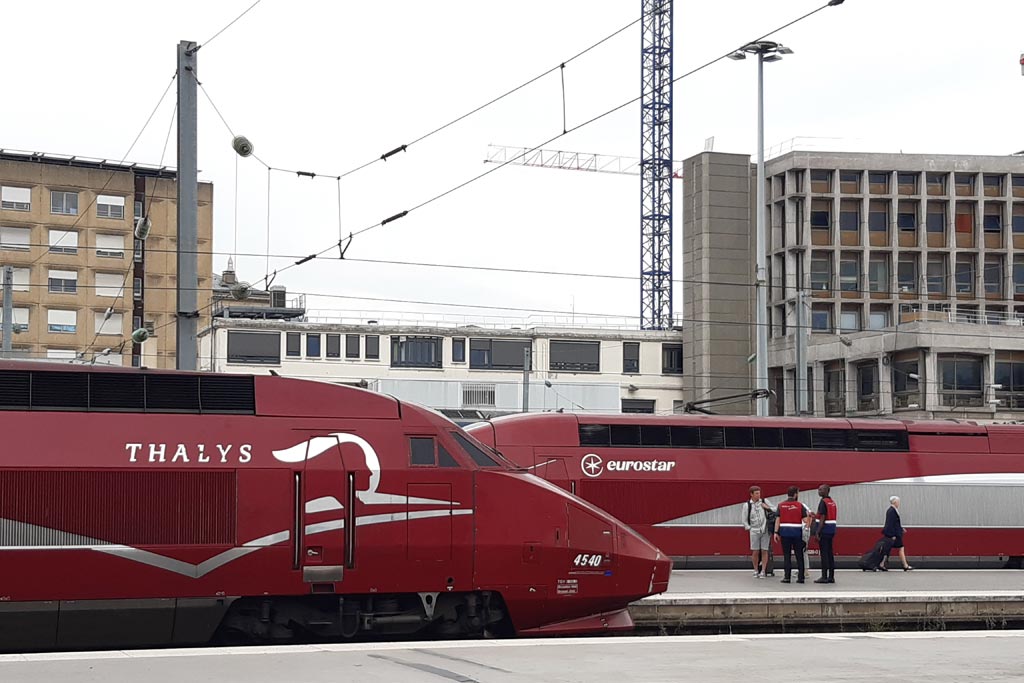
The Thalys is a French-Belgian train operator connecting France with Belgium, the Netherlands, and Germany.
When traveling on the Thalys train, you can purchase a first-class (comfort or premium class) or second-class ticket. Either class is very comfortable with all seats, including drop-down tables and power sockets. All trains have free Wi-Fi and a café on board, but you are also welcome to bring your own food onboard.
A seat reservation is mandatory on Thalys trains (see below for how to purchase tickets). For the cheapest tickets, book your tickets well in advance rather than on the day of travel. Tickets are usually available for purchase around three months before the day of travel.
There are various ways to buy train tickets in France, depending on your preference. These options are available whether you hold a rail pass and just need to make a seat reservation or if you require a point-to-point ticket.
1. In Train Stations
For the ultimate flexibility, you can just turn up and purchase your ticket at the train station. You can either purchase your ticket at a vending machine or from a ticket window (this is becoming rare, though).
If you don’t speak English, it’s often best to use the vending machines, as you can switch it to English.
However, I don’t recommend this option for long distances, as some train lines are sold out days (or months) in advance.
2. Online on the SNCF Website
Locals in France usually prefer to purchase their train tickets via the SNCF website , which is the official website of the French Railways. You can either purchase your tickets as you go or in advance to secure some good deals. Unfortunately, the English version of the site is not that great, but it is still a good way to purchase tickets online.
You can then choose to print your ticket on your phone or keep it on your smartphone.
3. Online on Omio or Trainline Websites
I recommend that you use Omio to book French train tickets – alternatively – book your train tickets on Trainline here. Both sites are easy to navigate, have great overviews of the train schedules and prices, have lots of information, straightforward booking, and are all in English. (All the things that the SNCF is NOT!)
Since 15 February 2024, the SNCF has imposed a limit on passengers regarding their luggage, which means that your suitcases will have to respect certain dimensions. The size of baggage allowed depends on the type of train.
1. TGV and Intercités Trains
One person can take up to two pieces of labeled luggage with maximum dimensions of 70 x 90 x 50 cm (suitcase, large backpack, hiking bag, sports bag) and one labeled handbag with maximum dimensions of 40 x 30 x 15 cm (backpack, shopping bag, computer bag).
In addition, it is also possible to travel with “special luggage”: “stroller, folded scooter, musical instrument in a labeled case, pair of skis in a labeled bag, wakeboard or snowboard in a labeled bag,” specifies the SNCF.
2. TER Trains
TER trains do not have a maximum size imposed. “Nevertheless, luggage must be able to be handled by yourself and enter the spaces provided on our regional trains,” SNCF says.
For the Ouigos, nothing changes. Passengers already had to respect a size and a number of bags before this new policy. As a reminder, you can board the carry-on baggage of no more than 36 x 27 x 15 cm and one piece of cabin baggage that does not exceed 55 x 35 x 25 cm.
GOOD TO KNOW: While the rules have been in place since 15 February 2024, the SNCF promises to be flexible “until 15 September 2024,” the end date of the “adaptation period.” From September 2024, there will be a fine of 50 euros for non-compliance with the baggage policy.
1. Train Travel from Paris
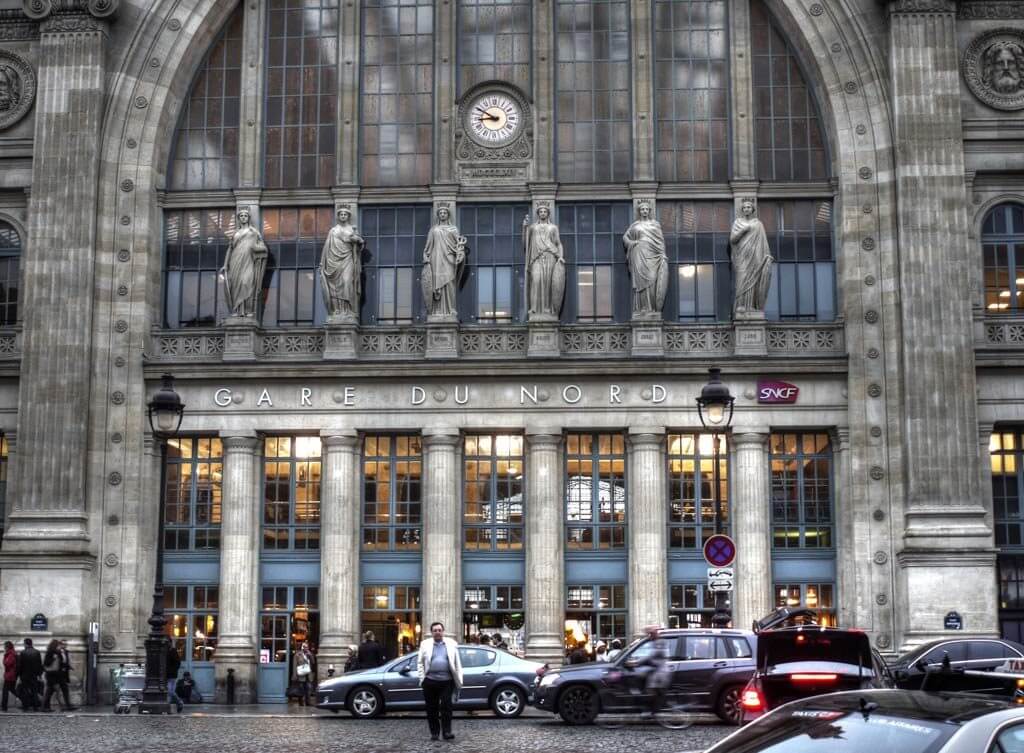
Given many tourists arrive in Paris , this is often the starting point for many train journeys within France. With the trains in Paris, you can pretty much reach anywhere within the country with ease.
Here are some of the main destinations in France served from the train stations in Paris:
» Gare du Nord: Northeast France, Lille, Valenciennes, Calais, London (Eurostar), Brussels, Cologne, and Amsterdam (Thalys)
» Gare de l’Est: Nancy, Metz, Reims, Strasbourg, Colmar, Germany, and Luxembourg
» Gare de Lyon: South of France. Lyon, Dijon, Besançon, Clermont-Ferrand, Marseille, Nice, Montpellier. Mulhouse in the East of France. Switzerland (Geneva, Zurich), Italy, and Catalunya (Girona, Barcelona)
» Gare d’Austerlitz: Tours, Poitiers, Limoges, Bordeaux, Toulouse, Biarritz, Western Spain
» Gare Montparnasse: All TGVs to West of France (Brittany, Brest, Rennes, Nantes)
» Gare St. Lazare: Caen, Cherbourg, Rouen, Le Havre.
2. Train Travel in France
Did you know France is the most visited country on earth? Whether you prefer spending your holidays swimming, hiking, sightseeing, or drinking some of the world’s best wines, it is possible to reach your dream destination in France by train.
Check out our suggested train itineraries:
- Best day trips from Paris by train
- Train itineraries 1 week
- Train itineraries 2 weeks
- Gothic Cathedrals in France train itinerary
3. Euro Train Travel to France
Train travel to France is not exclusive to French trains, so it is possible to travel to France with train companies from abroad. Examples of international cooperations are SNCF – Deutsche Bahn for train travel France – Germany, SNCF – Swiss Rail for train travel France – Switzerland, and SNCF – RENFE for train travel France – Catalonia and Spain.
Below I have listed the most popular international train travel routes to France:
- Need to catch a train from England to France? – take the super-fast and efficient Eurostar . England to France by train was never easier, and Eurostar connects Paris with both the UK and Brussels.
- From Switzerland, you can get a high-speed train to France with TGV Lyria .
- SNCF, in cooperation with Deutsche Bahn , operates frequent trains between France and Germany.
- If you’d like to travel to France by train from Belgium, the Netherlands, or Germany, Thalys operates an efficient train service.
New French destinations from Spain
RENFE (the Spanish train network) chose Lyon to introduce its new AVE fast train service for France. This new service connecting France and Spain began on 13 July 2023 between Barcelona and Lyon with no change of trains. Then, the connection between Madrid and Marseille started on 28 July 2023.
This is great news for Catalan and Spanish who wish to attend the Summer Olympics competitions in Southern France.
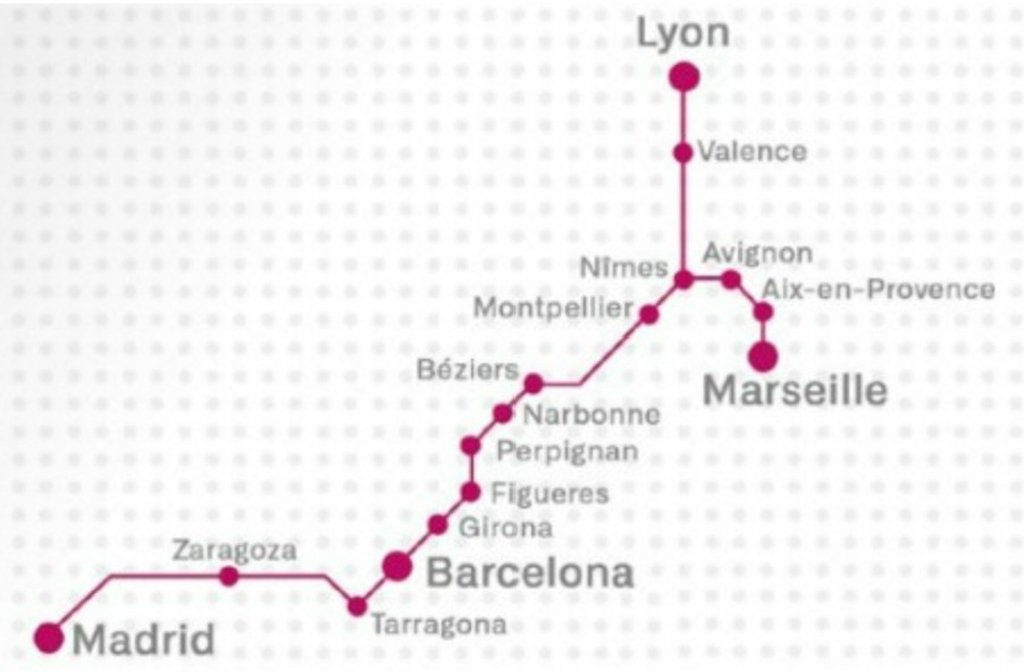
Currently, SNCF trains travel from Paris to Barcelona in less than 10 hours, with 3 routes per day. RENFE will also operate this route but only after the Summer Olympics.
France Rail Pass For Tourists
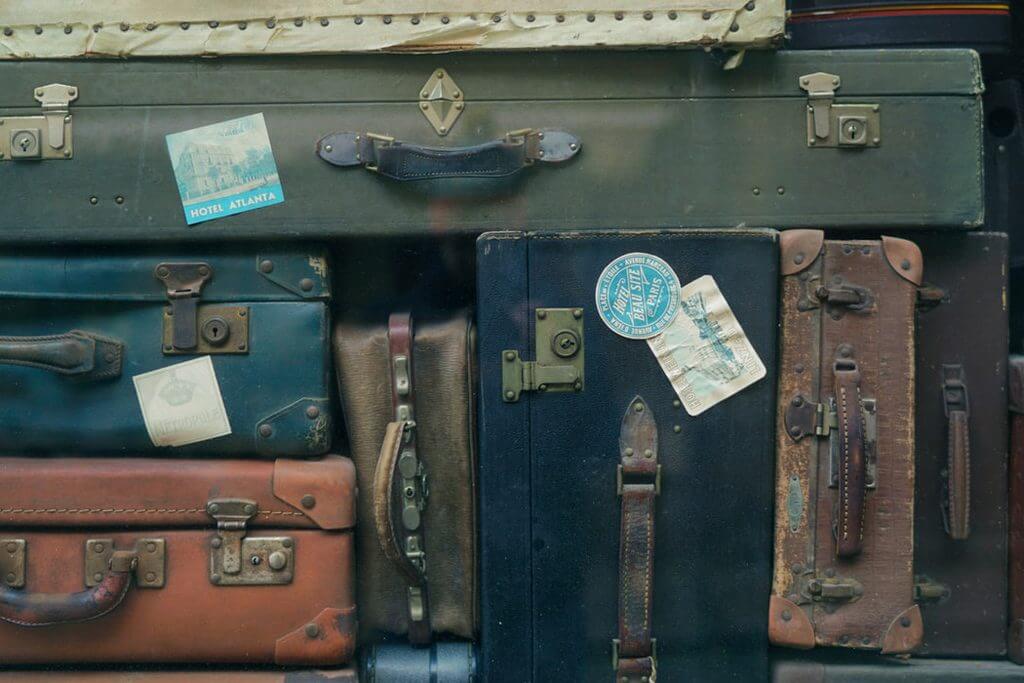
There are a range of different rail passes that you can use to travel France by train. Some passes are solely for train travel in France, while others allow you to travel in France and other European countries. What pass is best for you really depends upon your individual travel plans.
There are various benefits to having a rail pass as opposed to purchasing point-to-point tickets as you go, such as:
- Convenience – no need to purchase train tickets every time you want to take a train.
- Flexibility – given a rail pass provides you with unlimited train travel you can just turn up at the station whenever you like and catch the next train. If you miss a train – no problem catch the next one.
- Save money – this is the main reason people purchase a rail pass. Unless you book your tickets well in advance, last-minute train tickets can be crazy expensive. By having a pass with unlimited travel, you will, in many cases, save money.
- Discounts: many rail passes come with other inclusions of discounts for attractions or other modes of transport.
1. Interrail Pass One Country
For those only traveling in France, the Interrail Pass, One Country is the way to go. This France rail pass provides you with unlimited train travel in France (all France trains, including the TGC, TER, Intercity, etc.) – there is absolutely no limit to the number of times you take a train on any given day.
You can choose a France rail pass based on the number of travel days you will have in France. You can choose from 1 to 8 days of travel within a month. You can also choose to travel first or second class.
Interrail Pass can only be used by European citizens or permanent residents in Europe. If you are a UK resident, you can use this pass too.
When it comes to regional and local trains, just jump on board and sit wherever you like. For fast trains, in most cases, a seat reservation is required in addition to your pass.
With the Interrail Pass One Country , you will also receive discounts on various museums, attractions, cruises, ferries, buses, and hotels.
2. Eurail Global Pass – Multi-Country Pass
If you are visiting France as well as neighboring countries, then the Eurail Global Pass is the better rail pass option. Indeed, with this multi-country train pass, Europe has no secrets for you! This pass provides you will unlimited travel in 31 different European Countries (including France) – there is absolutely no limit to the number of times you take a train on any given day.
You can choose the best train pass for Europe based on how many travel days you will have in Europe. Choose either 3, 5, or 7 days of travel within a month or 10 or 15 days of travel within two months. If you travel by train more frequently, you can also buy a consecutive day travel pass of 15 days, 22 days, one month, two months, or even three months. You can also choose to travel first or second class.
While some trains you can just jump on board and sit wherever you like, remember other trains require you to have a seat reservation in addition to your pass.
How to Use Rail Passes
Generally, most rail passes are still paper-based and require you to write the date of your travel before the first trip of each day. You then simply board the train. If you have made a seat reservation (remember this is mandatory for some trains), you need to find this seat and sit there for the duration of your train trip.
Ticket inspectors will come through the train periodically and ask to see your ticket. You simply show them your rail pass and seat reservation (if you have one).
To make your train travel in France enjoyable, here are a few additional tips:
1. Train Strikes in France
Train strikes in France can be a major inconvenience, especially if you’re caught off-guard. I tell you all about train strikes in France – strike dates and the best tips to deal with them – in this article about French Train Strikes .
2. Arrive Early at the Station
There is nothing worse than arriving a few minutes before your train is about to depart and having no idea where to go. France train stations can be huge places, and it can be a little daunting to navigate your way around.
Arrive at least 15-20 minutes (perhaps more in huge train stations like Gare du Nord in Paris) before your train is due to depart. This will give you enough time to check the large screens and see which platform your train is leaving from and then find the platform. Once you arrive at the platform, there is often a sign indicating where the train’s carriages are so that you can wait in the appropriate place for easy boarding.
If this is your first time catching a train in Europe, or if you don’t speak French, I’d even recommend giving yourself an extra 10 minutes until you get the hang of things.
3. Bring Snacks for the Train
This is particularly important for long-distance trains. While most trains have a trolley cart that comes around or even a café on board, sometimes, for whatever reason, the trolley doesn’t come, or the café is closed. Even when they are open, they may not have your favorite drink or anything you like. Plus, the food and drinks tend to be expensive.
Most train stations have various convenience stores where you can pick up food and drinks before boarding the train.
4. Validate Tickets before Boarding
If you use point-to-point tickets on regional and local trains, you must validate your ticket before boarding the train. Usually, there is a machine just before you enter the platform where you insert your ticket.
If you are using a pass, nothing is required except boarding the train. If in doubt, always ask the station staff before boarding the train.
5. Never Leave Unattended Luggage
It can be tempting to briefly leave your bag while you walk to a nearby shop for a bottle of water, but you should never leave your luggage unattended – even for a second. Unfortunately, thieves are everywhere, and they are well experienced with taking bags in a split second.
It is also recommended that you store your luggage within eyesight on board the train instead of in the dedicated spaces between the seats and the doors. In most cases, you should be able to store your luggage in the compartments above your seat or below your seat.
When I take a train in France, I never leave my suitcase in the compartments between the seats and the doors.
6. Making Train Connections
Unlike flight connections, you really don’t need much time between train connections. Sometimes, a train connection might involve walking to the other side of the platform. However, at other times you will need to walk from one end of the train station to the other, so leave yourself plenty of time to make your connection – 10 minutes should be plenty.
And there you have it, a quick guide to trains in France. I hope that this guide to the train system in France will help you with getting around France by train. Bon voyage!
Back to Homepage
Pin it Now & Read it Later
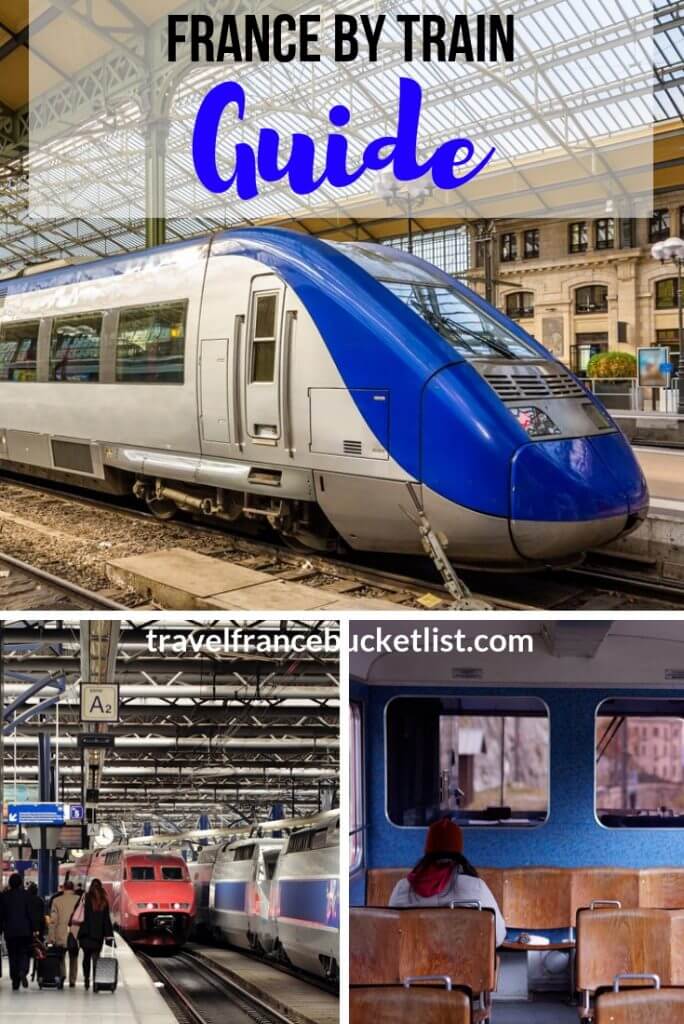
Disclaimer: This article may contain compensated links, meaning we get a small commission if you make a purchase through our links. It costs you nothing more (in fact, if anything, you’ll get a nice discount) but helps us to go on creating incredible French content for you. We trust all products and brands promoted here and would never recommend anything that isn’t of value. Please read disclaimer for more info.
(C) Copyright 2019 - 2024 France Bucket List. All Rights Reserved. Designed & Developed by France Bucket List || Disclaimer || Privacy Policy || Contact |
Country and language
United Kingdom
United States
Deutschland
@media (max-width: 37.5rem){.css-vo707v{font-size:1.5rem;}} Log in
@media (max-width: 52.5rem){.css-1qvpg8e{font-size:1.375rem;}} no account.
Join Club Eurostar for FREE
- Travelling with Eurostar
- Frequent travellers
- Manage your booking
Frequent or Premium Pass
Please log in to use your subscription pass.

London to Paris trains
Take a direct Eurostar train from London to Paris in just 2 hours and 16 minutes.
2hrs 16mins
No airport transfers, no time wasted
City centre
to city centre travel
Our tickets are now more flexible than ever before. And from 4 November, you’ll be travelling in our new travel classes Eurostar Standard, Eurostar Plus, or Eurostar Premier.
Take a train from London to Paris
Travelling from London to Paris with us is simple, smart, and speedy. Go direct from city centre to city centre in just 2hrs 16mins. And whether you’re going for work or play, we’ll get you there feeling relaxed and rested. Read on to discover why taking Eurostar from London to Paris is the only way to travel.
High-speed train from London to Paris
To start your journey, get to London St Pancras International at our recommended arrival time to allow plenty of time to go through border controls and security. This elegant historic 19th-century station is conveniently located in the heart of London and is well connected by underground lines and buses. Before you jump on one of our Eurostar trains you can indulge in some boutique shopping, experience fine dining at a world-class brasserie or enjoy a glass of bubbly at the longest champagne bar in Europe.
On board our direct London to Paris train
Travelling with Eurostar is simple, affordable and relaxing. You can bring two bags and one piece of hand luggage for no extra charge and with no weight limits. We won’t charge you for choosing your seats and there are no restrictions on liquids, so feel free to bring something bubbly for the journey. Find out more about our luggage allowances . Wherever you sit, you can email, tweet and post all the way with our free onboard wi-fi. You’ll find power sockets at your seat, so you can stay charged up while you relax. If you find yourself feeling peckish, you can enjoy a range of hot and cold drinks and sweet and savoury snacks at Eurostar Café . And if you’re travelling in Standard Premier or Business Premier, you’ll be served a three-course meal at your seat. Find out more about our food on board . Whether you’re travelling for work, a special occasion, or heading away on a budget break, we’ve got the travel class for you. Check out our seats in Standard , Standard Premier and Business Premier .
Arriving at Paris Gare du Nord from London St Pancras
Your train will arrive at Paris Gare du Nord , conveniently located in the heart of the city and just a short stroll from some of the city's top attractions, including Montmartre and the Sacré-Coeur. With a neoclassical 19th-century façade, Gare du Nord is one of Paris’s main stations, with connections for the metro, RER trains and local buses.
Timetables for trains from London to Paris
Thursday, May 2, 2024
See full timetable
Frequently asked questions
.css-5vuhm9{display:-webkit-box;display:-webkit-flex;display:-ms-flexbox;display:flex;-webkit-box-pack:justify;-webkit-justify-content:space-between;justify-content:space-between;-webkit-align-items:center;-webkit-box-align:center;-ms-flex-align:center;align-items:center;max-width:100%;border:none;text-align:left;width:100%;background:none;cursor:pointer;position:relative;padding:1.5rem 1rem;}.css-5vuhm9:hover{-webkit-text-decoration:underline;text-decoration:underline;text-decoration-color:#00286a;}.css-5vuhm9:focus-visible{border-radius:1px;outline:2px solid #00286a;outline-offset:2px;}@media (min-width: 37.5rem){.css-5vuhm9{padding:1.5rem;}} .css-4ujqbu{height:0.188rem;display:block;position:absolute;left:0;right:0;top:0;margin:-2px 0 0;opacity:0.4;border-bottom:2px solid #00286a;border-radius:60%;} .css-1ro6ief{--grid-columns:12;--grid-columnspacing:0rem;--grid-rowspacing:0rem;-webkit-flex-direction:row;-ms-flex-direction:row;flex-direction:row;min-width:0;box-sizing:border-box;display:-webkit-box;display:-webkit-flex;display:-ms-flexbox;display:flex;-webkit-box-flex-wrap:wrap;-webkit-flex-wrap:wrap;-ms-flex-wrap:wrap;flex-wrap:wrap;margin:calc(var(--grid-rowspacing) / -2) calc(var(--grid-columnspacing) / -2);-webkit-box-pack:justify;-webkit-justify-content:space-between;justify-content:space-between;width:100%;padding:0rem;} .css-1fiqx1u{--grid-columns:12;--grid-columnspacing:0rem;--grid-rowspacing:0rem;-webkit-box-flex:0;-webkit-flex-grow:0;-ms-flex-positive:0;flex-grow:0;-webkit-flex-basis:auto;-ms-flex-preferred-size:auto;flex-basis:auto;width:calc(100% * 10 / var(--grid-columns));-webkit-flex-direction:row;-ms-flex-direction:row;flex-direction:row;min-width:0;box-sizing:border-box;display:-webkit-box;display:-webkit-flex;display:-ms-flexbox;display:flex;-webkit-box-flex-wrap:wrap;-webkit-flex-wrap:wrap;-ms-flex-wrap:wrap;flex-wrap:wrap;margin:calc(var(--grid-rowspacing) / -2) calc(var(--grid-columnspacing) / -2);-webkit-box-pack:justify;-webkit-justify-content:space-between;justify-content:space-between;}@media (min-width:37.5rem){.css-1fiqx1u{-webkit-box-flex:0;-webkit-flex-grow:0;-ms-flex-positive:0;flex-grow:0;-webkit-flex-basis:auto;-ms-flex-preferred-size:auto;flex-basis:auto;width:calc(100% * 12 / var(--grid-columns));}} .css-2pnwxm{--grid-columns:12;--grid-columnspacing:0rem;--grid-rowspacing:0rem;-webkit-box-flex:0;-webkit-flex-grow:0;-ms-flex-positive:0;flex-grow:0;-webkit-flex-basis:auto;-ms-flex-preferred-size:auto;flex-basis:auto;width:calc(100% * 12 / var(--grid-columns));-webkit-flex-direction:row;-ms-flex-direction:row;flex-direction:row;min-width:0;box-sizing:border-box;display:-webkit-box;display:-webkit-flex;display:-ms-flexbox;display:flex;-webkit-box-flex-wrap:wrap;-webkit-flex-wrap:wrap;-ms-flex-wrap:wrap;flex-wrap:wrap;margin:calc(var(--grid-rowspacing) / -2) calc(var(--grid-columnspacing) / -2);-webkit-align-items:center;-webkit-box-align:center;-ms-flex-align:center;align-items:center;}@media (min-width:37.5rem){.css-2pnwxm{-webkit-box-flex:0;-webkit-flex-grow:0;-ms-flex-positive:0;flex-grow:0;-webkit-flex-basis:auto;-ms-flex-preferred-size:auto;flex-basis:auto;width:calc(100% * 10 / var(--grid-columns));}} .css-11yytic{font-family:'abc social bold','arial','sans-serif';font-weight:normal;color:#00286a;text-align:left;margin-top:0;margin-bottom:1rem;-webkit-font-smoothing:antialiased;font-size:1.25rem;line-height:1.5rem;color:#00286aimportant;margin:0remimportant;display:blockimportant;}@media (min-width: 52.5rem){.css-11yytic{font-size:1.375rem;}} how much is a train ticket from london to paris .css-1k89mew{--grid-columns:12;--grid-columnspacing:0rem;--grid-rowspacing:0rem;-webkit-box-flex:0;-webkit-flex-grow:0;-ms-flex-positive:0;flex-grow:0;-webkit-flex-basis:auto;-ms-flex-preferred-size:auto;flex-basis:auto;width:calc(100% * 12 / var(--grid-columns));-webkit-flex-direction:row;-ms-flex-direction:row;flex-direction:row;min-width:0;box-sizing:border-box;display:-webkit-box;display:-webkit-flex;display:-ms-flexbox;display:flex;-webkit-box-flex-wrap:wrap;-webkit-flex-wrap:wrap;-ms-flex-wrap:wrap;flex-wrap:wrap;margin:calc(var(--grid-rowspacing) / -2) calc(var(--grid-columnspacing) / -2);-webkit-align-items:center;-webkit-box-align:center;-ms-flex-align:center;align-items:center;}@media (min-width:37.5rem){.css-1k89mew{-webkit-box-flex:0;-webkit-flex-grow:0;-ms-flex-positive:0;flex-grow:0;-webkit-flex-basis:auto;-ms-flex-preferred-size:auto;flex-basis:auto;width:calc(100% * 1 / var(--grid-columns));}}@media (min-width:0rem){.css-1k89mew{-webkit-box-pack:start;-ms-flex-pack:start;-webkit-justify-content:flex-start;justify-content:flex-start;}}@media (min-width:37.5rem){.css-1k89mew{-webkit-box-pack:end;-ms-flex-pack:end;-webkit-justify-content:flex-end;justify-content:flex-end;}} .css-h58ukj{--grid-columns:12;--grid-columnspacing:0rem;--grid-rowspacing:0rem;-webkit-box-flex:0;-webkit-flex-grow:0;-ms-flex-positive:0;flex-grow:0;-webkit-flex-basis:auto;-ms-flex-preferred-size:auto;flex-basis:auto;width:calc(100% * 2 / var(--grid-columns));-webkit-flex-direction:row;-ms-flex-direction:row;flex-direction:row;min-width:0;box-sizing:border-box;display:-webkit-box;display:-webkit-flex;display:-ms-flexbox;display:flex;-webkit-box-flex-wrap:wrap;-webkit-flex-wrap:wrap;-ms-flex-wrap:wrap;flex-wrap:wrap;margin:calc(var(--grid-rowspacing) / -2) calc(var(--grid-columnspacing) / -2);-webkit-align-items:center;-webkit-box-align:center;-ms-flex-align:center;align-items:center;-webkit-box-pack:end;-ms-flex-pack:end;-webkit-justify-content:flex-end;justify-content:flex-end;} .css-19f252s{-webkit-align-self:center;-ms-flex-item-align:center;align-self:center;padding-top:2px;} .css-16gm2n{margin:0rem 0rem 0rem 1remimportant;width:1.5remimportant;height:1.5remimportant;display:inline-block;background-color:#00286a;-webkit-mask:url(https://static.eurostar.com/ui/design-system/icons/chevronbrandeddown.svg);mask:url(https://static.eurostar.com/ui/design-system/icons/chevronbrandeddown.svg);-webkit-mask-size:contain;mask-size:contain;-webkit-mask-repeat:no-repeat;mask-repeat:no-repeat;-webkit-mask-position:center;mask-position:center;-webkit-mask-size:contain;-webkit-mask-repeat:no-repeat;-webkit-mask-position:center;}@media (forced-colors: active){.css-16gm2n{background-color:buttontext;}.css-16gm2n:hover{background-color:buttontext;}}.
A Eurostar London to Paris train ticket starts from $52.
How long is the Eurostar train journey from London to Paris?
The Eurostar can take up to 2hrs 37mins from London to Paris, however, most of our trains will take you to Paris in only 2hrs 16mins.
How early should you arrive for the Eurostar train from London to Paris?
Get to St Pancras International at our recommended arrival time to allow plenty of time to get through border controls and security.
How much luggage can I bring with me on the Eurostar London to Paris train?
Standard adult tickets allow you to bring two pieces of luggage that are up to 85cm long, and one small piece of hand luggage such as a handbag or briefcase. You can find out more information about luggage allowances here .
Are there additional fees when travelling with the Eurostar London to Paris?
Unlike airlines, there are no hidden costs when travelling by Eurostar. Once you have picked your train tickets ( Standard , Standard Premier or Business Premier ), there will be no additional fees for seat selection, advanced booking, or luggage allowance .

Can you take liquids on the Eurostar London to Paris train?
You can take liquids on the London to Paris Eurostar and there is no volume limit, so you can bring all your toiletries and even a bottle of bubbly!
Can you take your own food on the London to Paris train?
There are no food restrictions, so you’re allowed to bring your own food from home on the Eurostar.
You may also like

Paris to London trains
Art and culture, theatre and shopping, leafy parks and riverside strolls – the only tricky bit’s deciding where to start.

City breaks in Paris
Paris is all about people watching, as you drink coffee on a café terrace.
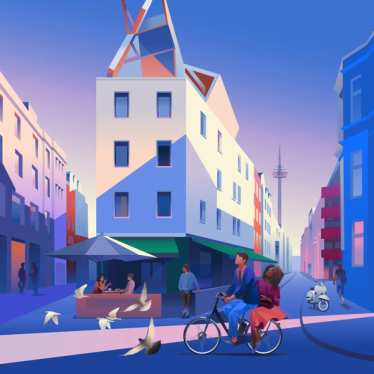
All Eurostar trains
Discover Europe’s best destinations with Eurostar across France, Belgium, the Netherlands, Germany and the UK.
*Terms and conditions

The Man in Seat 61
How to travel by train from
London & uk to france.
- Buy train tickets
- Buy ferry tickets
- Book a hotel
- Privacy & cookies
- Home
Train travel UK & Ireland...
Train travel in europe..., train travel in asia..., train travel in africa..., train travel in america..., train travel in australasia, take a high-speed train to france.
It's the civilised alternative to flying. Take Eurostar from London to Lille or Paris, then a 300 km/h TGV (Train à Grande Vitesse) through the French countryside with a glass of red wine to hand from Lille or Paris to Avignon, Marseille, Nice, Nîmes, Montpellier, Perpignan, Lyon, Bordeaux, Toulouse, Rennes or Nantes... It's affordable, too: London to Paris from £52 one-way or £78 return, Paris to Bordeaux, Lyon, Nice, or Perpignan from around €29 each way. Centre to centre, no baggage fees, no airport taxes, significantly less impact on the environment & infants go free.
Choose your destination: London to... Agde Aime la Plagne Aix en Provence Aix les Bains Ajaccio Amiens Angers Angouleme Annecy Antibes Avignon Bastia Bayonne Beaulieu sur Mer Beziers Biarritz Bordeaux Boulogne Bourg st Maurice Brive la Gaillard Caen Cahors Calais Cannes Carcassonne Chambéry Chamonix Cherbourg Corsica Dax Disneyland Paris Etaples Juan les Pins Le Havre Le Mans Les Arcs (Alps) Le Touquet Lille Lourdes Limoges Lyon Marseilles Menton Méribel Monaco - Monte Carlo Montpellier Mont St Michel Moutiers Nancy Nantes Narbonne Nice Nîmes Paris (by Eurostar) Paris (by train + ferry) Perpignan Poitiers Rennes St Gervais St Jean de Luz St Malo St Lo St Raphael St Tropez Sete Strasbourg Tarbes Tignes Toulon Toulouse Trois Vallées Val d'Isere Versailles - Chateau Versailles Villefranche sur Mer Train times, fares & tickets
Train travel within France
International trains to & from france, station guides, other useful information, useful country information, london to paris, option 1, by eurostar: see the eurostar page.
Eurostar is the high-speed passenger train from London St Pancras to Paris Gare du Nord via the Channel Tunnel, taking as little as 2h15 at up to 300 km/h (186 mph). Typically, 95% of Eurostar trains run on time or within 15 minutes, against just 65%-70% of flights on the same routes, it's not surprising that Eurostar now has over 70% of the London-Paris market.
Option 2, by train & ferry : See the train & ferry page
Short breaks to paris.
A short break is sometimes cheaper than booking Eurostar & hotel separately - and if you need to travel at short notice it can even be cheaper than a regular Eurostar ticket. Try these companies:
Other UK towns & cities to Paris
Use a london international civ ticket.
After buying a Eurostar ticket from London to Lille or Paris, you can buy a separate ticket from most British stations to a special destination called London International CIV , designed for use with Eurostar.
These exist from most stations in Britain, they include the Underground across London to St Pancras and they generally have few or no time restrictions (so an off-peak price may apply even in the peak). You're covered by the international CIV conditions of carriage if there's a delay to the UK train and you miss your Eurostar, you're entitled to be re-booked on a later one. More about tickets from your local station to London International CIV .
Or book Britain to France at www.raileurope.com
Raileurope.com connects to both the British and French ticketing system, so you can book from any British station to Paris or anywhere in France as one easy transaction. It simply adds a normal domestic ticket from your chosen British station to London to an onward Eurostar from London to Lille or Paris and a French train ticket from Lille or Paris onwards. There's a small booking fee.
West of England or South Coast to Paris
Scotland to paris, belfast or dublin to paris, london to disneyland.
Eurostar Disney train discontinued: The direct Eurostar from London to Marne La Vallée for Disneyland Paris was discontinued in June 2023.
The alternative is to book a regular Eurostar from London St Pancras to Paris Nord at www.eurostar.com then use the RER (express metro) every 15 minutes between Paris Nord and Marne-la-Vallée-Chessy (Disneyland), changing at Châtelet les Halles or Gare de Lyon, journey time about 58 minutes, fare a few euros (see www.ratp.fr ).
OR you can use www.raileurope.com to book a journey from London to Marne la Vallée by Eurostar and French TGV train with one easy change at Lille .
See www.disneylandparis.com to book holidays and short breaks to Disneyland Paris, including the Eurostar, hotel accommodation and entrance to the Disneyland park or buy Eurostar tickets separately at www.eurostar.com .
Back to top
London to Versailles
The famous Chateau de Versailles ( www.chateauversailles.fr ) is 30-40 minutes southwest of central Paris using a frequent express metro train on RER line C to Versailles-Rive Gauche station. Versailles-Rive Gauche is 5 minutes' walk from the entrance to the Chateau. Just buy a Eurostar ticket to Paris at www.eurostar.com then buy an RER ticket from central Paris (zone 1) to Versailles (zone 4) when you get there, the fare is just over €4 each way. RER line C runs directly to Versailles Chateau - Rive Gauche from various RER/metro stations in central Paris, including the Gare d'Austerlitz, St Michel-Notre Dame, Musée d'Orsay, Invalides, & Champ de Mars-Tour Eiffel. From the Gare du Nord, take RER line B two stops to St Michel-Notre Dame, then change onto RER line C to Versailles-Rive Gauche. See www.ratp.fr for a plan of the RER & metro network You can check RER C times on this route at www.transilien.com .
Tip : A nicer way to reach Versailles from central Paris is to go to the Gare St Lazare and take Transilien line L to Versailles-Rive Droite. These Transilien suburban trains run every 15 minutes from platforms 1-4 at the Gare St Lazare , taking about the same time as the RER C route, but unlike RER C almost all the journey is above ground with views of wealthy Parisian suburbs, a Seine crossing, and the towers of the financial district at La Défense. You arrive at Versailles-Rive Droite which is a slightly longer walk from the chateau, but you walk through the old part of town and can enter the chateau through its gardens at the 'Bassin de Neptune' rather than through the car park as with the walk from Versailles-Rive Gauche. See www.transilien.com .
London to Nice & Cannes
It's easy to travel from the UK to Cannes, Nice or Monte Carlo by Eurostar and high-speed TGV , a chance to chill out with a good book and a glass of wine, and maybe have lunch in Paris on the way.
Which route to choose?
What's the journey to nice like.
Settle back into your seat and watch the scenery glide past with a glass of red to hand. From Lille or Paris to Lyon, the TGV passes rich farmlands and picturesque villages with pretty churches. South of Lyon, the TGV flies at ground level along the Rhône Valley, crossing and re-crossing the River Rhône on dramatic viaducts high above the valley floor, passing more pretty villages and the occasional hilltop chateau. It then passes through the hills of Provence to reach Marseille. Watch out for the huge viaduct over the Rhône just before Avignon, with views of the famous Palais des Papes in the distance to the left - though if you can spot anyone dancing sur le pont d'Avignon you have better eyesight than me. You'll see the Alpine foothills in the distance to the left, and catch a glimpse of Marseille harbour with its Chateau d'If of Count of Monte Cristo fame to the right before arriving at Marseille St Charles station. If you're bound for Cannes, Nice or Monte Carlo, the scenery along the Côte d'Azur is wonderful, as the train runs along the coast past yacht-filled harbours, beaches, rocky inlets and millionaires' villas.
The Man in Seat 61 says: "Attending a conference on the Côte d'Azur, I travelled from London to Nice by train. A morning Eurostar to Paris, lunch at the Train Bleu restaurant at the Gare de Lyon, then an afternoon TGV Duplex to the South of France, with a 1st class Club Duo seat on the upper deck. Wonderful! I put my feet up & relaxed, watched the French villages of the Rhone Valley pass by, caught up on my reading & emails and watched a movie on my iPhone. To anyone who has only known the stresses of airports, flights & motorways, chilling out on a high-speed train is a revelation..."
Watch the video: On board a double-deck TGV Duplex (Paris-Nice)
Watch the video: On board a single-deck Christian Lacroix TGV (Lille-Nice)
Option 1, London to Nice via Lille
This is the easiest option as there's no need to cross Paris, just easy same-station changes at Lille & Marseille. It's ideal if you've luggage, kids or mobility problems. Take Eurostar from London St Pancras to Lille Europe and change onto a direct TGV to Marseille St Charles by-passing Paris, then take another TGV from Marseille to Toulon, St Raphael, Cannes, Antibes or Nice. For a wider choice of departures and in many cases cheaper fares, also check out journeys via Paris in option 2 below . Tips for changing trains at Lille . Unfortunately, SNCF discontinued the daily direct Lille-Nice TGV in December 2018.
Timetable outward 2024
Timetable inward 2024, notes for the timetable.
How to read these timetables : It's easy, you read downwards, each column is a journey you can take. You change trains at each grey bar.
Always check times for your specific dates using www.raileurope.com or www.thetrainline.com , as the times shown here can vary. Don't book any Eurostar tickets until you have confirmed onward train times. Eurostar doesn't run on 25 December.
How much does it cost?
London to Lille by Eurostar starts at £52 one-way, £78 return standard class or £97 one-way, £168 return in standard premier (1st class).
Lille to Marseille by TGV starts at €20 each way.
Marseille to Cannes or Nice starts at €15 each way.
Fares vary like air fares, increasing as the cheaper seats are sold, so book ahead & look for the cheapest departures. Check the online booking system to see prices for your date of travel. Children under 4 go free.
How to buy tickets
Using an interrail pass, what are the trains like.
1. London to Lille by Eurostar
Eurostar trains link London & Lille in 1h22, travelling at up to 300 km/h (186 mph). There are two bar cars, power sockets at all seats and free WiFi. Standard Premier and Business Premier fares include a light meal with wine (or breakfast, on departures before 11:00). There's a 30-minute minimum check-in, as all border formalities are carried out before you board the train. More about Eurostar & check-in procedure . St Pancras station guide . Lille station guide & tips on changing trains .
2. Lille to the South of France by TGV
TGV or Train á Grande Vitesse is French Railways high-speed train, with 1st & 2nd class and a cafe-bar. They come in various types, some single-deck, some double-deck TGV Duplex, you could get either on cross-France routes from Lille. Most have power sockets at seats, most now have free WiFi. The photos below show a single-deck TGV with the Christian Lacroix designer interior. The direct TGVs from Lille by-pass Paris on a high-speed avoiding line via Charles de Gaulle Airport station. More about TGV .
Option 2, London to Nice via Paris
This is the fastest & most frequent option, if you don't mind changing trains & stations in Paris . It's usually cheaper than going via Lille, too. Take Eurostar from London St Pancras to Paris Gare du Nord in just 2h20, change stations in Paris by metro or taxi as explained here , then take a 300 km/h double-deck TGV Duplex from Paris Gare de Lyon to Nice in as little as 5h40. A same-station change in Lille may be easier, but you'll find a wider range of departures via Paris, and usually cheaper fares available. Why not take an earlier Eurostar and have lunch at the fabulous Train Bleu restaurant inside the Gare de Lyon before chilling out on an afternoon TGV Duplex to the Sunny South of France? For an account of the journey in pictures, see the Paris to Nice by train page .
How to read these timetables : It's easy, you read downwards, each column is a journey you can take. You change trains at the grey bar.
You don't have to book the exact Eurostar I show above as connecting with that particular TGV. Eurostar links London & Paris almost every hour, by all means book an earlier Eurostar outward or a later one back if it has cheaper fares or you want to spend time in Paris. Lunch at the Train Bleu restaurant at the Gare de Lyon ?
Always check times for your specific date using www.raileurope.com , www.th etrainline.com or www.sncf-connect.com as times can vary. Don't book a Eurostar ticket until you have confirmed onward times. Eurostar doesn't run on 25 December. How to reach St Tropez, Monte Carlo, Juan les Pins, Menton
London to Paris by Eurostar starts at £52 one-way or £78 return in standard class, £97 one-way, £168 return standard premier (1st class).
Paris to Cannes or Nice starts at €29 each way in 2nd class or €49 in 1st class.
Like air fares, fares increase as the cheaper seats are sold, so book early & shop around for the cheapest departure. Check the online booking system to see prices for your date of travel. Children under 4 go free.
1. London to Paris by Eurostar
Eurostar trains link London & Paris in 2h20, travelling at up to 300 km/h (186 mph). There are two bar cars, power sockets at all seats and free WiFi. Standard Premier and Business Premier fares include a light meal with wine (or breakfast, on departures before 11:00). There's a 30-minute minimum check-in as all border formalities are carried out before you board the train. More about Eurostar & check-in procedure . St Pancras station guide . Paris Gare du Nord station guide . How to cross Paris by metro or taxi .
2. Paris to Cannes or Nice by TGV Duplex
TGV or Train á Grande Vitesse is French Railways high-speed train, with 1st & 2nd class seats, free WiFi, power sockets at all seats and a cafe-bar. The direct Paris-Nice trains are operated by double-deck TGV Duplex trains which reach 300km/h (186 mph) on the high-speed line before slowing right down to travel from Marseille to Cannes & Nice over the classic line along the coast, with great views of rocky headlands, yacht-filled bays and millionaires' villas. More about Paris-Nice TGV Duplex trains . Paris Gare de Lyon station guide .
Option 3, London to Nice by sleeper
Discontinued in December 2017 along with other popular French night trains, the French government has now restored the most important night train services as a climate-friendly alternative to flying. First to be restored, the Paris-Nice Intercité de Nuit made a welcome return in April 2021. Take an afternoon Eurostar from central London, dinner in Paris ( see my suggested restaurants here ), then sleep your way south in a couchette to Toulon, Cannes, Antibes or Nice. Why not go one-way by sleeper and the other way by TGV? Watch the video .
London ► Toulon, Cannes, Antibes, Nice
Step 1, travel from London to Paris by Eurostar , normally leaving London St Pancras at 14:31 arriving Paris Gare du Nord 17:48.
Eurostar has two cafe-bars, power sockets at all seats & free WiFi. Standard Premier & Business Premier fares include a meal with wine.
Transfer from Paris Gare du Nord to Paris Gare d'Austerlitz by metro or taxi as explained here .
By all means book an earlier Eurostar and have dinner at the celebrated Train Bleu restaurant at the Gare de Lyon before strolling across the bridge over the Seine to the Gare d'Austerlitz in good time for your sleeper south. Or try the floating restaurant Off Paris Seine , next to the Gare d'Austerlitz.
Step 2, travel from Paris to the Côte d'Azur by Intercité de Nuit sleeper train , leaving Paris Gare d'Austerlitz at 20:08 every day, arriving Toulon 07:39, St Raphael ( for St Tropez ) 08:33, Cannes 08:57, Antibes 09:08 & Nice Ville 09:25.
The Intercité de Nuit has 1st class 4-berth couchettes, 2nd class 6-berth couchettes & reclining seats. You can book a 1st class 4-berth compartment for sole occupancy by 1, 2 or 3 people if you like. More about Intercités de Nuit .
Next morning it's a lovely scenic run along the coast between Toulon & Nice, past rocky headlands, millionaires' villas & yacht-filled harbours.
Nice, Antibes, Cannes, Toulon ► London
Step 1, travel from the Côte d'Azur to Paris by Intercité de Nuit sleeper train , leaving Nice Ville at 19:07, Antibes 19:36, Cannes 19:48, St Raphael 20:13 & Toulon 21:12, arriving Paris Gare d'Austerlitz at 07:53 next morning.
Transfer from Paris Gare d'Austerlitz to Paris Gare du Nord by metro or taxi as explained here .
Step 2, travel from Paris to London by Eurostar , leaving Paris Gare du Nord at 11:12 arriving London St Pancras 12:30.
Eurostar has two cafe-bars, power sockets at all seats & free WiFi. Standard Premier & Business Premier fares include lunch with wine.
Paris to Cannes or Nice by sleeper train starts at €19 in a reclining seat, €29 in a 2nd class couchette or €59 in a 1st class couchette.
Book at www.raileurope.com or www.thetrainline.com , both easy to use, in €, £ or $, overseas credit cards no problem, small booking fee or at French Railways website www.sncf-connect.com (in €, no booking fee).
To make sure you have at least 90 minutes between trains in Paris, I'd book London to Paris (and back, if returning), add to basket, then Paris to Nice one-way, add to basket, then Nice to Paris one-way, add to basket & check out.
Otherwise the system allows as little as 40 minutes between trains in Paris, which is too tight, especially when catching a sleeper you don't want to miss.
2. Paris to Cannes or Nice by Intercité de Nuit
The intercité de nuit overnight train has 1st class couchettes in 4-berth compartments & 2nd class couchettes in 6-berth compartments, each berth supplied with lightweight sleeping-bag, mineral water, amenities kit, reading light & power socket. There are toilets & washrooms at the end of the corridor, and free WiFi. More about intercités de nuit . Watch the video guide . Paris Austerlitz station guide .
Option 4, London to Nice by lo-cost Ouigo
In 2013, French Railways launched a budget-airline-on-rails called Ouigo . Ouigo offers two lo-cost no-frills one-class trains a day from Paris to Cannes & Nice using special double-deck TGV Duplex trains with no catering & no 1st class. Like budget airlines, there are baggage limits and extra fees for large or additional bags. See more about Ouigo including travel tips & luggage limits and the Man in Seat 61's opinion of Ouigo .
You can use a Eurostar ticket from London to Paris plus a lo-cost Ouigo ticket from Paris to Toulon, Cannes, Antibes or Nice, as long as you allow plenty of time between trains in Paris, meaning 2 or 3 hours not the usual 1 hour you might allow with regular trains.
That's because Ouigo is a separate company (even though wholly-owned by SNCF French Railways). You'll have separate tickets for the Eurostar & Ouigo, Ouigo has no agreement in place with Eurostar to guarantee onward travel if there's a missed connection, unlike the Railteam arrangement which protects your connection between Eurostar and normal TGV InOui trains. So if Eurostar train runs late and you miss your Ouigo or vice versa. you may have to pay for a new ticket. It's your risk, which is why you should allow 2 or ideally 3 hours between trains in Paris, not one.
London ► Cannes, Nice
Step 1, travel from London to Paris by Eurostar , leaving London St Pancras at 10:24 arriving Paris Gare du Nord 13:50, or any earlier departure.
Transfer from Paris Gare du Nord to Paris Gare de Lyon by RER express metro as explained here .
Step 2, travel from Paris to Nice by Ouigo high-speed train , leaving Paris Gare de Lyon at 16:10 daily, arriving Toulon 20:11, Cannes at 21:27, Antibes 21:39 & Nice Ville at 21:57.
Ouigo trains are 2nd class only with no catering, so bring your own food & drink. Remember Ouigo has luggage restrictions & extra fees.
Alternatively, you can take any evening Eurostar you like to Paris, stay overnight, then take the daily 08:22 Ouigo from Paris to Cannes & Nice.
Nice, Cannes ► London
Step 1, travel from Nice to Paris by Ouigo high-speed train , leaving Nice Ville at 06:06, Antibes 06:22, Cannes 06:24 or Toulon 07:49, arriving Paris Gare de Lyon 11:46.
Transfer from Paris Gare de Lyon to Paris Gare du Nord by RER express metro as explained here .
Step 2, travel from Paris to London by Eurostar , leaving Paris Gare du Nord at 15:03 arriving London St Pancras at 16:39.
Alternatively, you can leave Nice on the later Ouigo at 15:02 or Cannes at 15:32 arriving Paris Gare de Lyon at 20:38. Stay overnight in Paris, then take any morning Eurostar you like back to London.
Paris to Cannes or Nice by Ouigo starts at just €19 each way. Plus €5 baggage fee for larger bags, see the Ouigo page for full details .
Step 1, go to www.eurostar.com and book a Eurostar from London to Paris.
Step 2, go to www.sncf-connect.com and book Ouigo from Paris to Cannes or Nice.
This shows both Ouigo and regular TGVs so you can compare prices. Check baggage limits carefully, you may need to pay an extra fee.
Ouigo Essentiel or Ouigo Plus? If you pay the Ouigo Essentiel fare, then you can pay an extra fee to have a larger bag with you and another fee to choose a seat. If you pay the extra for Ouigo Plus , the bag fee and the seat choice fee are included, along with a faster boarding line at Paris stations and some streaming content on the WiFi.
Tip: Only credit/debit cards issues in European & certain other countries such as Australia & the USA are accepted for Ouigo bookings, but if you buy Ouigo tickets from www.thetrainline.com (which also sells Eurostar tickets and is easy to use, recommended, just a small booking fee to pay) you can pay via PayPal which gets round this, see the Ouigo page for more about Ouigo tickets .
2. Paris to Cannes or Nice by Ouigo
Ouigo is a subsidiary company of SNCF French Railways, set up as a budget airline on rails. It uses double-deck TGV Duplex trains, but one class only, with no 1st class, no catering, airline-style baggage limits and a 30-minute check-in. More about Ouigo . Paris Gare de Lyon station guide .
Connections on the Cote d'Azur
Step 1, take the train from London to St Raphael as shown above .
Step 2, travel from St Raphael to St Tropez by bus, departure every hour or two, journey time around 1h15-1h30, fare €2.10.
Buses leave St Raphael bus station (Gare Routière in French, right next to the railway station) and arrive at St Tropez bus station. See zou.maregionsud.fr for bus times (English selector at the bottom of the page or click menu and look for the English selector). You can use the journey planner or click menu then schedules and enter bus 876 .
You can buy a ticket on the bus or use the Zou app on your phone to buy a ticket after registering for an account, see zou.maregionsud.fr .
Be warned that traffic into St Tropez in high summer can be a nightmare, with major delays.
There's also a ferry twice a day from April to November, see www.bateauxsaintraphael.com - much more expensive than the bus but a good way to make an excursion that avoids all the summer traffic.
Juan les Pins, Villefranche sur Mer, Beaulieu sur Mer
These all have railway stations on the Cannes-Nice-Monaco main line, served by hourly local trains, but long-distance trains don't stop there. So for Juan les Pins, travel to Antibes and switch to a local train there, journey time 5 minutes. For Villefranche and Beaulieu, travel to Nice and change to a local train there.
Monaco-Monte Carlo, Menton & Ventimiglia
Frequent local trains link Nice with Monte Carlo, Menton and Ventimiglia on the Italian border, roughly every half hour. Nice to Monte Carlo takes 21 minutes, Nice to Ventimiglia takes 48 minutes.
How to buy train tickets to France
You can buy train tickets to anywhere in France, either at www.raileurope.com or www.thetrainline.com .
Option 1, buy at Raileurope.com
Go to www.raileurope.com
Raileurope.com connects to the British & French ticketing systems, so you can buy all your tickets in one place, in plain English, in €, £ or $. There's a small booking fee. You print your own tickets or can show them on your phone. Who are Raileurope.com?
When does booking open?
Eurostar opens 6 months ahead, sometimes up to 11 months. French trains usually open 4 months ahead, often longer over the summer. I'd wait until all your trains are open for sale, so you can confirm times & prices before buying a non-refundable Eurostar ticket.
There's an annual timetable change on the second Saturday in December, bookings for dates after this (including Christmas & New Year) usually open in mid-October.
More about when train bookings open . You can reserve accommodation before booking your trains risk-free using www.booking.com with free cancellation.
Fares vary like air fares, so book ahead
Fares for Eurostar & French long-distance trains are dynamic like air fares, so book early and search for the cheapest departures. The cheapest tickets mean no refunds, no changes.
Out one way, back another?
You can go out one way & back another if you like. Almost all European trains are priced one-way where a return is simply two one-ways. I often find it easier to book one way at a time.
How to book
You can easily travel from London to most French destinations in a day and you can book that as one seamless transaction, as shown in method 1.
Method 2 gives you more control and can cope with more complex journeys, including ones involving an overnight stop in Paris on the way out or the way back, or circular journeys.
Incidentally, there are no through tickets from London beyond Paris, you always get a Eurostar ticket to Paris or Lille and separate onward French tickets. But connections across Paris or in Lille are protected by the Railteam/HOTNAT and AJC .
1. Set up an enquiry from London to your French destination, number of passengers, date of travel, set a suitable morning or early afternoon departure time.
2. If you're returning and will also be travelling back in a single day, enter your return date with suitable morning or early afternoon departure time.
On French trains a return is two one ways. But on Eurostar, return fares are significantly cheaper than two one ways so a round trip that includes Eurostar should always be booked as a return.
3. If you want to travel via Lille:
A same-station change in Lille is much easier than changing stations in Paris when travelling to places such as Lyon, Avignon, Marseille, Cannes, Nice, Nimes & Montpellier, Le Mans, Nantes or Rennes. If going via Lille is an option, timings will be shown in the relevant section on this page.
To find journeys via Lille, click More options and enter Lille Europe as a via station leaving stopover duration as zero. Look in the search results for journeys that involve a change in Lille and which by-pass Paris. If necessary, try different departure times.
For places such as Orleans, Vichy, Clermont Ferrand, Limoges & Toulouse there are no direct services from Lille so it's better to go via Paris.
4. If you want to travel via Paris:
You'll usually find a wider choice of departures and often cheaper fares via Paris.
If you're going via Paris, click More options and enter Paris Nord as a via station with stopover duration set to 1 hour (this guarantees a minimum acceptable 1 hour between trains in Paris) or 2 hours (a more robust connection, recommended) or (if you want to have lunch in Paris, perhaps at the wonderful Train Bleu restaurant ) 3 hours. If you don't do this, the system may offer risky cross-Paris connections as tight as 42 minutes. Advice on crossing Paris .
5. If you want to go out via Lille, back via Paris (or vice versa), don't add any via station. Rail Europe's system is capable of offering the cheaper Eurostar return rate even if the outward journey is London-Lille and the return is Paris-London, or vice versa.
6. Run the enquiry. As a general rule, look in the search results for journeys with fewest changes, ideally 1. Add to basket.
First, read the relevant destination section on this page and find a train service that suits you, out & back. By all means go out one way and back another, or go outward direct, back with an overnight stop in Paris, whatever.
Note down each individual train you want to book, on what specific date. Then go to www.raileurope.com
Step 1, book your chosen train from Lille or Paris to your French destination, one-way, and add to basket.
Step 2, if you're returning, book your chosen train from your French destination to Paris or Lille, one-way, and add to basket. Confirm times.
Step 3, book the Eurostar from London to Lille or Paris & back as a round trip and add to basket.
Eurostar return fares are significantly cheaper than two one ways, so a round trip on Eurostar should always be booked as a return.
Use the suggested Eurostar times on this page as a guide, but by all means book an earlier Eurostar than the one I suggest going out, or a later one coming back, if you'd prefer a more robust connection (as I do), if the fare is cheaper, or if you want to have lunch in Paris (also me!).
Just remember that with this method, it's up to you to make sure there's at least 60 minutes between trains in Paris southbound, 90 minutes northbound (including the Eurostar check-in), ideally 2 hours. In Lille, 25 minutes is sufficient southbound, 40 minutes northbound.
Incidentally, you can't book an 'open jaw' return out to Lille, back from Paris so if you're going to use Method 2, stick to either Paris OR Lille.
Travelling from the UK regions
Raileurope can book journeys starting from any British station, not just London. It allows about an hour for Eurostar check-in.
However, consider booking from London to France first, then buying a separate ticket from your local station to London. There are 2 reasons to do this: First, you might want a more robust connection between trains in London, say 2 hours. Second, Raileurope doesn't sell the special tickets to London International CIV which can sometimes save you money in the weekday morning peak, learn about these here .
Child fares & infants
Children under 12 travel at the child rate on Eurostar and on French trains.
Infants under 4 travel free on Eurostar and French trains, no need to buy them a ticket, just bring them along. But they don't get their own seat.
Tip: You can give an infant their own seat on French TGV and Intercités for €9 with a Billet Bambin . Just add the infant to your booking with their correct age.
Choose an upper deck seat on a TGV Duplex
An upstairs seat gives the best views on a double-deck TGV Duplex , these operate most services from Paris to Lyon, Avignon, Marseille, Montpellier, Nice. www.raileurope.com allows you to choose upper or lower deck. Seats 11-58 = lower deck. 61-128 = upper deck.
Sole occupancy of a 4 or 6 berth compartment on a French overnight train
On French overnight trains you can book sole occupancy of a 4-berth 1st class couchette compartment for 1, 2 or 3 people, or of a 2nd class 6-berth couchette compartment for 4 or 5 people, by paying the Espace Privatif supplement . Unfortunately, Raileurope can't sell Espace Privatif , so book with www.thetrainline.com or www.sncf-connect.com instead.
Check if a Carte Avantage will save money
French Railways have a discount card called Carte Avantage . The saving can sometimes justify the cost of the card for just one long-distance round trip, especially if there are two of you or you're a family, or at short notice when fares are high.
A Carte Avantage Adulte costs €49 for 1 year and gives you and a companion 30% off normal fares on TGVs & Intercités for one-way journeys at weekends, or for round trips which include a Friday, Saturday or Sunday night away, or at any time if accompanied by a child under 12, see more about Carte Avantage . Up to 3 accompanying children under 12 get 60% off. You also get discounts on many TER regional trains. There are also youth & senior versions, without the weekday restrictions.
Rail Europe can't sell tickets with Carte Avantage discount, so book with www.thetrainline.com or www.sncf-connect.com instead. There's no discount on Eurostar, but you'll get any applicable discount on the French part of the journey.
To see what the saving is for your specific journey and to check if that justifies the cost of a card, go to www.thetrainline.com or www.sncf-connect.com and run an enquiry without a Carte Avantage added, then run again with a Carte Avantage Adulte added to one of the adults.
After booking, you can view & change your Eurostar seats
After you have booked a journey between London & France using www.raileurope.com , you can go to www.eurostar.com and use the Manage booking feature to view and change your Eurostar seats, see the instructions and tips for choosing seats here .
Train seat numbering plans: These plans may help: TGV seat numbering plans . Couchette numbering plans .
Luggage limits on Eurostar & on French trains .
Option 2, buy at Thetrainline.com
You can also buy tickets from London to any French destination at www.thetrainline.com .
Like Raileurope, it connects to the Eurostar & SNCF (French Railways) ticketing systems so you can easily book all your tickets in one place, in plain English, in €, £ or $ with overseas credit cards no problem. Who are Thetrainline.com?
Most of the Raileurope booking tips above also apply to booking on www.thetrainline.com .
However, Raileurope.com has a killer advantage, you can specify a via station with stopover duration. This is so useful for cross-Paris journeys where you want to allow sufficient time in Paris. When using Thetrainline.com you can specify a via , but not the duration.
Option 3, buy at SNCF-connect.com
You can also buy tickets from London to any French destination at www.sncf-connect.com .
This is French Railways (SNCF's) own website, in €, prices the same as Raileurope & Thetrainline.
Most of the Raileurope booking tips above also apply to booking on www.sncf-connect.com .
The advantage over Raileurope & Thetrainline is that you pay no booking fee as you're dealing directly with the train operator (Eurostar is part-owned by SNCF so www.sncf-connect.com can book this too, also with no fee).
Like Thetrainline, www.sncf-connect.com lets you choose your seat from a seat map on TGVs & Intercités when booking a 1st class ticket. And it. can sell lo-cost Ouigo trains , Espace Privatif on overnight trans , and tickets with a Carte Avantage discount (if you have such a card).
The disadvantage is that it's quite not as easy to use as Raileurope or Thetrainline. It normally accepts overseas payment cards without problem (it accepts mine), but if it struggles you can always use Raileurope or Thetrainline instead.
Or have your trip arranged as a package
Railbookers are a train travel specialist who can put together a tour, holiday or short break for you as a package with rail travel, hotels & transfers. Their website offers a range of tours, holidays & breaks to France by rail which can be customised to your requirements. As you're booking a package, they'll take care of you if anything happens to one part of the itinerary such as a strike or delay.
Byway ( Byway.travel ) is a new UK-based eco-holiday firm with a 5-star TrustPilot rating . If you're nervous about booking train travel yourself, they'll book a London-France journey for you as a package, including overnight hotels, starting from any British station you like.
To see pre-configured packages from London to Lille, Bordeaux, Strasbourg, Avignon, Marseille and even Bastia & Ajaccio on Corsica, use the journey planner on their website .
Alternatively they can build a trip to your requirements, email them or use the contact form . Please say you heard about them from Seat 61.
Byway includes package protection, a 100% Covid refund guarantee, free disruption & re-planning and on-demand WhatsApp support while you're away.
Tailor Made Rail also offers packages from the UK to France by train which can be customised your own requirements, one-way or round trip, with any stopovers you want. Indeed, they can organise a trip for you entirely based on your own requirements, they welcome complex itineraries! As it's a package, they'll take care of you if anything happens on one part of the trip, for example, a national strike. They're TTA-protected - like ATOL, but not only for agencies that sell air travel.
Call their dedicated seat61 phone line 020 3778 1461 and quote seat 61 when booking. From outside the UK call +44 20 3778 1461. Lines open 09:00-17:30 Monday-Friday. Their website is www.tailormaderail.com/destinations/france .
Escorted tours to France by train
If you'd prefer to go to France on an escorted tour with a convivial group of travellers rather than travelling solo, here are the two UK companies which arrange escorted tours by train from the UK to destinations all over Europe on various dates through the year. Both companies are part of the same group.
How to buy tickets by phone
London to avignon, aix, marseille.
It's easy to travel from the UK to Avignon, Aix or Marseille by Eurostar & high-speed TGV , a chance to chill out with a good book & a glass of wine, and maybe even have lunch in Paris on the way. It's affordable too.
Option 1, London to Provence via Lille
This is the easiest option. Take a Eurostar from London to Lille, make one simple same-station change of train at Lille onto a direct TGV to Provence, by-passing Paris. Ideal if you've luggage, kids or mobility problems. Although going via Paris gives a wider choice of departures and often cheaper fares, see option 3 below .
Always check train times for your specific dates using www.raileurope.com or www.thetrainline.com , as the times shown here can vary. Don't book any Eurostar tickets until you have confirmed onward train times. Eurostar doesn't run on 25 December.
Avignon TGV station is 3 miles from Avignon city centre & Avignon Centre station . A new rail link from Avignon TGV station to Avignon Centre station opened in 2013 and shuttle trains now run every 30-45 minutes, journey time 5 minutes, fare around €1.80. If you'd rather travel to Avignon Centre, simply specify 'Avignon Centre' when booking at www.raileurope.com and it'll add the shuttle train for an extra £1.50. Map of Avignon showing stations .
Aix en Provence TGV station is 10 miles from Aix city centre. A shuttle bus runs from Aix TGV station to Aix Gare Routière in the town centre every 15 minutes for most of the day, journey time 23 minutes. On arrival at Aix-en-Provence TGV, cross over to the west side of the station and leave via the Porte Sud following signs downstairs for bus . The bus stop is located on the eastbound carriageway of the D9 main road that passes underneath the station. See www.lepilote.com , it's route 40.
Lille to Avignon or Marseille by TGV starts at €20 each way.
Eurostar trains link London & Lille in 1h22, travelling at up to 300 km/h (186 mph). There are two bar cars, power sockets at all seats and free WiFi. Standard Premier and Business Premier fares include a light meal with wine (or breakfast, on departures before 11:00). There's a 30-minute minimum check-in as all border formalities are carried out before you board the train. More about Eurostar & check-in procedure . St Pancras station guide . Lille station guide & tips on changing trains .
Option 2, London to Provence via Paris
This is the fastest & most frequent option and also usually cheapest, if you don't mind changing trains & stations in Paris . Take Eurostar from London to Paris in 2h20, change stations in Paris by metro or taxi , then take a 300 km/h double-deck TGV Duplex from Paris Gare de Lyon to Marseille in as little as 3h05. A same-station change in Lille is easier ( see option 1 above ), but going via Paris offers a much wider range of departures and usually cheaper fares. Why not take an earlier Eurostar and have lunch at the fabulous Train Bleu restaurant at the Gare de Lyon before boarding your TGV to the South of France?
Always check times for your specific date using www.raileurope.com , www.th etrainline.com or www.sncf-connect.com as times can vary. Don't book a Eurostar ticket until you have confirmed onward times. Eurostar doesn't run on 25 December.
Avignon TGV station is 3 miles from Avignon city centre & Avignon Centre station. A new rail link from Avignon TGV station to Avignon Centre station opened in December 2013 and shuttle trains now run every 15-30 minutes, journey time 5 minutes, fare around €1.80. If you'd rather travel to Avignon Centre, simple specify 'Avignon Centre' when booking at www.raileurope.com and it'll add the shuttle train for an extra £1.50. Map of Avignon showing stations .
Paris to Aix, Avignon or Marseille by TGV starts at €20 each way.
Can't find any cheap tickets? Try the lo-cost Ouigo option .
What's the journey like?
2. Paris to Avignon, Aix or Marseille by TGV Duplex
Sit back with a glass of red and enjoy the ride - book an upper deck seat for the best views. The train is equipped with power sockets for laptops & mobiles at all seats in both classes, and a cafe-bar serves drinks, snacks & microwaved hot dishes. More about TGV Duplex . Paris Gare de Lyon station guide .
Option 3, London to Provence by lo-cost Ouigo
In 2013, SNCF (French Railways) launched a budget-airline-on-rails called Ouigo . Ouigo operates several no-frills trains a day from Paris to Lyon, Aix en Provence, Avignon, Marseille, Nîmes & Montpellier using special double-deck TGV Duplex trains with one class, no catering, no 1st class. Like budget airlines, there are baggage limits and extra fees for large or additional bags. See more about Ouigo including travel tips & luggage limits and the Man in Seat 61's opinion of Ouigo .
You can use a Eurostar ticket from London to Paris plus a lo-cost Ouigo ticket from Paris to Avignon, Aix or Marseille, as long as you allow plenty of time between trains in Paris, meaning 2 or 3 hours not the usual 1 hour you might allow with regular trains.
Step 1, go to www.eurostar.com and book a Eurostar from London St Pancras to Paris Gare du Nord from £52 one-way, £78 return.
Step 2, go to www.sncf-connect.com and book a lo-cost Ouigo TGV from Paris to Lyon, Aix en Provence, Avignon, Marseille, Nîmes & Montpellier from as little as €10 each way. Check baggage limits carefully, you may need to pay an extra fee.
Some Ouigo departures leave from the Gare de Lyon in central Paris, but some go from Marne La Vallée a 45-minute €8 RER ride outside Paris. Obviously, pick one leaving from Gare de Lyon , allowing at least 2 or 3 hours between the Eurostar arrival and Ouigo departure.
You can transfer from Paris Nord to Paris Gare de Lyon by RER express metro in about 30 minutes as explained here .
If you need to transfer to Marne la Vallée, allow 3-4 hours between Eurostar arrival and Ouigo departure. To reach Marne la Vallée, take RER line B from Paris Nord to Châtelet-les-Halles, then RER line A to Marne la Vallée-Chessy. Journey time 50 minutes, trains run every 10-15 minutes.
Tip: In practice, I'd start with the Ouigo booking, then work backwards to find a connecting Eurostar. Do a dry run on both sites before booking for real.
2. Paris to the South of France by Ouigo
London to Nîmes, Montpellier, Carcassonne, Perpignan
Option 1, by eurostar & tgv via lille.
This is the most stress-free way to travel from London to the south of France. Take a Eurostar to Lille and make a simple same-station change of train onto a 300 km/h (186 mph) TGV direct to Nîmes & Montpellier with no need to cross Paris. South of Lyon the TGV runs along the scenic Rhône Valley, crossing and re-crossing the River Rhône, flying at ground level through the hills of Provence over some breathtaking viaducts, passing pretty French villages and the occasional chateau. If you're going beyond Montpellier, watch out for your first sight of the Mediterranean coast and for the flamingos on the various étangs (lakes) which the train passes or crosses on a causeway.
* Runs on Fridays, also runs on some Thursdays & Sundays.
** The 05:28 from Montpellier & 05:56 from Nimes runs on Mondays and Fridays only.
Nimes Pont du Gard & Montpellier Sud de France are out-of-town stations several km from each city.
Nimes & Montpellier St Roche are in the centres.
f = this TGV arrives Lille Flandres, 500m walk to Lille Europe for the Eurostar to London .
m = The 11:28 from Carcassone is an Intercité direct to Montpellier Saint Roche, arriving 12:56, change at Montpellier for the TGV to Lille.
There are many other journey possibilities changing trains and stations in Paris.
Lille to Nimes, Montpellier or Perpignan by TGV starts at €29 each way in 2nd class, €49 in 1st class.
Eurostar trains link London & Lille in 1h22, travelling at up to 300 km/h (186 mph). There are two bar cars, power sockets at all seats and free WiFi. Standard Premier and Business Premier fares include a light meal with wine (or breakfast, on departures before 11:00). There's a 30-minute minimum check-in as all border formalities are carried out before you board the train. More about Eurostar & check-in procedure . St Pancras station guide . Lille Europe station guide & tips on changing trains .
Option 2, by Eurostar & TGV via Paris
Going via Paris is more frequent, usually faster and often cheaper than going via Lille, if you don't mind changing stations in Paris by metro or taxi .
If you allow an extra hour or two between trains, you can have lunch at the amazing Train Bleu restaurant at the Gare de Lyon . You'll see the same great scenery along the rural Rhône Valley then across the South of France as taking the Lille route.
I won't list all the options here, to find train times & prices via Paris, simply run an enquiry at www.raileurope.com , www.thetrainline.com or www.sncf-connect.com .
Tip: If you use Raileurope.com , you can click More options and enter Paris as a via station with a suitable stopover duration to add time for lunch or a longer stop.
For help crossing Paris by metro or taxi, see the Changing Stations in Paris page .
Option 3, by Eurostar & sleeper train
This is the most time-effective way to the Occitane region. The Paris-Perpignan-Cerbère intercité de nuit sleeper train was discontinued in 2016, but it was saved and reinstated in 2017, running daily in summer, Friday & Sunday nights off-season. It has 4-berth 1st class and 6-berth 2nd class couchettes. If you want to use it, here's how. More about Intercités de nuit .
London ► Narbonne, Perpignan, Port Vendres
By all means book an earlier Eurostar and have dinner at the celebrated Train Bleu restaurant at the Gare de Lyon before strolling over the bridge across the Seine to the Gare d'Austerlitz for your sleeper south. Or try the floating restaurant Off Paris Seine , next to the Gare d'Austerlitz.
Step 2, travel from Paris to Carcassone or Perpignan by intercité de nuit overnight train , running daily in summer (July to September) and Friday & Sunday nights in winter. It leaves Paris Gare d'Austerlitz at 20:08 (the exact time may vary) and arrives Narbonne 08:31, Perpignan at 09:09, Collioure 09:34, Port Vendres 09:39 & Cerebère 09:54.
You can see if it's running on your date at www.thetrainline.com , www.raileurope.com or www.sncf-connect.com , but don't look further than 2 or 3 months ahead.
Port Vendres, Perpignan, Narbonne, Carcassone ► London
Step 1, travel to Paris by intercité de nuit sleeper train , running daily in summer (July to September) and Friday & Sunday nights in winter. It leaves Cerebère at 18:59, Port Vendres 19:14, Collioure 19:19, Perpignan 19:46, Narbonne 20:35, arriving Paris Gare d'Austerlitz at 07:53.
Cross Paris by metro or taxi to the Gare du Nord .
Eurostar has two cafe-bars, power sockets at all seats & free WiFi. Standard Premier & Business Premier fares include a breakfast.
You can book sole or dual occupancy of a 4-berth compartment, this facility is called Espace Privatif, see details of the cost & how to buy tickets here . Espace Privatif can be booked online at www.thetrainline.com & www.sncf-connect.com , but not at other websites selling French train tickets.
What's the sleeper train like?
The intercité de nuit overnight train has 1st class couchettes in 4-berth compartments & 2nd class couchettes in 6-berth compartments, each bunk supplied with lightweight sleeping-bag & mineral water. More about Intercités de Nuit . Watch the video guide . Paris Austerlitz station guide .
London to Biarritz, Hendaye & Lourdes
There are two options, both benefitting from the opening of the extension of the Paris-Tours high-speed line all the way to Bordeaux on 2 July 2017. This knocked another hour off the journey.
Option 1, by Eurostar & TGV via Paris. This is the most frequent and usually cheapest option. Take Eurostar to Paris Gare du Nord , change trains and stations, then take a TGV Duplex high-speed train from Paris Gare Montparnasse to Biarritz or Lourdes. Times via Paris are shown below, but there are seasonal variations so check times for your date online at www.raileurope.com . Why not take an earlier Eurostar and have lunch in Paris?
Option 2, by Eurostar & TGV via Lille & Bordeaux, avoiding Paris. You can take Eurostar to Lille and travel by direct TGV from Lille to Bordeaux, with (usually) another change there. This avoids the need to change trains & stations in Paris, but it usually works out more expensive. I haven't shown this option here, but you can easily check train times at www.raileurope.com - it can help to click More options and specify Lille (any station) in the via box.
Option 3, by Eurostar & sleeper train. An Intercité de Nuit sleeper train runs between Paris Gare d'Austerlitz & Tarbes/Lourdes. This is the most time-effective option. I recommend dinner at the Train Bleu restaurant at the Gare de Lyon before strolling over the bridge across the Seine to the nearby Gare d'Austerlitz to catch the sleeper south. Appears to have been discontinued.
* = This Intercité de Nuit runs Friday & Sunday all year, may or may not run, often only opens for booking a month ahead, what a way to run a railway!
s = On Sunday mornings, the earliest Eurostar connection is at 08:12 from Paris arriving London at 09:30.
Sleeper = Intercité de Nuit with 1st & 2nd class couchettes & 2nd class seats.
You don't have to book the exact Eurostar I show above as connecting with that particular TGV. Eurostar links London & Paris almost every hour, by all means book an earlier Eurostar outward or a later one back if it has cheaper fares or you want to spend time in Paris.
Paris to Biarritz or Lourdes by TGV starts at €29 each way in 2nd class, €49 in 1st class.
2. Paris to Southwest France by TGV Duplex Océane
Almost all these trains on this route are new TGV Duplex double-deck trains with the new Océane interior shown here. The trains have 1st & 2nd class with free WiFi and power sockets at all seats, and a cafe-bar. More about TGV Duplex Océane . Paris Gare Montparnasse station guide .
London to Lyon & Grenoble
Option 1, by Eurostar & TGV via Lille : The easiest option. Take Eurostar from London St Pancras to Lille Europe and make a simple same-station change onto a direct TGV to Lyon Part Dieu , with no need to cross Paris. Relax over a glass of wine as you swish past the French countryside, the green hills just north of Lyon are especially pretty. Almost as fast as flying, but far more enjoyable with no airport security queues in sight. Services with one change at Lille are shown in the timetables below. Map of Lyon showing station .
Option 2, by Eurostar & TGV via Paris : Alternatively, you can take Eurostar from London St Pancras to Paris Gare du Nord , change trains and stations in Paris , and take a TGV from Paris Gare de Lyon to Lyon Part Dieu . You need to cross Paris, but this route offers an almost hourly departure from London to Lyon and fares are often cheaper this way. You can stop off in Paris, if you like.
Option 1, London to Lyon & Grenoble via Lille
Lille to Lyon by TGV starts at €20 each way.
2. Lille to Lyon by TGV in as little as 2h57
TGV or Train á Grande Vitesse is French Railways high-speed train, with 1st & 2nd class and a cafe-bar. They come in various types, some single-deck, some double-deck TGV Duplex, you could get either on cross-France routes from Lille. Most have power sockets at seats, most now have free WiFi. The photos below show a single-deck TGV with the Christian Lacroix designer interior. The direct TGVs from Lille by-pass Paris on a high-speed avoiding line via Charles de Gaulle Airport station. More about TGV . Lyon Part Dieu station guide .
Option 2, London to Lyon via Paris
This is more frequent, sometimes faster and often cheaper than going via Lille, if you don't mind changing stations in Paris by metro or taxi . If you allow an extra hour or two between trains in Paris you can have lunch at the amazing Train Bleu restaurant inside the Gare de Lyon .
Train times
I won't list the many possible departures here, to find train times and prices via Paris, simply run an enquiry at www.raileurope.com , www.thetrainline.com or www.sncf-connect.com .
Paris to Lyon by TGV starts at €20 each way.
Buy tickets at www.raileurope.com , www.thetrainline.com or www.sncf-connect.com .
Booking for the TGV opens up to 4 months ahead, less than this when the December timetable change intervenes. Eurostar opens up to 6 months ahead, but I recommend waiting until your onward train times can be confirmed before buying a non-refundable Eurostar ticket.
If making a round trip, always book London to Paris as a return journey as Eurostar return fares are significantly less than two one-ways. But Paris-Lyon return fares are simply two one-ways.
If using www.raileurope.com , click More options and enter Paris as a via station with a suitable stopover duration to allow time for lunch, or simply to ensure you have an adequate time between trains.
London to Bordeaux
Option 1, by Eurostar & TGV via Lille . The easiest option. Take Eurostar to Lille Europe in 1h30 and make an easy change in Lille onto a direct double-deck TGV Duplex to Bordeaux now taking as little as 4h26 with no need to change trains and stations in Paris. Relax over a glass of wine as you swish past the French countryside. However, although this avoids the need to change trains and stations in Paris, there are only a few options each day and most involve an easy 500m 6-minute walk between Lille Europe and Lille Flandres stations, as shown by the little 'f' against their departure time from Lille.
Option 2, by Eurostar & TGV via Paris . This is the most frequent option, and often the cheapest. There are hourly Eurostars from London to Paris Gare du Nord taking 2h20, take the metro or a taxi to Paris Gare Montparnasse and hop on a TGV to Bordeaux St Jean taking as little as 2h04 since the Tours-Bordeaux high-speed line opened in July 2017. Some of these TGVs are single deck, but most are now double-deck TGV Duplex Océane .
Option 1, London to Bordeaux via Lille
* Lille Flandres station is an easy 500m 6-minute walk from Lille Europe Eurostar/TGV station.
Only journeys via Lille are shown here. There are many other journey opportunities changing trains and stations in Paris, check times and prices at www.raileurope.com or www.thetrainline.com .
Lille to Bordeaux by TGV starts at €29 each way in 2nd class, €49 in 1st class.
2. Lille to Bordeaux by TGV
TGV or Train á Grande Vitesse is French Railways high-speed train, with 1st & 2nd class and a cafe-bar. They come in various types, some single-deck, some double-deck TGV Duplex. Some Paris-Bordeaux TGVs are single-deck with the Christian Lacroix interior, see the photos here , most are TGV Duplex , some with the excellent new Océane interior .
Option 2, London to Bordeaux via Paris
This is more frequent, sometimes faster and often cheaper than going via Lille, if you don't mind changing stations in Paris by metro or taxi . The southern section of the Paris-Bordeaux TGV line opened in July 2017, making it possible to go from central London to Bordeaux in as little as 5h45 - in fact, I travelled from London to Bordeaux and back as a day trip soon after the new high-speed line made such a thing possible. I may have been one of the first people in history to have made a day trip from London to Bordeaux by train! But why not take an extra hour or two and have a leisurely lunch in Paris on the way?
I won't list the many possible departures here, to find train times and prices via Paris, simply run an enquiry at www.raileurope.com , Thetrainline.com or www.sncf-connect.com .
Paris to Bordeaux by TGV starts at €20 each way.
Booking for the TGV opens up to 4 months ahead, less than this when the December timetable change intervenes. Eurostar opens up to 6 months ahead but I recommend waiting until your onward train times can be confirmed before buying a non-refundable Eurostar ticket.
If making a round trip, always book London to Paris as a return journey as Eurostar return fares are significantly less than two one-ways. But Paris-Bordeaux return fares are simply two one-ways.
London to Strasbourg
Option 1, by Eurostar & TGV via Lille. The fastest & easiest option, taking as little as 6h15 centre to centre with one easy same-station change at Lille . It's not very frequent, however, details of the one or two daily departures are shown below .
Option 2, by Eurostar & TGV via Paris. The most frequent option, often the cheapest. Details are not shown here as there are so many possible departures every day, it's easy to check times & prices at www.raileurope.com or www.thetrainline.com . You take Eurostar from London St Pancras to Paris Gare du Nord in 2h20 with departures almost every hour, it's an easy 7-minute walk to the nearby Gare de l'Est , then you take one of the frequent high-speed TGVs from Paris to Strasbourg in as little as 1h47.
Option 1, London to Strasbourg via Lille
Lille to Strasbourg by TGV starts at €20 each way.
2. Lille to Strasbourg by TGV
London to Limoges, Brive & Toulouse
Take Eurostar to Paris in just 2h20. There are then two rail routes from Paris to Toulouse: The classic route from Paris Gare d'Austerlitz to Toulouse via Limoges & Brive uses conventional 200 km/h (125 mph) trains. The high-speed route from Paris Gare Montparnasse to Toulouse via Bordeaux uses 300 km/h (186 mph) TGVs , this is a longer way round but it's still faster.
Timetable outward via high-speed line
Timetable outward via classic route, timetable inward via high-speed line, timetable inward via classic route.
Sleeper = Intercités de Nuit couchette train between Paris & Toulouse, with 2nd class 6-berth couchettes, 1st class 4-berth couchettes, reclining seats. Watch the Intercités de Nuit video . Times may vary.
* Monday-Saturday mornings, later trains are available if you prefer. On Sundays, the first train runs later than this, check times online.
e = First Eurostar of the day runs later on Sundays.
Trains marked TGV are high-speed TGV trains . Trains running via Limoges are 200 km/h Intercité (formerly Téoz) trains, see photos below.
You don't have to book the exact Eurostar I show above as connecting with that particular TGV or Intercité. Eurostar links London & Paris almost every hour, by all means book an earlier Eurostar out or a later one back if it has cheaper fares or you want to spend time in Paris.
Paris to Limoges starts at €25 each way in 2nd class, €45 in 1st class.
Paris to Toulouse starts at €29 each way in 2nd class, €49 in 1st class.
2. Paris to Toulouse by TGV Duplex Océane
The high-speed trains between Paris Montparnasse and Toulouse are mostly TGV Duplex double-deckers with the new Océane interior shown here. The trains have 1st & 2nd class with free WiFi and power sockets at all seats, and a cafe-bar. More about TGV Duplex Océane . Paris Gare Montparnasse station guide .
Or Paris to Limoges, Brive or Toulouse by Intercité
Although merely 200km/h (125mph) trains not TGVs, most Paris-Limoges-Brive-Toulouse trains now use stylish air-conditioned coaches like this, with a unique interior design formerly branded Téoz . 1st class seats have power-recline and are fitted with power-points for laptops/mobiles. There's a small children's play area in 2nd class, & baby-changing room. There is usually a cafe-bar or at least a refreshment trolley service. Seat map . Paris Austerlitz station guide .
Or Paris to Toulouse by Intercité de nuit sleeper train
The intercité de nuit overnight train from Paris to Toulouse has 1st class 4-berth & 2nd class 6-berth couchettes, each with lightweight sleeping-bag & mineral water. More about Intercités de Nuit . Paris Austerlitz station guide .
London to Vichy & Clermont Ferrand
Take Eurostar from London St Pancras to Paris Nord , change stations by taxi or metro to the Gare de Bercy and catch a southbound express to the Massif Central.
Timetable outward
Timetable inward.
Paris to Vichy or Clermont starts at €20 each way.
2. Paris to Vichy & Clermont by Intercité
Although merely 125mph trains not TGVs, most Paris-Vichy-Clermont trains now use stylish air-conditioned coaches like this, with a unique interior design formerly branded Téoz . 1st class seats have power-recline and are fitted with power-points for laptops/mobiles. There's a small children's play area in 2nd class, & baby-changing room. There is usually a cafe-bar or at least a refreshment trolley service. Watch the video . Seat map . Paris Bercy station guide .
London to Le Mans, Nantes & Rennes
Option 1, via Lille (shown below): The easiest way to reach Brittany is to take a Eurostar to Lille and make one easy change of train in Lille onto a direct TGV to Brittany. This avoids having to change trains & stations in Paris. There's one good service every day as shown below. Check times for your specific dates at www.raileurope.com , www.thetrainline.com or www.sncf-connect.com .
Option 2, via Paris: You can also travel by Eurostar to Paris Gare du Nord , change trains and stations in Paris , then take a TGV from Paris Gare Montparnasse to Le Mans, Angers, Nantes, and Rennes. This is less convenient, but there's a wider choice of departures and you'll often find cheaper fares this way. I haven't shown times via Paris here, but you can easily check times & prices at www.raileurope.com or www.thetrainline.com .
Tip: When using www.raileurope.com to check times via Paris, click More options , enter Paris (any station) as a via station with a stopover duration of 1 hour. This will ensure a robust connection across Paris.
Option 1, London to Brittany via Lille
Always check train times for your specific dates using www.raileurope.com , www.thetrainline.com or www.sncf-connect.com , as the times shown here can vary. Don't book any Eurostar tickets until you have confirmed onward train times. Eurostar doesn't run on 25 December.
Lille to Angers, Rennes or Nantes by TGV starts at €29 each way in 2nd class, €49 in 1st class.
2. Lille to Le Mans or Brittany by TGV
London to Normandy
There are two ways to reach Normandy, for example St Malo, Caen, Bayeux, St Lo, Arramanches or Cherbourg. You can travel by Eurostar and connecting trains via Paris, or you can cross the Channel by ferry with Brittany Ferries . Caen makes a good base for visiting the D-Day beaches, although to get to the beaches you'll need to use buses or hire a car .
By Eurostar
Take Eurostar from London St Pancras to Paris Gare du Nord in 2h20, take the metro or a taxi from the Gare du Nord to Paris St Lazare then an fast train to Caen (2h20), Rouen (1h30), Le Havre (2h15), Bayeux (2h20) or Cherbourg (3h20).
Paris to Caen, Rouen or Cherbourg starts at around €15 each way.
Check fares & book at www.raileurope.com , www.thetrainline.com or www.sncf-connect.com .
To go by ferry, you take a train from London Waterloo or your local station to Poole or Portsmouth, then a taxi from the station to the port, then you cross the English Channel by ferry to Normandy.
You'll find more about the London-Portsmouth-Caen (-Paris) route here .
Step 1, check ferry routes, times & prices using the Direct Ferries website or using www.brittany-ferries.co.uk .
Routes include Portsmouth-St Malo, Portsmouth-Caen (Ouistreham) & Poole-Cherbourg. Many ferries sail overnight with cosy cabins, allowing you to spend a full day at work on one day, sail overnight and arrive in Normandy in time for breakfast next morning.
Step 2, check UK train times and fares from your local station to Portsmouth or Poole using www.nationalrail.co.uk .
Remember to allow plenty of time to connect between train and ferry, at least 60-90 minutes, preferably more, plus the ferry check-in time, usually 30-60 minutes depending on the ferry operator. If taking a ferry from Portsmouth Continental Ferry Port, remember the station you want is Portsmouth & Southsea, not Portsmouth Harbour, take a taxi to the ferry terminal.
If arriving at Ouistreham (the ferry terminal for Caen), there's a special bus from the ferry terminal to Caen station in central Caen which leaves after the ferry arrives and passengers disembark - it costs just a euro or two. In the return direction there's no special bus, but the last regular town bus usually leaves Caen station around 20:00 for Ouistreham town, where you can have a meal then walk to the ferry.
Step 3, if you need trains on the French side, for example from Cherbourg or Caen to Valogne, Carentan, Bayeux, Coutances or St Lo, use www.sncf-connect.com .
Visiting the D-day beaches
Bayeux makes a good base, as many of the tours depart from there, and it's easily reached by train from either Cherbourg, Paris or Caen (and don't forget to visit the Bayeux tapestry , showing a much earlier battle from 1066!).
www.viator.com has a selection of tours, including ones starting in Bayeux.
Or try these links for private or group tours of the D-Day beaches: www.overlordtour.com , www.guided-normandy-tours.com , www.normandybattletours.com , www.dday-guide.com , www.ddaybattletours.com , www.firstnormandybattlefieldtours.com . Feedback would be very welcome.
How to get to Mont St Michel
Mont St Michel has no station, the closest station is Pontorson-Mont St Michel station about 5 miles away, bus and taxis available.
Option 1, via Paris
Take Eurostar to Paris. You can then travel from Paris to Mont St Michel in 4h30 by regional train to Pontorson-Mont St Michel and connecting bus or taxi. Between May & September you can travel from Paris to Mont St Michel in only 3h by taking a high-speed TGV to Rennes and connecting bus to Mont St Michel. See the Train travel in France page for more details .
London to Lille & Northern France
London to calais & lille by eurostar.
Regular Eurostars link London St Pancras with Lille Europe station , an easy 800m walk from Lille city centre.
Eurostars no longer stop at Calais Fréthun 9 km (5 miles) outside Calais town. For Calais you will have to get off at Lille Europe , walk 500m to Lille Flandres then catch a local train to Calais.
You can buy tickets from London to Lille Europe at www.eurostar.com . But to buy tickets to Calais via Lille, use the French Railways website www.sncf-connect.com . Tip: Use London St Pancras as your starting station, not plain London .
London to Boulogne, Etaples, Le Touquet, Amiens & Northern France
The easiest way to reach these places is to take Eurostar from London St Pancras to Lille Europe , walk 500m along the road to Lille Flandres station and take a French regional train from there.
The good news is that www.raileurope.com , www.thetrainline.com & www.sncf-connect.com can all book the Eurostar and the regional French train together in one place. The less good news is that none of these websites is good at identifying journey opportunities. By all means just see what train times they give you, but the best way to check train times and buy tickets is this:
Go to the German Railways all-Europe online timetable, int.bahn.de . This system is excellent at identifying journey opportunities, even ones which involve several changes of train. You can rely on the Germans!
Enter London and your destination, for example Boulogne, Amiens, St Quentin, Le Touquet, Montreuil-sur-Mer or Etaples, whatever.
Find a journey option that looks convenient for you, and make a note of the trains. Some suggested journeys will have a change of train in Lille (usually involving an easy 500m walk between Lille Europe station where the Eurostar arrives and Lille Flandres station ), some a change in Paris (going via Paris is a long way round, but it can sometimes be a better bet).
Regional TER train tickets can be used on any train that day, not just the specific one you book. Eurostar & TGV tickets come with a seat reservation and can only be used on that specific train.
The train & ferry alternative
Alternatively, you can travel from London to Calais, Boulogne, Etaples or Amiens by ordinary domestic train to Dover and ferry to Calais, see the London to Paris by train and ferry page for details.
London to the French Alps
There are two ways to reach the French Alps by train, getting your holiday off to a good start. And yes, skis and snowboards are allowed on Eurostar and French TGV & TER trains.
1. Eurostar ski train to the French Alps every winter Saturday, click here
A Eurostar ski service links London with the French Alps every Saturday from late December to February. It leaves London in the morning and arrives early evening at Moutiers, Aime & Bourg St Maurice in the French Alps, see the map opposite for the resorts it serves.
This is the easiest way to reach the Alps from London during the skiing season, and its available both to independent travellers and as part of many skiing holidays. See the Eurostar Ski Train page .
2. Daily scheduled trains to the Alps, all-year round
Alternatively, you can take regular scheduled trains running daily year-round to destinations in the French Alps. You'll find additional direct Paris-Bourg St Maurice trains on Fridays & Saturdays in the skiing season.
Important: Trains to the Alps vary enormously by date & time of year, in fact I'd call SNCF's timetable on these routes a total mess, so use these times as an example, go and check for your own specific date of travel at www.raileurope.com , www.thetrainline.com or www.sncf-connect.com .
b = change at Bellegarde.
c = change at Bellegarde & St Gervais.
d = change at St Gervais.
e = Eurostar leaves London at 09:24 on most Saturdays.
g = change at Chambéry.
Les Arcs is linked to Bourg St Maurice station by a funicular railway which runs every 20 minutes.
French Alps ski resort connections
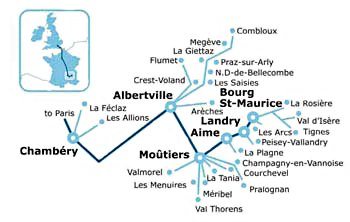
Light blue lines = bus or taxi transfers from rail stations.
London to Corsica
Corsica is a fantastic destination, with Mediterranean beaches, great mountain scenery and excellent hiking opportunities (check out the GR20 walking route across the island!). Corsica doesn't get overcrowded either, even in summer. The Corsican tourist office website is www.visit-corsica.com .
UK to Corsica without flying? No problem! Just take Eurostar and a high-speed TGV or overnight couchette train from London to the south of France, then a ship or fast ferry across the sunny Mediterranean to Corsica.
Two ferry companies, Corsica Linea ( www.corsicalinea.com ) & Corsica Ferries ( www.corsica-ferries.co.uk ), sail from Marseille, Toulon or Nice on the mainland to Bastia, Ajaccio on Corsica. There are also ferries from Italy (Savona & Livorno, www.moby.it ). The crossing from Nice to Bastia takes 5½ hours by comfortable ship. There are daily overnight ferries from Marseille & Toulon to Ajaccio & Bastia with comfortable cabins. Here are two suggested ways to reach Corsica, though naturally they aren't the only options:
London to Corsica, via overnight ferry from Marseille
Step 1, travel from London St Pancras to Marseille St Charles , see the train times above .
Check ferry times first, make sure you have several hours ion hand in Marseille, if necessary stay overnight. Book these trains as shown above .
On arrival at Marseille St Charles station , either take a taxi to the Corsica Linea (formerly SNCM) ferry terminal, or use the Marseille Metro ( www.rtm.fr ) from St Charles station 2 stops to Place de la Joliette, you want line 2, direction Bougainville, and the fare is around €1.80. Place de Joliette metro station is just 50m from the entrance to the ferry terminal. You can walk from the station to the ferry terminal via Marseille's famous Vieux Port, but it's a fair old way and not an attractive or easy walk once past the Vieux Port.
Step 2, sail from Marseille to Ajaccio or Bastia, Corsica's first and second cities respectively.
Corsica Linea ( www.corsicalinea.com , successor to defunct state-owned SNCM) sails overnight daily to both cities. Sailing times vary, but the ship usually sails from Marseille at around 19:00-21:00 arriving Bastia or Ajaccio around 07:00-08:00. Cabins have en suite toilet & shower, and even satellite TV if you don't mind watching Midsomer Murders in French!
The best way to book the ferry is online at www.corsicalinea.com , you simply print out your own ticket and show it at the port, or you can book most ferry routes & operators to Corsica on the Seat61 online ferry booking page . Alternatively, you can book by phone with their UK agent, Southern Ferries, on 020 7491 4968.
In the return direction, there are daily overnight ferries from both Ajaccio & Bastia to Marseille. Allow at least 2 hours next morning to make the connection in Marseille, then choose one of the TGV and Eurostar services from Marseille to London shown above . You'll arrive in St Pancras in the early evening, less than 24 hours after leaving Corsica.
London to Corsica, via Corsica Ferries' afternoon sailing from Nice
Step 1, travel from London to Nice by daytime trains and spend a night and morning in Nice. See the train times & fares above , and book the trains online as shown above . Spend the morning exploring Nice. At lunchtime, walk or take a taxi past the Old Town and around the headland to Nice's old port from where the ferries leave.
Step 2, Corsica Ferries ( www.corsica-ferries.co.uk ) have a more or less daily afternoon sailing from Nice to Bastia, and on some days another one to Ajaccio, leaving Nice around 14:00-15:00 and arriving in Bastia or Ajaccio around 19:30-20:30 (all on day 2 from London). Top tip: Even though it's a daytime ferry, spend an extra €30 on a private day cabin, so you can snooze, take a shower and freshen up. Corsica Ferries ships are modern and very comfortable. The easiest way to book the ferry is online at www.corsica-ferries.co.uk , you simply print out your own ticket and show it at the port, or you can book most ferry routes & operators to Corsica on the Seat61 ferry booking page . The price varies depending on the season.
In the return direction there's normally a morning sailing from Bastia (and on some days Ajaccio) to Nice, leaving around 08:00. Stay overnight in Nice then travel to London via Paris or via Lille, see the train times & fares above .
Holidays from the UK to Corsica, by train & ferry
If you'd rather leave all the organisation to someone else, rail travel specialists www.railbookers.co.uk (0207 864 4600) can tailor-make a holiday to Corsica by train & ferry for any length of time, leaving on any date you like, using a variety of train & ferry options.
Byway ( Byway.travel ) is a UK-based eco-holiday firm with a 5-star TrustPilot rating , they can also sort a holiday to Corsica by train not plane, and customise it to your own requirements. Byway includes package protection, a 100% Covid refund guarantee, free disruption and re-planning and on-demand WhatsApp support while you're away. They can build a trip to your requirements if you email them or use this contact form . Please say you heard about them from Seat 61.
Train travel in Corsica: Ajaccio, Corte, Bastia, Ile Rousse, Calvi...
A delightfully scenic narrow-gauge train links Bastia, Ponte Leccia, Corte, Vizzavona & Ajaccio (four trains per day), with a branch from Ponte Leccia to Ile Rousse & Calvi (two trains per day). The line winds right up through Corsica's dramatic central mountains, which explains why the 152km from Ajaccio to Bastia takes 3½ hours! Highly recommended, although it can get hot and crowded in summer. It's run by French Railways (SNCF) though is branded CFC - Chemins de Fer de la Corse. For a route map and timetables, see official site cf-corse.corsica or unofficial site Chemins de Fer de la Corse . You may find more up-to-date timetables, as well as bus timetables, at independent website www.corsicabus.org . Nw air-conditioned trains with panoramic windows are now in service, linking Bastia & Ajaccio in under 3 hours at up to 100 km/h even on Corsica's narrow metre-gauge tracks.
London to other destinations in France
You can get to just about anywhere in France by train from London. Dijon, Reims, Clermont Ferrand, Versailles, Orleans, Blois, and so on.
Go to www.raileurope.com or www.thetrainline.com .
You can book from London to your final destination in one go. Look for journeys with an easy-same-station change in Lille if there are any shown. If you are offered this option, it's simpler than crossing Paris.
However, for journeys via Paris, it's often better to split the journey in Paris as follows. This is so you can allow longer in Paris for a meal, or if an earlier Eurostar has cheaper fares available, it also allows you to avoid some sub-standard 40-minute cross-Paris connections which have unfortunately been pre-programmed into SNCF's database. I recommend nothing less than 60 minutes for any cross-Paris connection between Paris Nord and Paris Gare de Lyon.
Step 1, book from Paris to your final destination at www.thetrainline.com . Step 2, allowing at least 60 minutes to cross Paris southbound, 90 minutes northbound (as this includes the 30 minute Eurostar check-in), book from London to Paris and back at www.eurostar.com . You can choose an exact seat on Eurostar if you book this way too, see tips on choosing a seat here .
Pass or point to point?
Let's be clear, a pass will not save money over the cheaper point-to-point advance-purchase fares you normally see when booking a few months ahead. But when point-to-point fares are expensive (for example, at short notice) OR you want flexibility, for example the ability to change your mind, re-route or reschedule at will, you can travel from anywhere in the UK to anywhere in France & back using an Interrail pass.
If flexibility is what you want, buy the pass. If it's about saving money, you'll have to check point-to-point prices and do the maths.
It's worth doing the maths if you are under 28, if you have kids (kids get a free pass when accompanying an adult but still need to pay reservation fees) or if you live a long way from London (as a pass covers you from your home station to London).
Passes are available in 1st & 2nd class. By all means go out one way, back another, with an Interrail pass you can use almost any of the trains & routes shown on this page. For a tour of France, an Interrail pass is less risky than stack of inflexible advance-purchase tickets.
How to use a pass for a trip to France
Step 1, buy a 4-days in 1-month Interrail pass from www.raileurope.com (click Rail passes and select Europe ) or www.interrail.eu for €283 adult, €212 youth or €255 senior. You load the pass into the Railplanner app on your phone. See pass prices on the Interrail page .
4 days is the shortest pass period available, it's sufficient to get from almost anywhere in mainland Britain to anywhere in France & back. By all means buy a longer period pass for a more extensive trip.
A 4-day pass gives you unlimited train travel on any 4 dates you choose in an overall 1 month period. The first travel day can be any date you select in the 11 months after buying the pass. The 1 month period starts from that date. Learn about how Interrail passes work here .
Incidentally. you're only allowed 2 days of travel in your home country. Eurostar counts as travel in Britain for us Brits. So if (for example) you wanted to go Inverness to Nice, you have to go Inverness to Paris on the first day and Paris-Inverness on your last day. You can't stop overnight in London as that would clock up 4 days travel in Britain and you're only allowed 2. More about inbound/outbound days here .
Step 2, you need to buy a Eurostar passholder ticket from London to Lille or Paris & back for €30 each way. See prices & how to make Eurostar passholder reservations . Tip: Eurostar passholder availability is limited, so check availability before buying a pass .
Step 3, you need a reservation for each high-speed TGV or Intercité you take in France and for couchettes on Intercités de nuit , see prices here . You can make these reservations online using the official Interrail reservation service . Interrail is not valid on Ouigo lo-cost trains .
The Train Bleu restaurant , Gare de Lyon
I highly recommend eating at the famous and remarkable Train Bleu restaurant inside the Gare de Lyon, on the main concourse, see the Train Bleu restaurant page for more details .
Or at the Gare du Nord, the Brasserie Terminus Nord
If you'd like a decent meal near the Gare du Nord rather than the Gare de Lyon, try the typically French Brasserie Terminus Nord ( www.terminusnord.com ), directly across the road from the front of the Gare du Nord. It's good quality French cuisine in classic Parisian brasserie surroundings, famous for its oysters and seafood. Main dishes cost around €18-€24.
Holidays, breaks & tours by train
Short breaks to paris or lille.
Plenty of companies offer combined Eurostar+hotel deals for an economical short break in Paris or Lille. There are times when a combined Eurostar+hotel offer can be cheaper than a normal Eurostar ticket! Try:
www.eurostar.com - Eurostar's own short break packages to Paris & Lille
www.railbookers.co.uk - tailor-made breaks to Paris and cities all over France
www.lastminute.com - short breaks to Paris
www.greatrail.com - 5-day escorted short breaks to the Champagne region, to the Dordogne, to the Chateaux of the Loire or to Strasbourg & Alsace, all overland by train from the UK, from around £695-£795.
Railbookers, railbookers.co.uk
Railbookers can tailor-make a flight-free holiday or short break to France for you, with train travel, transfers & hotels included, leaving on any date you like. For example, they offer a 2-night break to Avignon or a 6-night holiday to Nice & Cannes with daytime train travel by Eurostar & TGV. If you tell them what you want, they'll advise you on the best trains, routes & hotels and sort it all out for you. They get a lot of repeat business!
Byway, byway.travel
Byway ( byway.travel ) is a new UK-based eco-holiday firm with a 5-star TrustPilot rating . If you're nervous about booking train travel yourself, they'll book a London-Italy journey for you as a package, including overnight hotels, starting from any British station you like.
Great Rail Journeys, greatrail.com
Rail discoveries, raildiscoveries.com, car hire comparison: www.carrentals.co.uk.
The award-winning website www.carrentals.co.uk compares many different car hire companies including Holiday Autos, meaning not only a cheapest price comparison but a wider choice of hire and drop off location.
European Rail Timetable & maps

Rail Map Europe is the map I recommend, covering all of Europe from Portugal in the west to Moscow & Istanbul in the east, Finland in the north to Sicily & Athens in the south. Scenic routes & high-speed lines are highlighted. See an extract from the map . Buy online at www.europeanrailtimetable.eu (shipping worldwide) or at www.amazon.co.uk (UK addresses).
Click the images to buy at Amazon.co.uk
Alternatively, you can download just the chapters or areas you need in .PDF format from the Lonely Planet Website , from around £2.99 or US$4.95 a chapter.
Hotels in France
A special hotel for a short break in paris.
There are the obvious choices such as the famous (and expensive) Paris Ritz in the Place Vendôme, founded by the Swiss hotelier César Ritz & French chef Auguste Escoffier in 1898. Anyone who's anyone has stayed here, from Hemingway to Princess Diana.
And the equally famous & expensive Le Meurice , which Von Choltitz made his headquarters during the occupation of Paris in WW2. It was at Le Meurice where Von Choltitz took the call from his Führer demanding to know " Is Paris burning?"
But if for a special hotel for a luxury break or romantic weekend, I'd recommend the small, sumptuous, intimate L'Hotel , on the bohemian left bank, walking distance from the Seine, the Ile de la Cité & Notre Dame.
Playwright Oscar Wilde spent the last days of his life here in room 16, famously quipping, "My wallpaper and I are fighting a duel to the death. One or the other of us has to go.". Fortunately the wallpaper is now all in very good taste (Mrs 61 & I had to room next to Oscar's). The hotel has been used by many famous people since then, from Sinatra to Mick Jagger. Rooms are on the cosy side, but they are beautifully decorated and have character that bigger and flashier hotels lack. Check prices & book a stay at l'Hotel .
Hotels near Paris stations
Hotels close to the gare du nord.
The 25 Hours Terminus Nord would be my first choice for a stay between trains, a big 3-star hotel directly across the road from the Gare du Nord. Formerly the Mercure Terminus Nord, it's been refurbished in a decidedly funky style and gets great reviews - I've had great feedback from Seat61 users too.
The Libertel Gare du Nord Suede is 5 min walk from Gare du Nord, 2-star.
You could also try the Art Hotel (3-star); Avalon Hotel (2-star); Hotel Cambrai (5 min walk from Gare du Nord, 1-star).
Hotels close to the Gare de l'Est
The Libertel Gare de l'Est Français is directly opposite the station, 3-star;
The OKKO Hotels Paris Gare de l'Est is alongside the station, on the side closest to the Gare du Nord,
Libertel Gare du Nord Suede is 350m from the Gare de l'Est, 2-star;
Hotels close to the Gare de Lyon
The Mercure Paris Gare De Lyon is part of the station complex itself, ideal if you've an early train next morning. It receives over 8/10 in reviews for staff, comfort & cleanliness. It gets less than 8 for facilities and room size, but that's not as important for one night between trains.
The Citizen M Hotel gets great 8/10 or better reviews on all counts, close to 9/10 on some and I've had great feedback from seat61 users too. It's 160m 2-minute walk from the station. 4-star.
Also try the Hotel Terminus Lyon (right in front of the station, 3-star); Novotel Paris Gare de Lyon (opposite the station, 4-star); Hotel 26 Faubourg (5 min walk from Gare de Lyon, 2-star).
There aren't many cheap places around the Gare de Lyon, try the Hotel Ibis Styles Gare de Lyon across the road. If you're prepared to walk a bit, try the Libertel Austerlitz Jardin des Plantes as this is significantly cheaper but still with a 8+ review score, a 13-minute walk across the river Seine past the Gare d'Austerlitz.
Hotels close to the Gare Montparnasse
The Mercure Paris Gare Montparnasse is 150m from the Gare Montparnasse, 4-star;
The Best Western Sevres Montparnasse is 15 minute walk from the Gare Montparnasse, 3-star;
La Maison Montparnasse is 10 min walk from the station, 2-star;
The Hotel du Maine is 5 min walk from the station, 2-star.
Entrance to the Mercure Hotel at the Gare De Lyon , right next to the station's famous clock tower. Handy for early trains!
Backpacker hostels: www.hostelworld.com
www.hostelworld.com : If you're on a tight budget, don't forget about backpacker hostels. Hostelworld offers online booking of cheap private rooms or dorm beds in backpacker hostels in Paris and most other European cities at rock-bottom prices.
Travel insurance & other tips
Always take out travel insurance.
You should take out travel insurance with at least £1m or preferably £5m medical cover from a reliable insurer. It should cover trip cancellation and loss of cash & belongings up to a reasonable limit. These days, check you're covered for covid-19-related issues, and use an insurer whose cover isn't invalidated by well-meant but excessive Foreign Office travel advice against non-essential travel. An annual policy is usually cheapest even for just 2 or 3 trips a year, I have an annual policy with Staysure.co.uk myself. Don't expect travel insurance to bail you out of every missed connection, see the advice on missed connections here . Here are some suggested insurers, I get a little commission if you buy through these links, feedback always welcome.
Get an eSIM with mobile data package
Don't rely on WiFi, download an eSIM with a European mobile data package and stay connected. Most newer mobile phones can download a virtual SIM including iPhone 11 & later, see device compatibility list . There's no need to buy a physical SIM card! Maya.net is a reliable eSIM data retailer with a 4.5 out of 5 Trustpilot rating and a range of packages including unlimited data .
Get a Curve card for foreign travel
Most banks give you a poor exchange rate then add a foreign transaction fee on top. A Curve MasterCard means no foreign transaction fees and gives you the mid-market exchange rate, at least up to a certain limit, £500 per month as I write this. The money you spend on your Curve card goes straight onto one of your existing debit or credit cards. And you can get a Curve card for free.
How it works: 1. Download the Curve app for iPhone or Android . 2. Enter your details & they'll send you a Curve MasterCard - they send to the UK and most European addresses. 3. Link your existing credit & debit cards to the app, you can link up to two cards with the free version of Curve, I link my normal debit card and my normal credit card. 4. Now use the Curve MasterCard to buy things online or in person or take cash from ATMs, exactly like a normal MasterCard. Curve does the currency conversion and puts the balance in your own currency onto whichever debit or credit card is currently selected in the Curve app. You can even change your mind about which card it goes onto, within 14 days of the transaction.
I have a Curve Blue card myself, it means I can buy a coffee on a foreign station on a card without being stung by fees and lousy exchange rates, just by tapping the Curve card on their card reader. The money goes through Curve to my normal debit card and is taken directly from my account (in fact I have the Curve card set up as payment card on Apple Pay on my iPhone, so can double-click my phone, let it do Face ID then tap the reader with the phone - even easier than getting a card out). I get a little commission if you sign up to Curve, but I recommend it here because I think it's great. See details, download the app and get a Curve card , they'll give you £5 cashback through that link.
Get a VPN for safe browsing. Why you need a VPN
When travelling you may use free public WiFi which is often insecure. A VPN encrypts your connection so it's always secure, even on unsecured WiFi. It also means you can select the geographic location of the IP address you browse with, to get around geoblocking which a surprising number of websites apply. See VPNs & why you need one explained . ExpressVPN is a best buy with a 4.7 out of 5 Trustpilot ranking which I use myself - I've signed up as an ExpressVPN affiliate, and if you go with expressvpn.com using this link you should see a special deal, 3 months free with an annual subscription. I also get some commission to help support this site.
Carry an Anker powerbank
Tickets, reservations, hotel bookings and Interrail or Eurail passes are often now held on your mobile phone. You daren't let it run out of power, and you can't always rely on the phone's internal battery or on being near a power outlet. I always carry an Anker powerbank which can recharge my phone several times over. Buy from Amazon.co.uk or Buy from Amazon.com .
Touring cities? Use hill walking shoes!
One of the best things I've done is swap my normal shoes for hill-walking shoes, in my case from Scarpa. They're intended for hiking across the Pennines not wandering around Florence, but the support and cushioning for hiking works equally well when you're on your feet all day exploring foreign cities. My feet used to give out first and limit my day, now the rest of me gives up before they do!
Back to home page
Home Explore France Official Tourism Board Website
- Explore the map
Travel by train
Inspiration
Reading time: 0 min Published on 27 January 2024, updated on 27 January 2024
Holidays at Galeries Lafayette

Air France, the best and most comfortable way to get to France

French Wine Tasting with Duclot La Cave

Gift vouchers for your shopping at Galeries Lafayette

The Christmas Windows Display and Characters

A Fairy Tale 1, 2, 3 Christmas!

8 Luxurious Boutiques in Paris

A historical and cultural melting pot in French Polynesia
Tahiti-French Polynesia

- Search Please fill out this field.
- Manage Your Subscription
- Give a Gift Subscription
- Newsletters
- Sweepstakes
- Hotels + Resorts
Europe's Most Spectacular New Hotel Is Set in a Former WWII Railway Station
High in the mountains between Spain and France, a long-neglected train station has become an opulent hotel.
Simon Willis is a contributing writer for Travel + Leisure. For the magazine he has crisscrossed Europe, Asia and Latin America. Particularly drawn to remote places, he has filed features from Patagonia, Laos and the Southern Ocean among other destinations.
Denisse Ariana Pérez
A few years ago , I was flicking through a magazine when I saw a photo essay about abandoned train stations. They were images of sublime squalor. The grand Greco-Roman columns of Michigan Central Station in Detroit were covered with graffiti. The Art Deco posters on the walls of the St.-Martin Métro in Paris were gradually peeling away. But the most haunting place in the collection was Estación Canfranc, high in the Spanish Pyrenees.
From the outside, this 790-foot-long Beaux-Arts palace looked like it had been transplanted from a fashionable Parisian boulevard. When it was completed in 1925, Canfranc was the second-largest rail station in Europe, after the one in Leipzig, Germany. Inside, the structure had cathedral-like proportions, as though it had been erected not merely to facilitate train travel but to worship it. Huge arched windows let in shafts of beneficent light. The ticket counter could almost pass for an altar. But by the time the photo essay was published, the congregation was long gone. The building closed in 1970 and had been empty ever since. Its vaulted ceiling was slowly moldering, and the floor was covered in dust and debris.
Related: This Little-known Wine Region Is a Hidden Gem of Spain — and It Has a Gorgeous New Luxury Hotel
Now the travelers are back. One recent afternoon I arrived in Canfranc to check in to the station, which has been transformed into one of Europe’s most spectacular new hotels. Its scale and grandeur are incongruous, given that Canfranc is a remote mountain hamlet near the border of Spain and France. The town, which sits in a narrow valley enclosed by steep, forested slopes, has a population of only 600.
After the station closed, Canfranc lured only a trickle of adventure lovers, drawn by glorious summer hiking and two tiny ski resorts farther up the valley. But today, the hotel is a destination in itself. The renovation is the work of the Barceló Hotel Group, who took over the derelict building in 2021. The Spanish firm has given the place a train-centric revamp that balances old-world glamour with contemporary style. As I checked in, I stood gaping at the old ticket hall, which now serves as the hotel lobby. Its polished wooden beams shone with a deep luster, and the ornate plasterwork on the walls was as clean and white as confectioner’s sugar.
When it was completed in 1925, Canfranc was the second-largest rail station in Europe, after the one in Leipzig, Germany. Inside, the structure had cathedral-like proportions, as though it had been erected not merely to facilitate train travel but to worship it.
In the station’s locomotive heyday, its north and south wings were occupied, respectively, by French and Spanish customs officials. Now the southern wing houses a bar and restaurant tricked out in Art Deco shades of green and gold; the bar is illuminated by pendant lamps that resemble train wheels. In the rooms, antique station windows have been refurbished as quirky wall art.
Yet the hotel’s brand of nostalgic luxury is only one reason to visit; the other is its history. The village of Canfranc may be tiny and remote, but its border location has given it an outsize strategic importance for centuries. The evidence is everywhere. After I arrived at the hotel I headed outside and looked north up the valley. Perched on a ridge high above me was a 16th-century fortress that the Spanish rebuilt after Napoleon’s invasion in 1808; they wanted to defend against another possible incursion through this mountain pass. At the other end I could see concrete bunkers, erected for the same reason by the Franco regime in 1944. As well as being a luxurious stop on the route between Paris and Madrid, the station has played a prominent role in the valley’s history of intrigue and espionage.
Later that afternoon, I met with Ana Badino and Marcelo Boveri, an Argentine couple who moved from Madrid to the Canfranc region in 2020 to enjoy a quieter life in the mountains. Since then, they have immersed themselves in the station’s extraordinary history and now run tours around the valley.
Until the 20th century, this corner of northern Spain was seen as poor and backward. The main economic activity was smuggling: alcohol and cigarettes went from Spain to France, and clothes, clocks, tea, and embroidery went the other way. But the locals wanted more opportunity than contraband provided, and the government wanted to take this roguish part of the country and turn it into a legitimate, modern commercial hub. So in 1912, the government commissioned the station as a statement of ambition and advancement. Fernando Ramírez de Dampierre, a Madrid-born engineer, was hired to design it. Both the president of France and the king of Spain were present at the inauguration ceremony in 1928.
For a few years, life in Canfranc was full of commercial activity. Daily trains from Portugal delivered port wine, cocoa, and coffee imported from Brazil. Industrial goods like coal and aluminum arrived from France. Badino and Boveri pointed out the rusted, obsolete cranes behind the station; they once loaded and unloaded this cargo.
But when war broke out in 1939, everything changed. As Bodina and Boveri explained, the head of the station’s French customs department was a man named Albert Le Lay. He was more than a mere border official. He was a vital member of the French resistance who used his position at the station to help Jews and allied fighters fleeing persecution and capture in Germany and Vichy France. Now remembered as an Oskar Schindler–like figure, Le Lay provided these fugitives with forged papers to help them cross into Spain and on to Portugal. From there they traveled to safety. The identities of Le Lay’s beneficiaries are hard to trace, but according to some historians, those who passed through Canfranc included Max Ernst and Peggy Guggenheim.
Bodina and Boveri led me a little farther down the valley, which is still crisscrossed by old railway lines. Eventually we came to a row of derelict warehouses, their heavy wooden doors bent and buckled from decades of neglect, their roofs full of holes where high winds had ripped the tiles away. Through the gaps we peered into the dark interiors. In one of the buildings, in 2000, a cache of Nazi paperwork was found that listed items the Germans had moved through Canfranc after the Gestapo occupied the station in 1942. They included looted gold bars and opium.
His job as a customs official gave Le Lay the cover he needed to continue his resistance work. He would receive information from agents masquerading as passengers as they arrived at the station. From there, messages were transported by a network of spies down the train line to Zaragoza, the nearest city. Canfranc, then, was a crucial node in a pan-European network of spies that helped disrupt the German war machine.
Like many travelers to Canfranc today, I arrived via the airport in Zaragoza, the regional capital. Zaragoza is an underrated destination compared with Barcelona, Madrid, and Seville. Following the Umayyad invasion from North Africa in the eighth century, it became a major city in the north of Muslim Spain. At its center is a Moorish fortress, the Aljafería Palace, which is built in a magnificent architectural fusion of European and Islamic styles known as Mudejar. On the bank of the Erbo River, which courses through Zaragoza, stands a monumental Baroque basilica whose central dome is surrounded by four towers. But for me, the biggest lure was the opportunity to admire the art of the area’s most famous son, Francisco Goya.
After spending the night at the NH Collection Gran Hotel de Zaragoza, I walked over to the Goya Museum. It’s a small institution that packs a big punch. The star attractions are Goya’s etchings, displayed in a large, crepuscular room that protects these delicate artworks from light damage.
Goya’s etchings rank among his strangest and most personal pieces. “Los Caprichos,” a series of 80 prints, is a pitch-black satire on religious hypocrisy, corruption, and superstition. These images feature grotesque goblins dressed as clergymen; a donkey in an aristocrat’s silk coat studying his family tree; a woman pulling teeth from the mouth of a hanged man to be used as lucky charms. In another series, “The Disasters of War,” the devilish comedy of “Los Caprichos ” is replaced by documentary horror. The etchings captured the violence of conflicts like the Peninsular War, which ravaged Spain between 1808 and 1814.
From Zaragoza I drove two hours across the tinder-dry plains of northern Spain to Jaca, a compact city with a Romanesque cathedral. It dates from the 11th century, when the king of Aragon decided to turn his territory into a stopping point for pilgrims on their way to Santiago de Compostela, 500 miles to the west. Pilgrimage was good business: you had to be wealthy to take several months off work and pay your way across Europe. Jaca did well from the foot traffic. In the Middle Ages, the road outside the cathedral passed 16 shoe shops.
Related: How To Plan the Perfect Trip To Madrid
After a meal of venison carpaccio at a small restaurant, La Cocina, I drove into the mountains to Canfranc. Having been cooped up in the car, I wanted to explore the landscape, so the following morning I met up with Fernando Garrido, a wiry mountain guide with silver hair and a deep tan. Garrido, a partner in a Jaca-based company, Aragon Aventura, is a serious mountaineer. For 30 years he has held the world record for spending the most time at high altitude: he stayed, alone, for two months straight on the summit of Mount Aconcagua, in Argentina, at an altitude of more than 22,000 feet.
Thankfully, our plan was more down to earth. It was a blue and shimmering Sunday, and we decided to head to Ordesa & Mount Perdido National Park, a 90-minute drive southeast of Canfranc. We hiked into a deep canyon, following the course of a river that had been reduced to a slow trickle by a two-month drought. The canyon’s sheer limestone walls rose almost 3,000 feet, and birds of prey circled on the thermals.
Yet the hotel’s brand of nostalgic luxury is only one reason to visit; the other is its history. The village of Canfranc may be tiny and remote, but its border location has given it an outsize strategic importance for centuries. The evidence is everywhere.
As we walked, Garrido pointed out the fajas, the narrow paths that run along the cliff edges. Looking at the thin lines they traced across the rock, I couldn’t help thinking about those wartime refugees I had heard about in Canfranc. During the German occupation, the route became more perilous, and despite Le Lay’s help, many were arrested at the station. In hopes of avoiding the authorities, thousands walked across the Pyrenees on foot, clinging to these narrow, cliff-edge paths as they searched for safety.
That night, I sat down to dinner at Canfranc Estación’s Restaurant Internacional, which is run by Eduardo Salanova and Ana Acín. Chef Salanova’s food is a fusion of local ingredients and avant-garde presentation. That evening’s 15-course tasting menu included foie gras with strawberries, local caviar, a terrine poached in mulled wine, and sous-vide eggs. (Another restaurant, Canfranc Express, opened after my visit in a restored train car outside the hotel, and has since been awarded a Michelin star.)
As I ate, a fog descended over the valley and a gentle rain began to fall. Through the window I could see the silhouettes of Canfranc’s old cargo warehouses and, beyond them, the wooded hillsides. Sitting there in the warm glow, I thought back to the stories my Argentine guides had told me — about the secret agents running messages through this building, about the villagers sewing notes into the linings of their clothes to protect them from the Gestapo. The setting was worthy of a wartime spy thriller, and as I sat in the opulent dining room I imagined myself waiting not for my dessert to arrive but for a tap on the shoulder from a clandestine contact bearing important papers and, along with them, a chance of freedom.
Where to Stay
Canfranc estación, a royal hideaway hotel.
This spectacular mountain hotel is worth a trip in itself. Tours of the property and the surrounding valley can be arranged through the concierge.
NH Collection Gran Hotel De Zaragoza
Previous guests at this imposing hotel in the center of town include Walt Disney and Ernest Hemingway. Stop by the excellent restaurant, La Ontina, for seasonal dishes like braised white asparagus.
Where to Eat
Jaca la cocina.
A small but stylish restaurant in Jaca that serves regional dishes like venison carpaccio and olla jacetana, a stew of beans and pork.
Aragon Aventura
Fernando Garrido, my hiking guide, co-owns this Jaca-based adventure company . He offers walking excursions as well as a range of other mountain activities, including canyoning and snowshoeing.
Goya Museum
This small museum in Zaragoza has the world’s finest collection of Goya’s etchings.
Pirineo Esencial
Knowledgeable guides Ana Badino and Marcelo Boveri offer tours of Canfranc and the surrounding valley .
A version of this story first appeared in the May 2024 issue of Travel + Leisure under the headline "Full Speed Ahead."
Related Articles

VIDEO
COMMENTS
SNCF - For all of us. At SNCF, we're fighting for sustainable mobility—for everyone, in every corner of France—with openness, efficiency and commitment. Your gateway to the latest offers and news from SNCF, a global leader in passenger mobility and freight logistics.
The TGV Train network (Train a Grande Vitesse) runs to major cities in France and Europe.; Intercites trains cover many of the medium distance routes between cities like Amiens, Orleans, Bordeaux, Caen, Lyon, Reims, Troyes, Toulouse, and Paris. They link cities in French regions like Nantes, Bordeaux, and Lyons-Nantes-Tours. TER is the French regional service running from towns and villages ...
Eurostar trains to France. With Eurostar tickets to suit every budget and trains leaving for Paris throughout the day, start your escape in London and arrive rested and raring to go, right in the heart of the action. The perfect place for romantic strolls or extravagant sprees, Paris is hard to beat for a weekend break.
Eurostar trains to France. With Eurostar tickets to suit every budget and trains leaving for Paris throughout the day, start your escape in London and arrive rested and raring to go, right in the heart of the action. The perfect place for romantic strolls or extravagant sprees, Paris is hard to beat for a weekend break.
How to travel France by train—tips for buying French train tickets and advice for navigating France by rail. Transportation. August 31, 2023 Share Post It doesn't get much better than zooming through the French countryside at 200mph. In fact, when it comes to train travel, France is one of the best-connected countries in Europe and you can ...
TGV, the high-speed rail service which links together the major cities of France like Lyon, Bordeaux and Marseille. With TGV, you can go to more than 230 destinations in France and Europe. If you want to learn more about TGV routes and other fast trains across the continent, visit our high-speed trains in Europe page.
Travel on a high-speed train to France. Catch a Eurostar service to Paris or Lille from London and travel onwards in one of SNCF's Train à Grande Vitesse (TGV) trains to Rennes, Strasbourg, Lyon, Dijon, Toulouse or even to the French Riviera. Watch the French countryside roll by at 186mph with a glass of wine in hand.
Download the SNCF Connect app for faster, easier and cleaner mobility across France. With one touch, you can organise, book and manage your day-to-day trips as well as long-distance trips. Travel with peace of mind, and find all the information you need during your trip: e-tickets, real-time timetables, live traffic information...
With TGV INOUI, travel at high speed up to 320 km/h to France aboard a train with optimal comfort, ideal whether you are on a leisure or a professional trip. Enjoy free wifi to France: access content and services on the TGV INOUI portal. Storage spaces for luggage are provided in each car to facilitate your boarding.
Expert tips for train travel in France. 1. Buy tickets early for the best price and availability. If you're looking to travel by train and know your plans well in advance, it pays to buy the tickets well in advance. You'll get the best price. Another reason why you'll want to book early whenever possible is because trains in France sell ...
Tips for train travel in France. Train options in France. Several different types of trains travel across France, including local and regional trains, overnight trains with sleeping accommodations and the TGV, the high-speed Trains à Grande Vitesse. To travel between most big cities, the TGV is your best bet: these pioneering high-speed trains ...
Train travel in France is an easy, affordable, and sustainable way to get around and see all that the county has to offer. There are over 1700 kilometers of high-speed train lines all over France. One of the best parts about traveling by train is the fact that there are stations in almost every city rather than only near the airports.
Paris to Nice, Lyon or Bordeaux from €25. The best way to travel between French town & cities is by train, in comfort at ground level. France's world-famous TGV travels at up to 199 mph, from city centre to city centre, and if you pre-book direct with the operator you can find some really cheap fares, too.
High-speed trains (TGV). TGV trains are the fastest trains in France, and tickets for them are available to purchase 90 days in advance. The prices for them continue to rise as the departure date approaches, so book them early for the lowest price. A ticket purchased 90 days in advance could cost €30.
4. TER (Transport Express Regional) TER trains are regional trains in France, usually referred to as local trains. They are ideal for getting between regional French towns and villages. Like long-distance trains, with TER trains, you can also travel first or second class, but this will change soon (a unique class).
Book a TGV. The TGV OUIGO is SNCF's low-cost option for high-speed travel. These double-decker trains travel at 300 km/h and consist of a single class (equivalent to second class), with tickets sold exclusively online. They are a great choice if you're looking for more affordable train tickets, as TGV OUIGO trains offer excellent value for ...
TGV, the high-speed rail service which links together the major cities of France like Lyon, Bordeaux and Marseille. With TGV, you can go to more than 230 destinations in France and Europe. If you want to learn more about TGV routes and other fast trains across the continent, visit our high-speed trains in Europe page.
Tickets between London and Paris/Lille/Brussels *$52 per person one way based on a mandatory return trip in Standard between London and Brussels-Midi/Zuid, Paris, Amsterdam, Rotterdam or Lille, for travel between 29/05/2024 and 02/10/2024. Subject to availability. Availability varies according to dates and times. Blackout dates may apply.
Yet still, for many visitors, the highlight of train travel in France is exploring rural routes with slower, regional express trains (TER for short) which meander from the likes of Paris to Provence, Lyon to the Loire or Brittany to Bourgogne. France has numerous train stations in major cities and towns.
Take a high-speed train to France. It's the civilised alternative to flying. Take Eurostar from London to Lille or Paris, then a 300 km/h TGV (Train à Grande Vitesse) through the French countryside with a glass of red wine to hand from Lille or Paris to Avignon, Marseille, Nice, Nîmes, Montpellier, Perpignan, Lyon, Bordeaux, Toulouse, Rennes or Nantes...
Prepare your journey. Recherchez un itinéraire. Consultez les horaires en gare. Recherchez un numéro de train. Consultez les informations sur le trafic. For all your travel in France and Europe, find your tickets here or in one of the 800 agencies approved by SNCF Voyageurs. Book your tickets here.
Getting to France by train; Traveling by bike. Accessibility. Sustainable labels. Transport. Practical Information Guide. Official Tourism Board Website. Menu. ... Travel by train. Inspiration. Reading time: 0 min Published on 27 January 2024, updated on 27 January 2024. See more.
If you're planning a trip and want to travel by rail, take a look our train map of France. It highlights some of the most popular routes across the country, including high-speed, regional and the major international routes. Click on each of the routes to find journey times and where to book your tickets. *Routes are subject to change ...
High in the mountains between Spain and France, a long-neglected train station has become an opulent hotel. Simon Willis is a contributing writer for Travel + Leisure. For the magazine he has ...
London to Paris by train. It takes an average of 2h 21m to travel from London to Paris by train, over a distance of around 212 miles (342 km). There are normally 16 trains per day travelling from London to Paris and tickets for this journey start from £51 when you book in advance. First train.